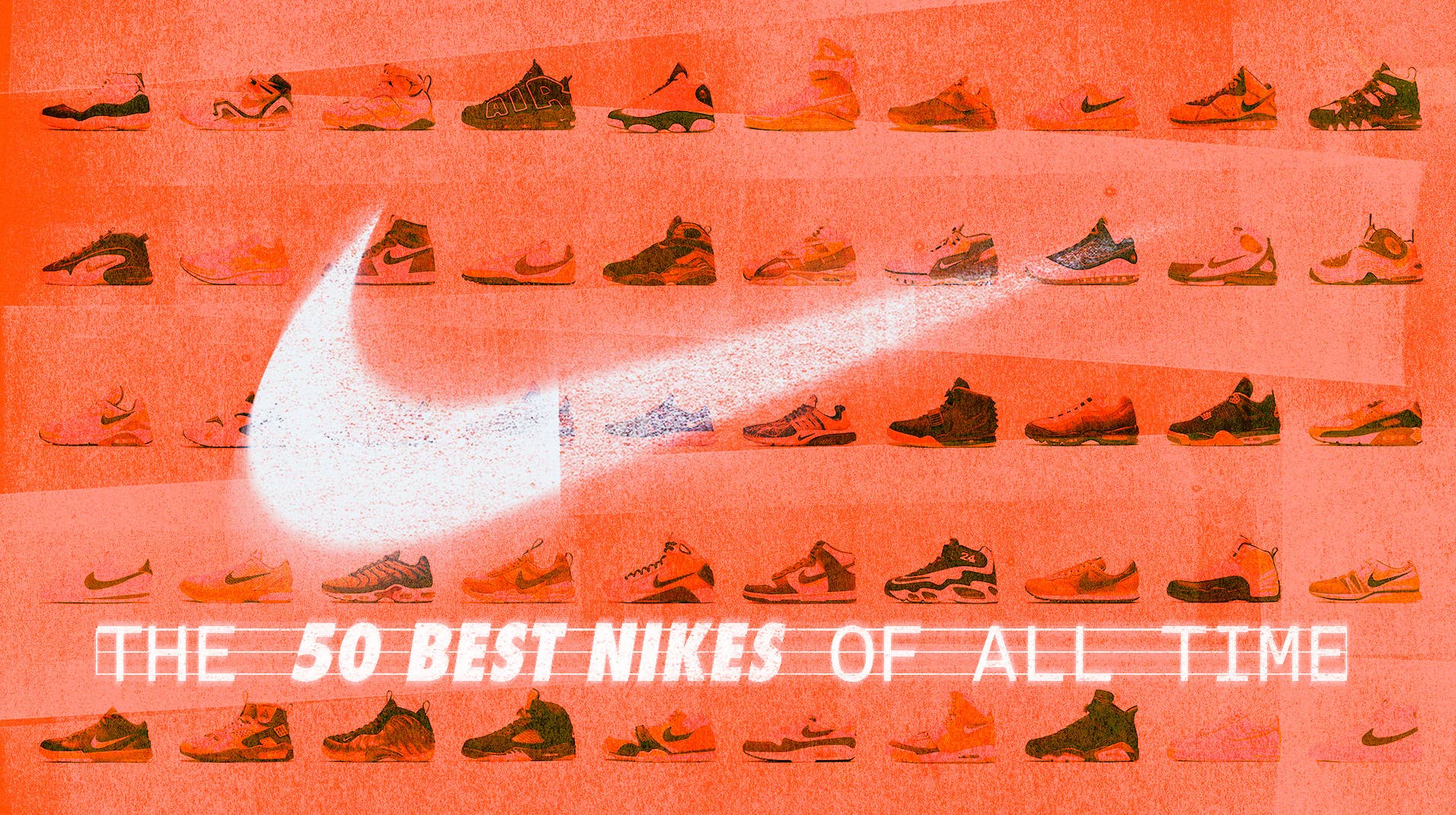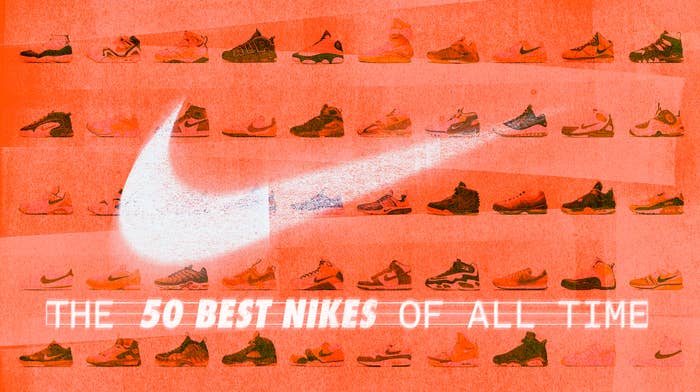
Nike just finished celebrating its 50th year in business and to mark the occasion, we’re looking back on the 50 best shoes that helped make the brand the industry titan it is today.
Nike is a company rooted in sport, but one that has transcended pop and street culture alike. Its sneaker catalog simply can’t be matched, with pairs that changed the way athletes performed and everyday people dressed. Through a combination of superstar endorsees, masterful design, groundbreaking technology, and clever marketing, Nike has produced some of the most memorable footwear of all time.
Whether it’s Tinker Hatfield’s Air Jordan 3 design, which essentially salvaged Michael Jordan’s relationship with the brand, or Eric Avar’s Zoom Kobe 4, a shoe that changed the way people played basketball, there are certain sneakers that were pivotal in the brand’s evolution thus far.
To celebrate five decades of the Swoosh, we look back on the sneakers—and the stories behind them—that contributed to its history. These are Nike’s most important and impactful shoes, the ones that shaped and continue to shape the brand’s legacy. They’re shoes that broke ground upon debuting and remain relevant through retro storytelling, both of which were considered when determining the rankings.
50. Nike Roshe
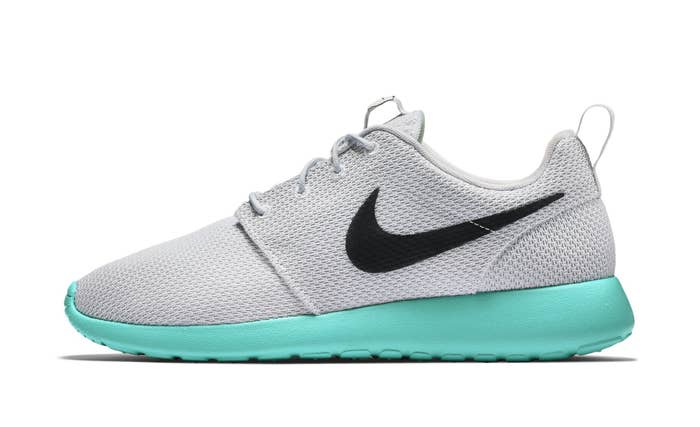
Year First Released: 2012
The Nike Roshe Run, the shoe’s original name when it debuted in 2012, wasn’t like much on the market at the time. The sole was a one-piece foam and the upper was an airy, loose-gauge mesh with a glued-on Swoosh. They came out in a few colors, spread by word of mouth, and were hard to find. Sneaker connoisseurs who were into trying something new suddenly had their interests piqued by the Roshe. Then in the second half of 2012, the Roshe got a broader release.
‘A few colorways started popping up at Foot Locker and the Roshe spread like wildfire. The once-niche model was now mainstream. The Roshe Run was odd, though. It had running in the name, but wasn’t a shoe designed to run in at all. Instead, Nike designer Dylan Raasch wanted it to be a design experiment to see what he could do at the $70 price point, he told How to Make It.
The budget-friendly price of the shoe made it a good alternative to the pricey Jordans, LeBrons, and Foams that dominated the sneaker market at the time. Then Nike tried to do a lot with the Roshe. They made it a high-top, made it with Flyknit, made it out of Tech Fleece, did a Roshe 2 in a Yeezy colorway and a Japanese exclusive cheetah print, and made millions of pairs and flooded the market with it. Then the Roshe got played out and Nike replaced it with other pricepoint shoes that didn’t resonate the same. Some people will scoff at Roshes, but those who were there from the beginning know how big the shoe’s impact was at the time. –Matt Welty
49. Nike Air Zoom Huarache 2K4
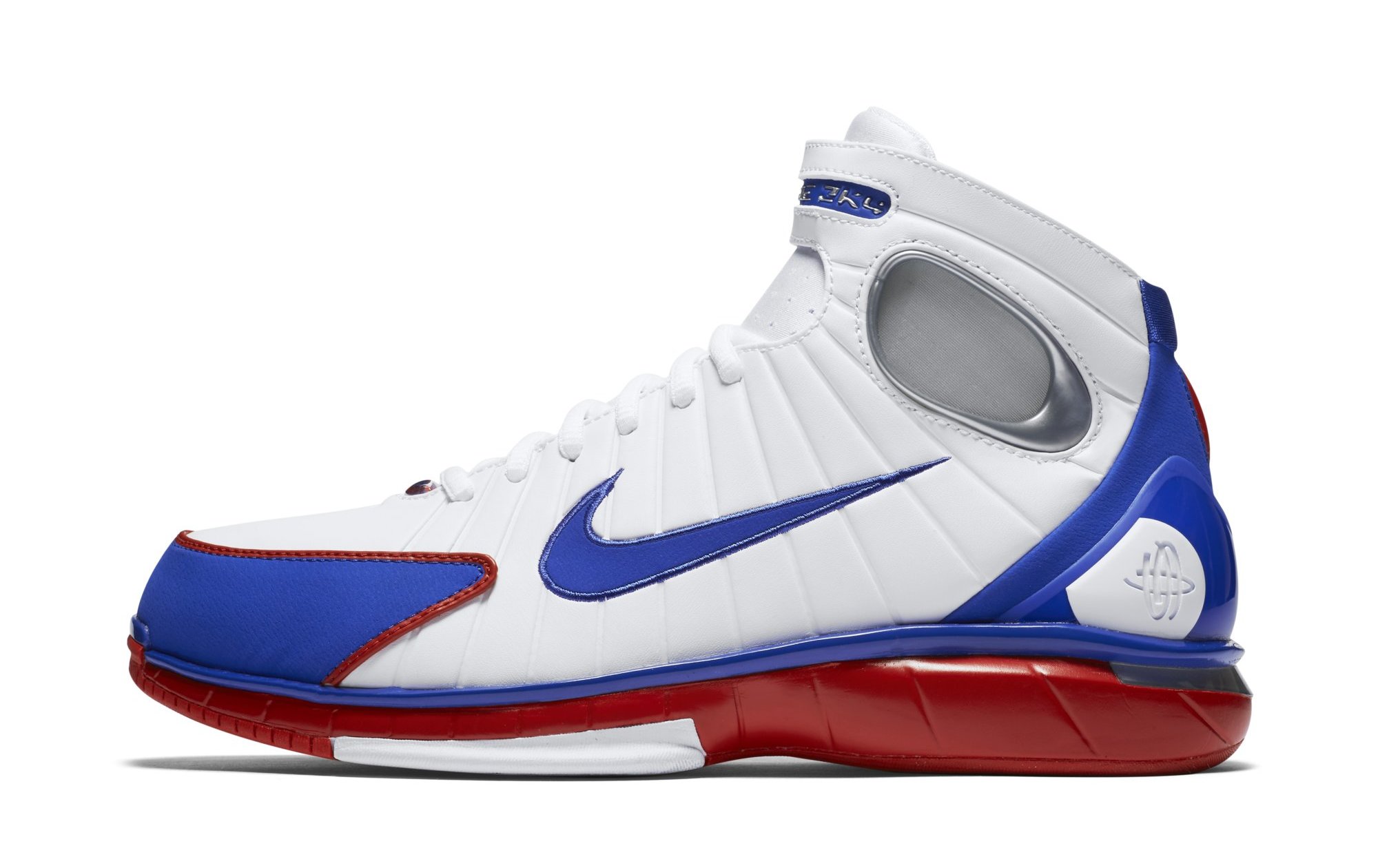
Year First Released: 2004
Before the official Nike Kobe line that redefined performance basketball footwear as we know it, we had the Huarache 2K4. The silhouette was the unofficial signature shoe of the late Kobe Bryant upon signing with Nike in 2003. Designed by Eric Avar, the model was a fresh take on 1992’s Air Flight Huarache that was meant to cater to the explosiveness and versatility of modern players like Bryant.
“That’s what I think separated the 2K4 from a lot of other shoes, how light it was and how well it performed. At the same time, it was very comfortable,” Bryant told Laced back in 2007.
While its physical appearance differs greatly from its design inspiration, the Huarache 2K4 maintains the same DNA with design elements like a neoprene inner bootie, exoskeleton upper, and cutouts at the ankle collar. New additions included a thin Velcro ankle strap, plastic heel counter for added lockdown, Zoom Air cushioning in the forefoot, and cosmetic upgrades like a giant Swoosh on the quarter panel. It’s a perfect example of honoring the past without getting stuck in it. According to an interview with Sole Collector in 2012, it was Avar’s commitment to getting back to the basics after a decade of bold designs.
“We questioned whether we were being bold and crazy for the sake of it. How could we return to more purposeful and ‘grounded’ product,” said Avar.
Bryant may be the most notable ambassador of the Huarache 2K4, but he wasn’t the only notable player lacing the shoe up back in 2004. Similar to how the Air Flight Huarache became synonymous with Michigan’s Fab Five, the 2K4 gained a reputation on the college hardwood during March Madness. It was notably laced up by many players on the Uconn Huskies 2004 National Championship team. And who could forget the awesome commercial? The ad perfectly illustrated the evolution of Nike’s footwear as a pair of Blazers morphed into various sneakers like the Air Jordan 11 and Flightposite before a Huarache 2K4 ultimately emerged from a cocoon-like shell at its conclusion.
A true indicator of any good design, the sneakers still hold up almost two decades later. Veterans like PJ Tucker can still be seen lacing them up today in NBA games, further adding to the legacy of one of the most memorable basketball sneakers that Nike has ever released. –Mike DeStefano
48. Nike Waffle Racer
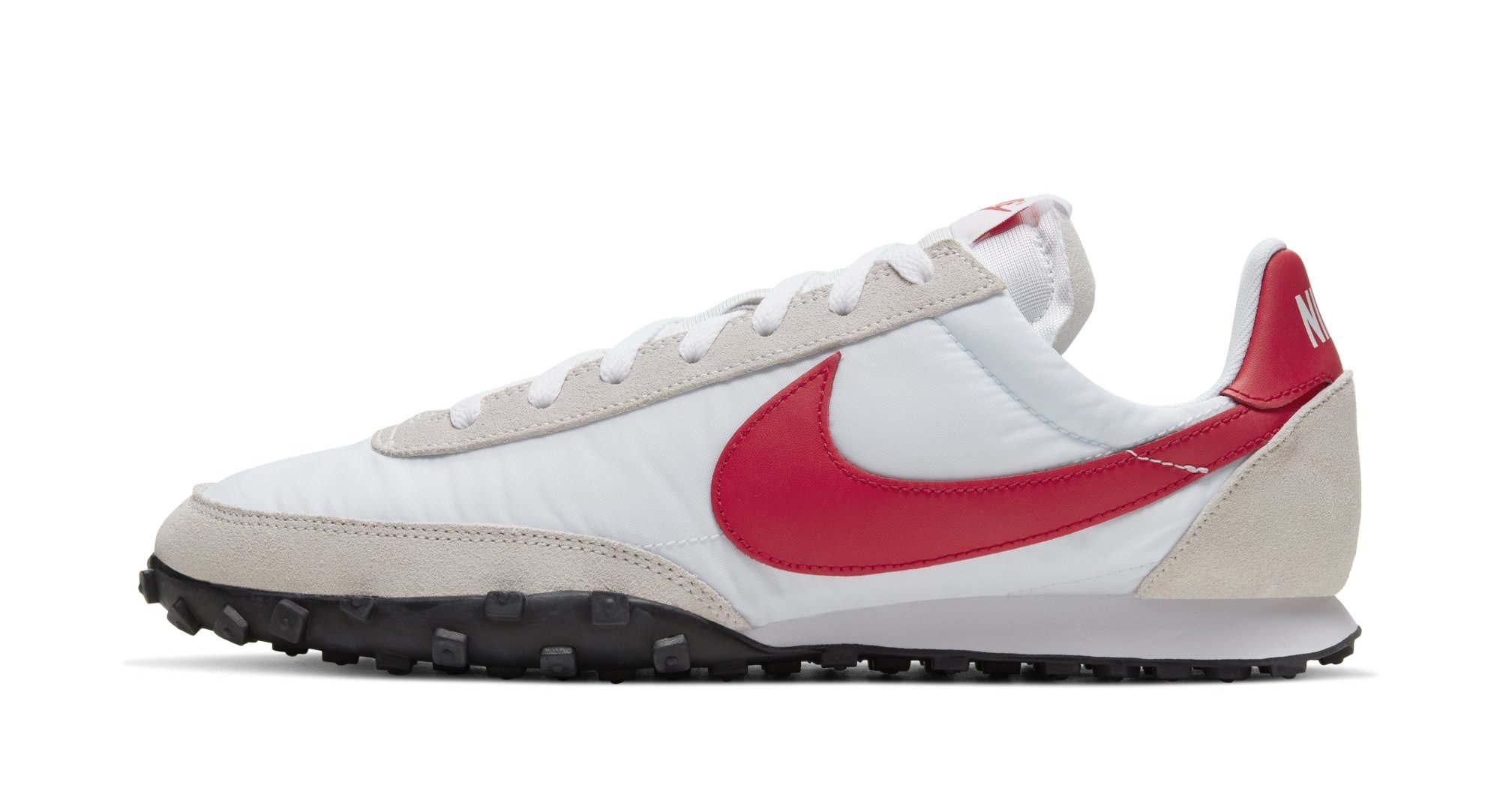
Year First Released: 1972
The Nike Waffle Racer is a shoe of lore. On this list not because it’s a favorite amongst today’s era of sneakerheads, but because it’s one of Nike’s most important sneakers ever. Before Air Max, before Air Jordan, before Air Force 1, there was Nike’s Waffle sole. The story behind it is etched in the brand’s history. Nike co-founder Bill Bowerman, who also served as track and field coach at the University of Oregon, was famously tinkering with a way to create an on-field advantage for his athletes. His solution: create a new tread with his wife’s waffle iron. The result was the Waffle Racer, and much of Nike’s early success in the running world was predicated on this design. Bowerman wanted to create the feeling of a track spike without the weight of metal that could perform on a multitude of surfaces, so he was inspired by watching his wife make breakfast one morning in 1971 when he had his “a-ha” moment. Much of Nike’s early sneakers have this design language, and we’ve seen it be repurposed by the likes of Junya Watanabe, Sacai, and Virgil Abloh. It’s not used for performance anymore, but it’s not going anywhere. Like Jesus told Peter, “upon this rock I’ll build my church,” the same can be said for Nike and Bowerman’s Waffle. –Matt Welty
47. Nike Air Zoom Generation
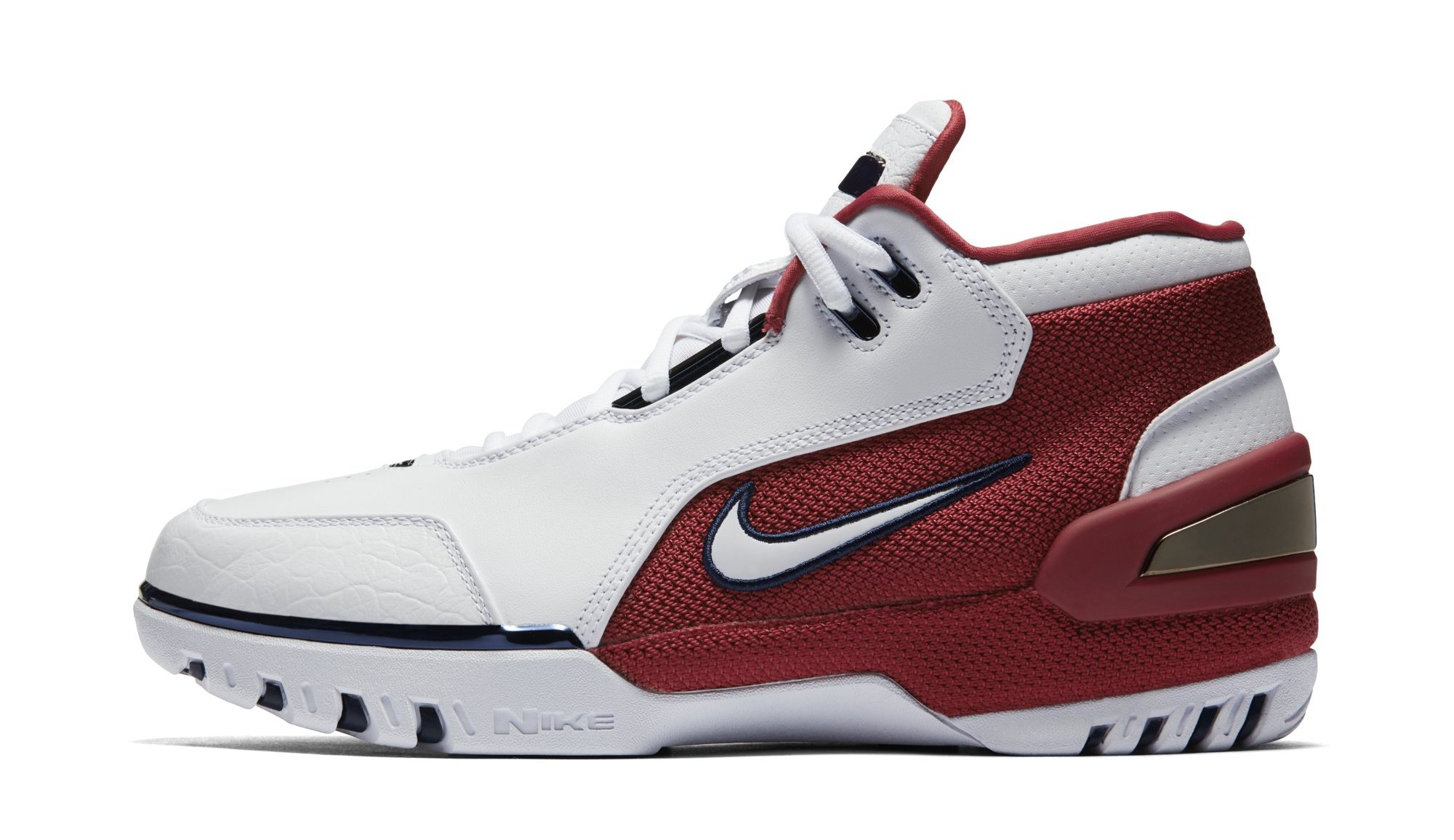
Year First Released: 2003
After signing 18-year-old LeBron James to a then-record seven-year, $90 million contract in 2003, Nike was left with the task of creating a debut signature shoe for a generational athlete and arguably the most hyped NBA prospect of all-time. Understanding the gravity of the project, a super trio of Aaron Cooper, Tinker Hatfield, and Eric Avar assembled to work on the design.
In meetings with the design team, LeBron communicated that comfort was his top priority in a shoe, leading Cooper to make a bold proclamation: “We will design you the most comfortable basketball shoe you have ever worn.” Several of Nike’s trademark performance features helped Cooper, Hatfield, and Avar achieve the desired comfort James was searching for. Sphere technology, a dimpled fabric interior lining that was being employed in a basketball shoe for the first time, and large medial air vents helped with airflow and moisture management. For cushioning, forefoot Zoom Air was paired with a double-stacked heel Air unit. Lastly, a full-length carbon fiber spring plate stabilized the foot and compelled the forefoot and rearfoot to work in unison. Collectively, these features would often be found in shoes at higher price points, but were delivered in the AZG at an affordable $110 price tag.
Some say the AZG is built like a tank. It was designed with a militaristic theme in mind, as LeBron was often likened to a “modern-day soldier” on the court. They also pulled cues, such as the chrome bumper and “Nike” font on the sole from the Hummer H2 he famously drove as a senior at Akron’s St. Vincent-St. Mary High School.
Once the Air Zoom Generation was revealed to him, LeBron fell in love. “If they could talk, I’d marry them,” he said.
Though it was crafted for the athlete of the future, the AZG was more of a throwback to leather-built basketball shoes during an era when everyone else was seemingly focused on gimmick technology and more futuristic-looking footwear. Much like the player it was made for, the shoe had incredibly lofty expectations to live up to and managed to over-deliver. –Brandon Richard
46. Nike Zoom KD 4
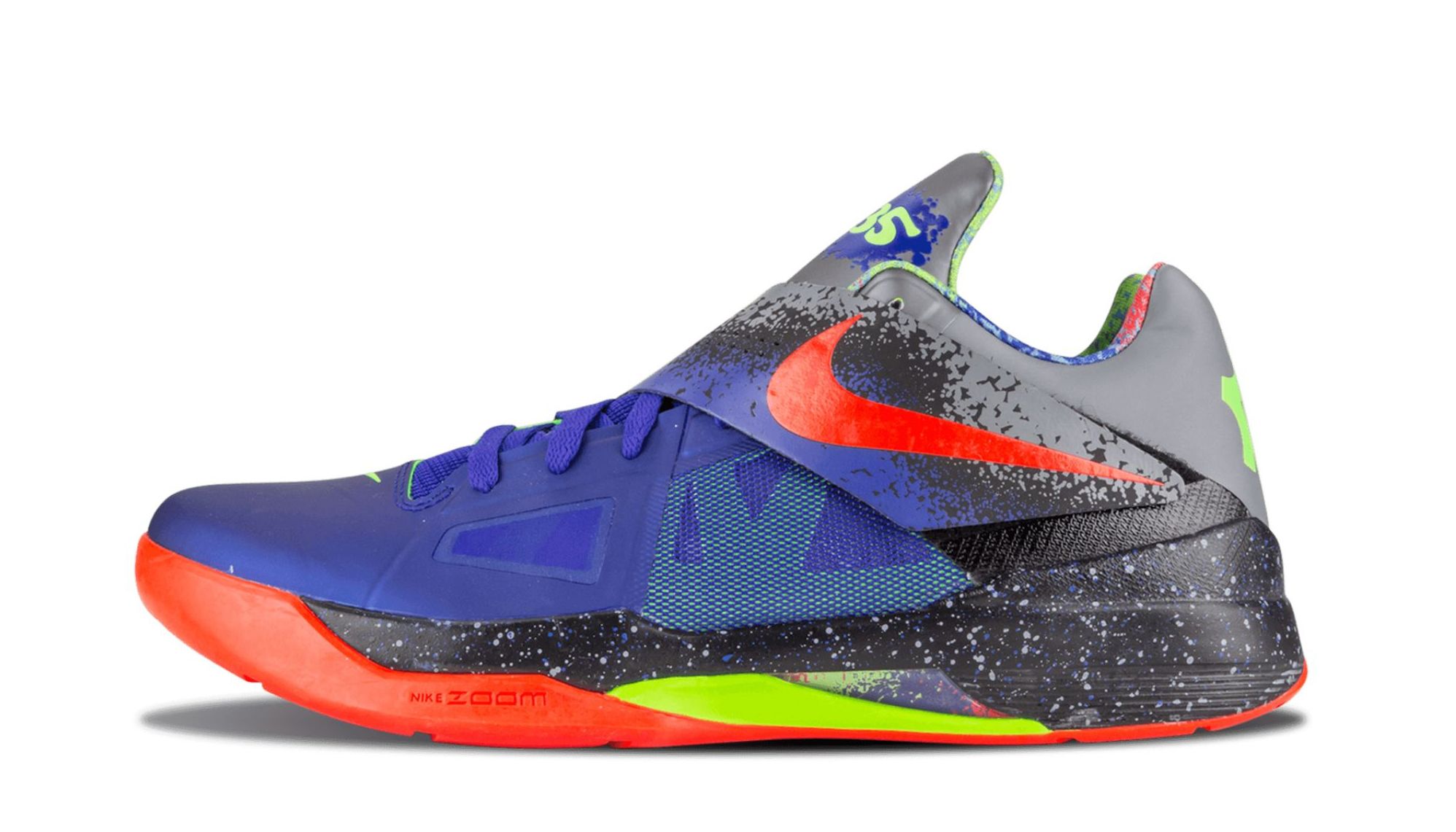
Year First Released: 2011
When the Zoom KD 4 debuted in 2011, it marked a clear shift in Kevin Durant’s signature line. Up to that point, Durant was living up to the hype with his on-court play, but it didn’t result in many memorable sneakers. The KD 1 and KD 2 were fairly generic mid-tops. The KD 3 made a small stride forward with its sleek upper and handful of appealing colorways like a red “All-Star” model covered in lightning bolts. But the real coming out party for Durant’s signature line was the debut of the KD4. Designed by Leo Chang, the pair took a drastic shift from the first three KDs with its low-top design and added adjustable Adaptive Fit strap system across the forefoot.
“The 3 was almost a little bit higher, like a Kobe 4 kind of height. With [the KD 4], we decided to go a little bit lower, and he liked it,” Leo Chang told Sole Collector back in 2012. “He loves his shoes to be light and tight. That was definitely something he wanted to continue.”
The upgrades didn’t result in a dramatic price hike for the KD 4. In fact, the KD 4 was one of the most affordable basketball sneakers on the market at the time. Its retail price of $95 was a budget-friendly entry point for hoopers and KD fans alike, especially considering other signature models at the time from Nike’s other superstar athletes like LeBron James and Kobe Bryant were retailing at $170 and $150, respectively.
If the low price point and intriguing new design weren’t enough, the colorways that graced the KD 4 are what truly cemented its place in Nike Basketball history. Standouts included the “Weatherman;” a green pair complete with doppler radar graphics on certain panels inspired by the occupation KD would have chosen had he not been a pro basketball player, “NERF;” which pulled inspiration from the nostalgic toys and even came packaged with its own mini hoop, and an all-silver pair with a galaxy liner that was part of Nike Basketball’s iconic 2012 All-Star Weekend lineup. Themes like the “Aunt Pearl,” an homage to KD’s aunt who passed away after battling breast cancer, were introduced on the KD 4 and are still used annually. The KD line is currently on its 15th installment. Nothing has come close to the success and popularity of the KD 4. –Mike DeStefano
45. Air Jordan 8
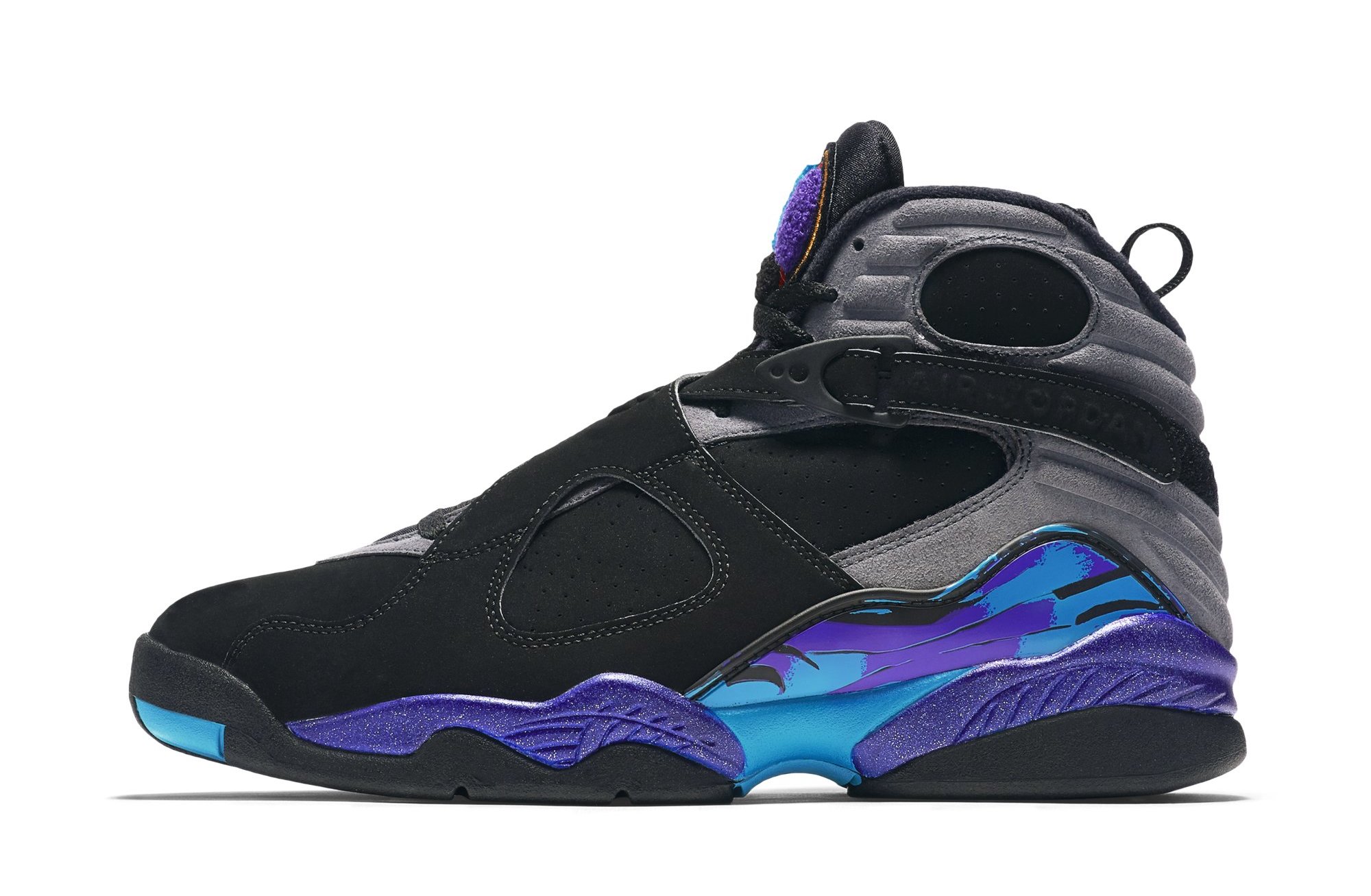
Year First Released: 1993
One of the most exciting aspects of Air Jordans in their prime was how much the models changed from year to year. There was continuity in the tech they used and some of the campaigns around them, but each Tinker Hatfield design zigged or zagged considerably from the one before it. The Air Jordan 8, originally released in 1993, took the line in a bulky new direction, with straps across its upper akin to those used on the popular Air Raid outdoor basketball shoe from the same era. It came in just three colorways: the white/red that Jordan started the season in, the “Aqua” pair that he wore for the All-Star Game, and the black/red that he switched to for the playoffs.
The shoe is notable not only for its chunky design, which was more rounded and bulbous than the sleek earlier entries that drew on fighter jets and sports cars for inspiration, but also its spot in Jordan’s career. It’s one of the best Nikes ever made, in part because of its historical significance as the shoe he wore en route to the first Chicago Bulls three-peat.
Like all of the Air Jordans from Hatfield’s initial run with the line, the Air Jordan 8 grew in stature as a retro. It has never been quite as clamored for in its second life as models like the Jordan 1, 3, 4, or 11, but it holds its own among the (don’t kill us for this, we’re still saying it’s a great shoe) second tier of Hatfield Jordan designs. –Brendan Dunne
44. Nike LeBron 7
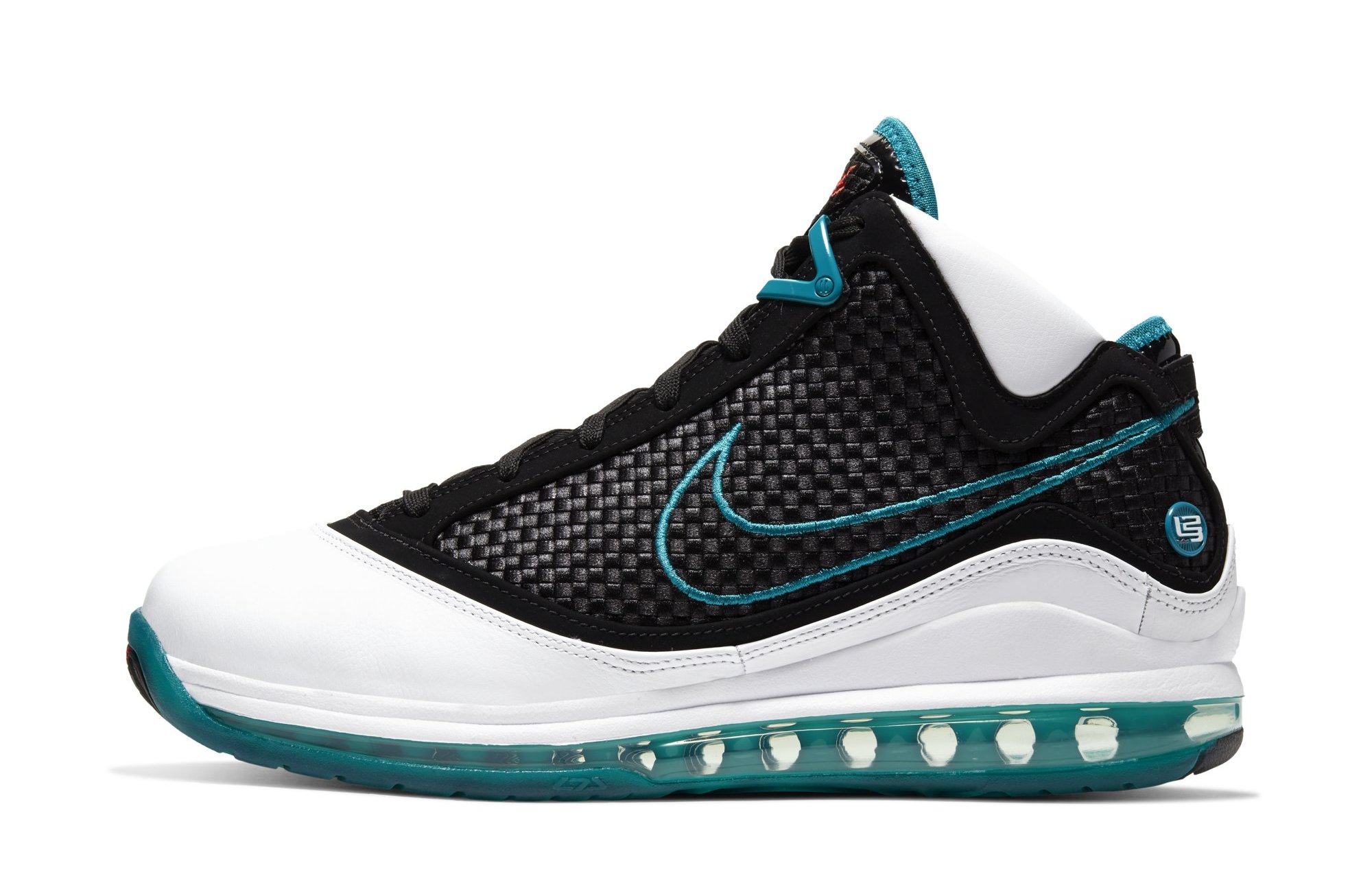
Year First Released: 2009
Fresh off LeBron James’ first MVP campaign in 2008-09, Nike and designer Jason Petrie wanted to make a statement with the LeBron 7. The kid from Akron was now established as the man, and the NBA was his league for the taking. “Starting with the 7, we’re really embarking on this new stage in his career,” said Petrie. “And we want every shoe from here on out to really show that and follow LeBron as he continues to evolve and change the game.”
Petrie, working as lead designer on a LeBron model for the first time, wanted to steer the line back into a performance-driven direction after the more casual LeBron 6 was met with a mixed response. James had always expressed a desire for style in his signature shoes, but was vocal about wanting something lighter and better suited for his evolving body and playing style, especially after the launch of the well-received Nike Hyperdunk.
What came after was what Nike called a “complete revolution of the LeBron line.” To that point, Nike LeBrons had always been Zoom models, but Petrie wanted to introduce Max Air to complement the more explosive element of LeBron’s game. As a fan of the Air Max Griffey series and 90s Nike hoop shoes in general, LeBron was excited about the addition. However, they didn’t just add standard Max Air—instead, the LeBron 7 was built with a reengineered 360-Max Air unit that was constructed for basketball for the first time. The system, which was said to sit lower and hold 80 percent more Air than previous Air Max models, allowed LeBron to get a smoother transition through each footstrike.
Going back to LeBron being impressed with the Hyperdunk, Petrie and the design team explored the idea of adding Flywire to a special premium edition of the LeBron 7 that would be sold at a higher price point. However, because of the positive feedback for those samples, along with LeBron’s request for a lighter shoe, the technology was ultimately worked into the standard LeBron 7. The composite worked in unison with a seamless inner construction to give the shoe a snug, locked in fit.
As promised, the LeBron 7 marked a complete shift in direction for the line and signaled what was to come. And while it was presented and functioned as an innovative performance vehicle, the LeBron 7 still exudes casual appeal for its time. A wide range of colorways, textures, and materials made it the most coveted and collectible LeBron model to date. –Brandon Richard
43. Nike Air Max 180
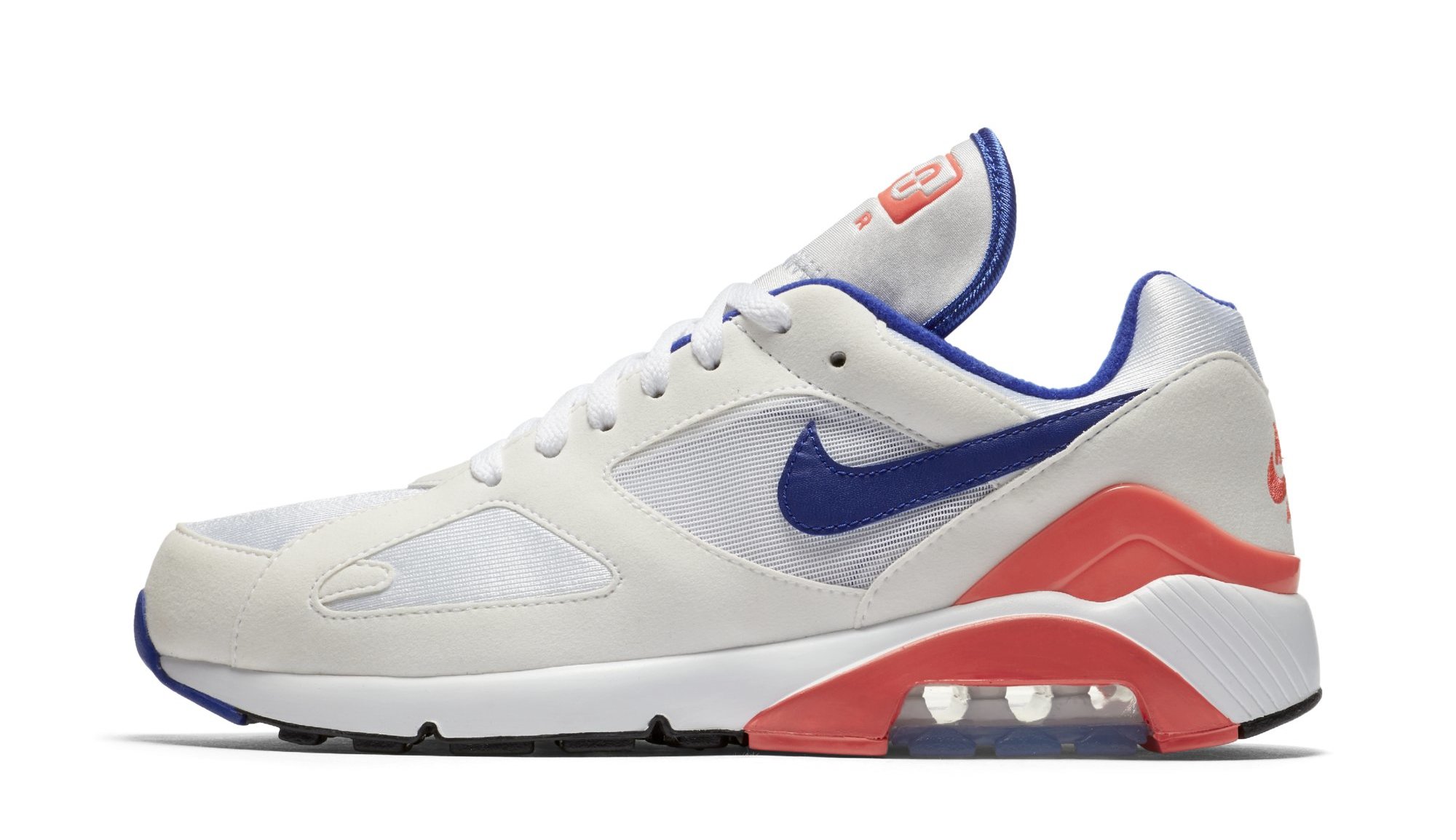
Year First Released: 1991
The Air 180, or Air Max 180, is the first time that Tinker Hatfield really tinkered with the Nike Air bag. The bubble, which sparked a footwear craze, had remained the same pretty much throughout the Air Max 1 in 1987 and the Air Max 90 in 1990. In 1991, that all changed. This was the first time that Nike made a “180 degree” Air unit. To be fair, the bubble wasn’t that much different in overall performance from its predecessors, but it had one distinct aesthetic difference in that the bottom of the Air Unit wasn’t wrapped by the midsole. Instead, it was exposed on the outsole.
The air would hit the road, giving a more bouncy step in theory than the Air Max 1 and Air Max 90. The upper of the shoe was different too. Whereas the Air Max 1 and 90 had loose, traditional padded tongues, the Air 180 felt more like a sock with a neoprene tongue gusseted into the shoe. In fact, on the design sketches of the sneaker, you can see an anatomical foot resting on the sneaker’s midsole.
The shoe had pop culture relevance, too. Michael Jordan wore them in a photo shoot for the 1992 Olympics in a white/black/purple colorway. The original color scheme, the Ultramarine, has been placed on other shoes by Nike. France’s Opium collaborated on the shoe and did it in leather and camo, making it one of the most sought-after projects of the 2000s. The Powerwall versions were great and the shoe was recreated by Ralph Steadman, who’s best known for his illustrations alongside Hunter S. Thompson in Fear and Loathing in Las Vegas. It was given a hairy suede and a rabbit character on the tongue, which was part of the original marketing of the shoe. The original colorway, the Ultramarine, is also nicknamed the “dirt magnet,” because the white microsuede upper is impossible to stay clean. That aside, the shoe has had quite a run. –Matt Welty
42. Nike Zoom Fly
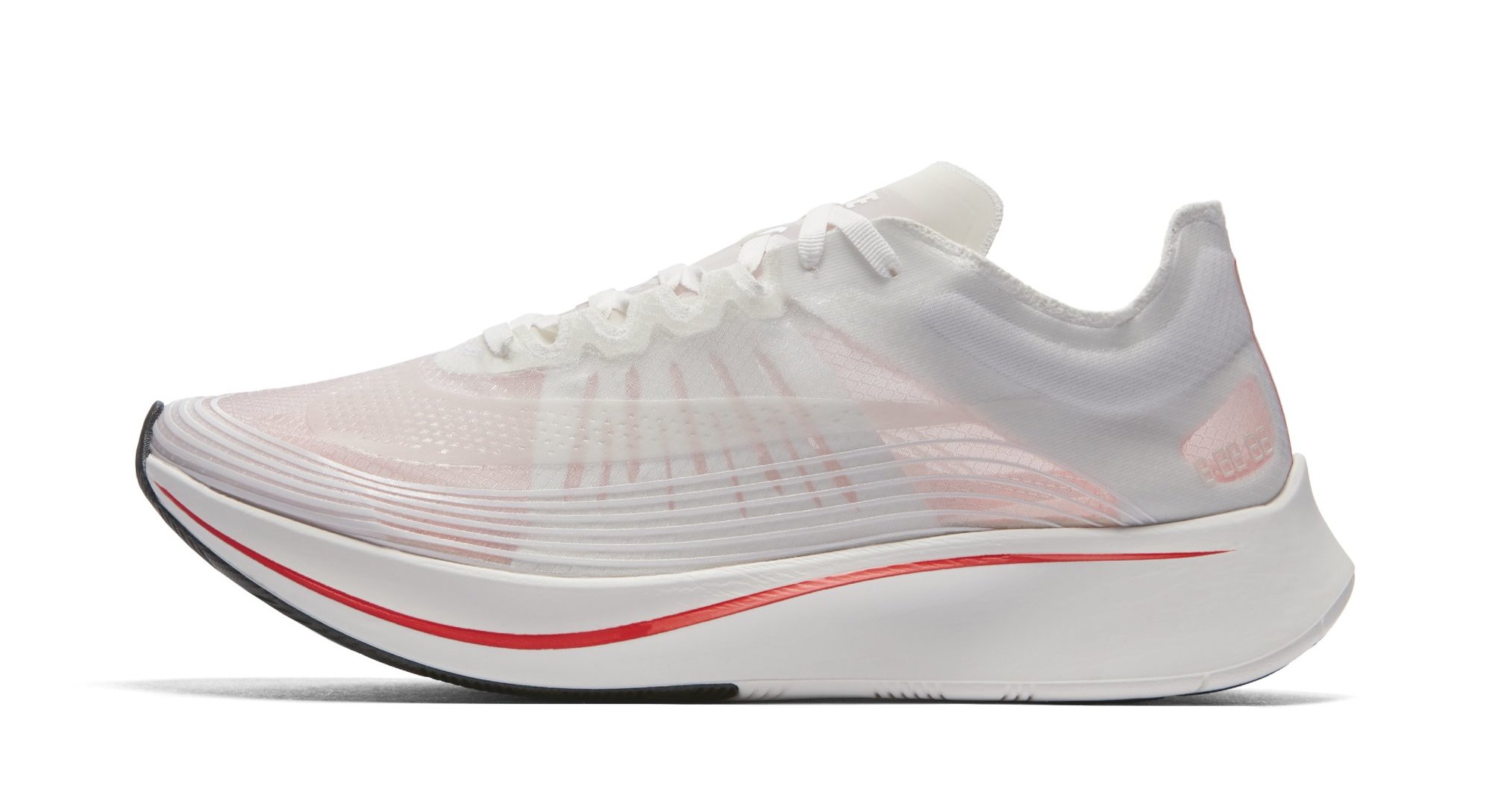
Year First Released: 2017
Nike set out to break the two-hour marathon barrier via its Breaking2 event in 2017, and one of the byproducts of that feat was creating new sneakers for the elite athletes to wear for the initiative.
The sneaker worn by the elite runners in the event, the Nike Zoom VaporFly Elite, never got a commercial release, but one of the pairs born out of the event was the Zoom Fly. Despite Kipchoge missing the sub-two-hour mark at the Breaking2 attempt, sneakers like the Zoom Fly caught significant buzz from runners and sneaker fans alike due to the possibility of the model helping wearers run faster.
The Nike Zoom Fly is essentially a takedown version of the VaporFly Elite. The brand even created a special white-based iteration of the shoe in June 2017 to commemorate the Breaking2 initiative.
Both models use a similar setup in the midsole, with a responsive plate embedded within the tooling. The latter shoe was equipped with a carbon fiber plate tucked within the innovative ZoomX foam, while the former uses a carbon-infused nylon plate implanted within the Lunarlon midsole. The upper is constructed of a breathable engineered mesh and Flywire panels on the sides that provide lockdown for long distance runs.
At the time of writing, Nike has released five versions of the Zoom Fly, which remains one of the brand’s most popular runner offerings. Building on the original shoe, the latest version is now equipped with the popular ZoomX foam, a detail that’s generally reserved for its premium running sneakers, allowing it to be worn both as an everyday runner and on race day. –Victor Deng
41. Nike Air Max Penny 1
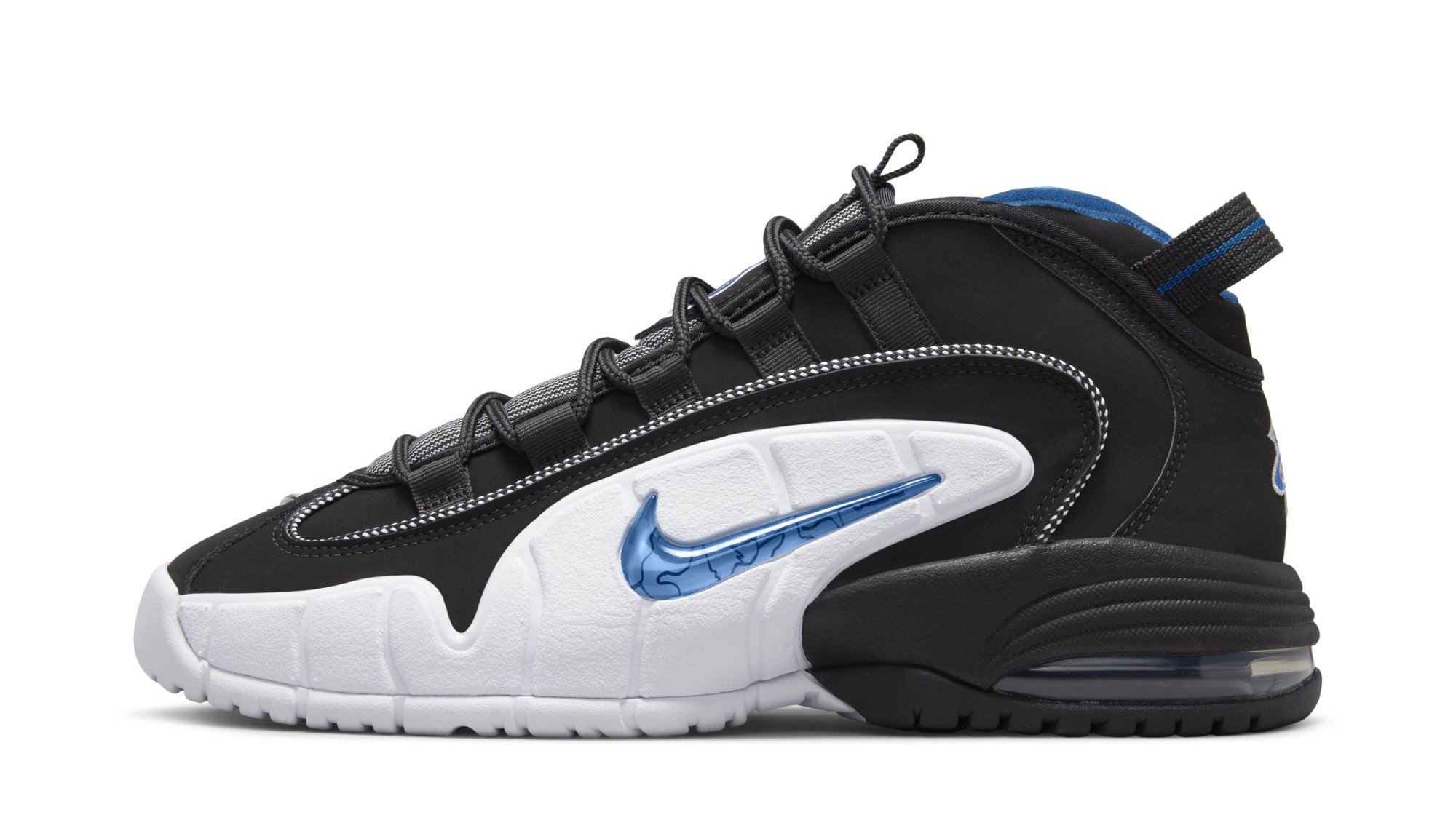
Year First Released: 1995
Following Michael Jordan’s unexpected retirement ahead of the 1993-94 season, the NBA was left searching for its next superstar. Shaquille O’Neal helped fill the void to an extent, but the league was still missing that charismatic wing player that fans have gravitated more toward over the years. Enter O’Neal’s teammate Anfernee “Penny” Hardaway, a play-making point guard from Memphis who quickly established himself as one of the new faces of the game. As Penny’s popularity quickly surged, Nike didn’t waste much time getting plans for a signature shoe underway. Eric Avar, who had previously worked on models such as the Air Max CB 94 for Charles Barkley, was tapped as the designer of what would become the Nike Air Max Penny 1.
While he was designated as a point guard and led the offense as such, Penny was one of the league’s early “positionless” players due to his ability to seamlessly transition from facilitator to scoring threat. Up to that point, Nike Basketball shoes were generally separated into two categories: Flight or Force. Flight was often designated for speedy guards and Force for bruising post players. Understanding that the game was evolving because of players like Penny, a new category called Uptempo was created, and the Penny 1 was its first official release. “We had Flight and Force and we were looking at trying to dimensionalize the basketball line around this notion of versatility and that’s kind of what Uptempo was,” said Avar.
Avar knew that because of his unique combination of size and speed, Penny would need an equally unique support in his sneaker. The idea was to place the newly named Tensile Air, later renamed Zoom Air, in the forefoot for the speed-based element of his game, while the heel housed an Air Max2 unit for impact protection during more explosive plays. An ambitious undertaking at the time, this cushioning setup eventually became standard in the basketball category and beyond.
The design of the Penny 1 was inspired by Penny himself. Sleek, aerodynamic, but noticeably equipped for power. Perhaps the most striking feature was a dynamic wing, also a direct reference to the athlete. The grooved Phylon ran along the shoes’ medial side and served as somewhat of a precursor to another addition to Penny’s signature line—the Air Foamposite One. Details such as the debut of the “1 Cent” logo and Orlando Magic-inspired pinstripes on the tongue helped make the Penny 1 one of the most eye-catching designs of its time.
It’s impossible to tell the story of Penny and his debut signature shoe without discussing an all-time great marketing rollout, led by his puppet companion Lil’ Penny. As explained in Complex’s oral history of Lil’ Penny, the campaign was conceptualized by Stacy Wall, then-creative director for advertising agency Wieden+Kennedy. Voiced by Chris Rock, Lil’ Penny helped give his mild-mannered human contemporary a strong presence in an increasingly crowded space.
Hardaway never became Jordan’s replacement, but he didn’t have to. He existed alongside a returning Jordan with a signature sneaker line that stacked up against the arguable peak of Air Jordans, led by the Penny 1. –Brandon Richard
40. Nike Air Griffey Max 1
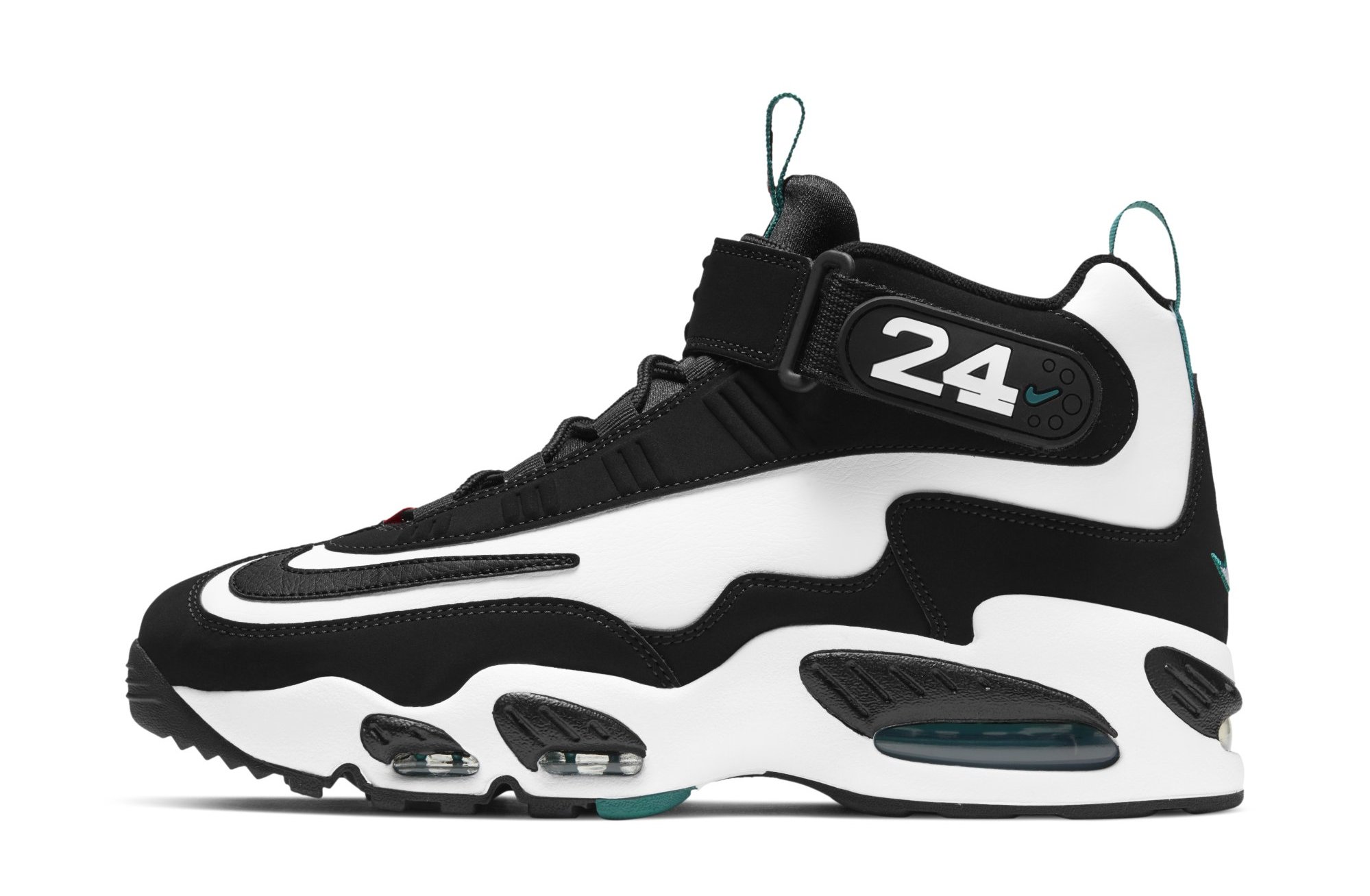
Year First Released: 1996
In the mid-1990s Ken Griffey Jr. was on top of the baseball world. He was an All-Star every single season and a perennial MVP candidate, setting the foundation for what would become one of the greatest careers in the history of Major League Baseball. Griffey was well on his way to becoming a megastar, and Nike saw him as a natural fit to carry the torch of its cross-training footwear category popularized by the likes of Bo Jackson and Deion Sanders.
In 1996, Nike released Jr.’s first signature sneaker, the Air Griffey Max. When Griffey’s first shoe dropped, the Air Jordan line was on top of the world, creating footwear for Michael Jordan that was of course functional for on-court use, but was also ready for lifestyle wear as well. This was important to the MLB Hall of Famer as well, and that’s exactly what Tracy Teague, the shoe’s designer, sought to do with the Griffey Max.
The Air Griffey Max debuted in three original colorways, two of which were inspired by the colors of the Seattle Mariners, the “Emerald” and “Freshwater” versions, along with a third “Varsity Royal” pair. While the pairs that dropped at retail were turf-ready trainers, Jr. wore cleated versions of the Griffey Max on the diamond, helping popularize the model even more.
Griffey and the Swoosh had a successful partnership that included a number of signature models, but none of them were quite as revered as the original. In 2009, the Air Griffey Max was retroed for the first time and has since hit shelves a number of times, including 2016’s “Griffey For Prez’’ iteration referencing the famous 1996 ad campaign that had Jr. running for office. In 2018, the Air Griffey Max made an appearance in the LeBron Watch series, remixing a number of Nike’s most iconic sneakers with the King’s Nike LeBron 15, further cementing its legacy. –Ben Felderstein
39. Air Jordan 13
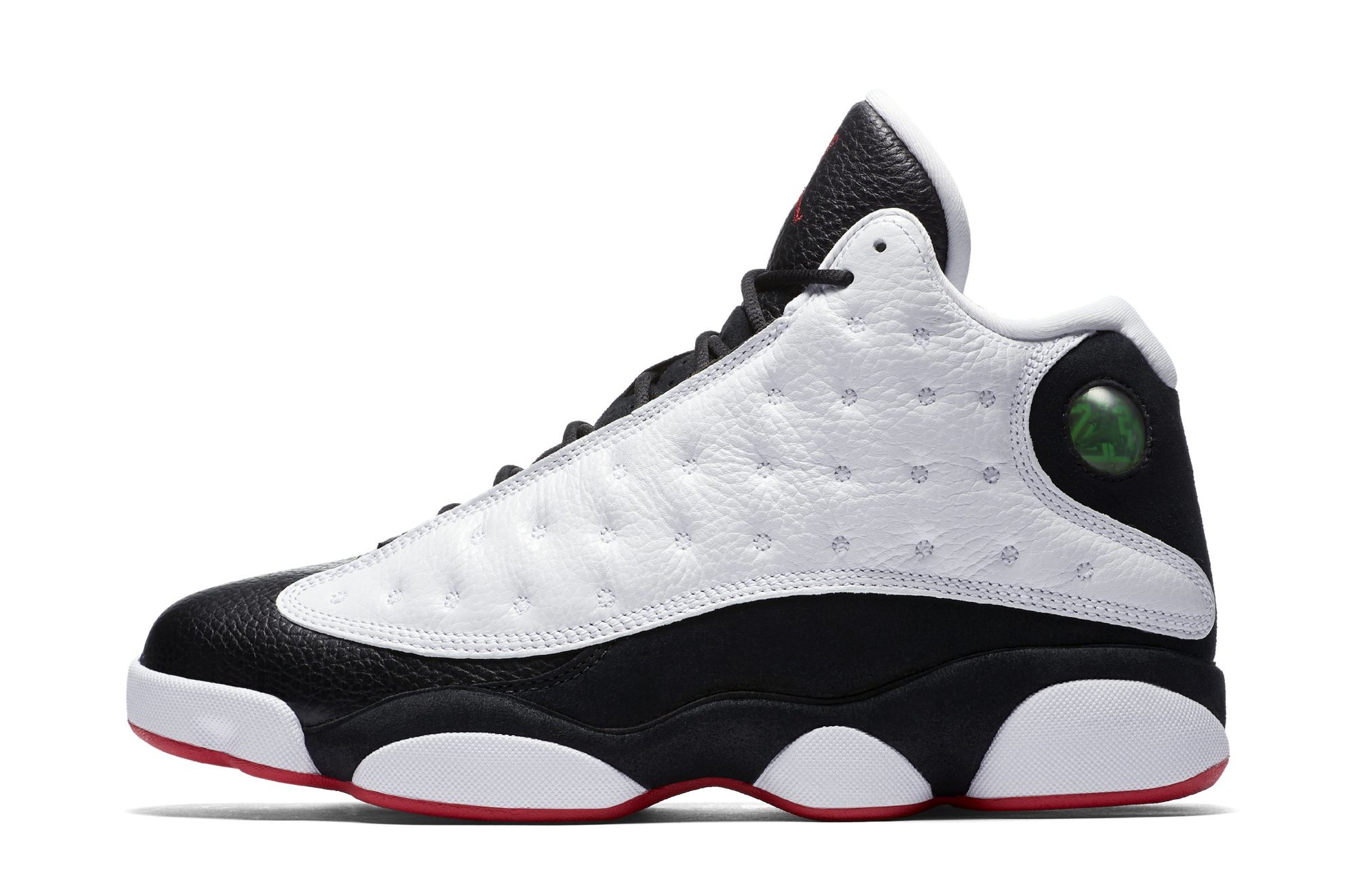
Year First Released: 1997
The Jordan 13 was the footwear vessel that navigated MJ through his sixth and final championship during the 1997-’98 season. In another life, MJ doesn’t break out his Jordan 14 prototypes early during Game 6 of the 1998 NBA Finals and the Air Jordan 13 is instead plastered all over every picture and poster of the iconic “Last Shot.” Despite the Jordan 13 getting robbed of its potential moment in the sun, the shoe has been able to carve a long and layered legacy that’s made it a fan favorite to this day.
The Air Jordan 13 was everything a turn of the century signature sneaker should be. This Tinker Hatfield classic was an organic evolution from the Jordan 12 and was the second official Jordan signature release for the newly established Jordan Brand. The Jordan 13 features a fantastic blend of materials and asymmetric design cues—coupled with technical future-forward elements. Tinker infused inspiration from a black panther’s paw onto the midsole and sole tooling that reflected Jordan’s cat-like prowess on the court. The 3M material woven throughout the mesh upper and the signature hologram on the lateral heel gave them just the right level of pomp and circumstance you’d expect from the premier performance basketball sneaker at the time. The original Jordan 13 run featured five colorways of the highs, which MJ wore the majority of on-court, and two colorways of the lows that were geared toward a more lifestyle aesthetic.
The Jordan 13’s strongest suit is that it has become one of those sneakers that’s achieved success with a life after MJ. The white/black pair had a prominent role in Spike Lee’s 1998 hoops classic He Got Game and is now affectionately stuck with that moniker as its nickname. Aside from the Jordan 13’s Hollywood breakout, we’ve seen countless NBA and college PE colorways, dozens of retro releases throughout the years, and cleated versions on MLB diamonds and the NFL gridiron.
One of the Jordan 13’s greatest strengths from an off-court aesthetic standpoint is that it looks great in almost any colorway. Jordan Brand has taken full advantage of this fact and has kept the 13 fresh over the years by mixing up the color palette and hitting fans with energy releases from the likes of Clot and SoleFly or spinning out ultra limited releases like the Bin 23s or Ray Allen PEs from 2011. –Kevin Luyster
38. Nike Pegasus
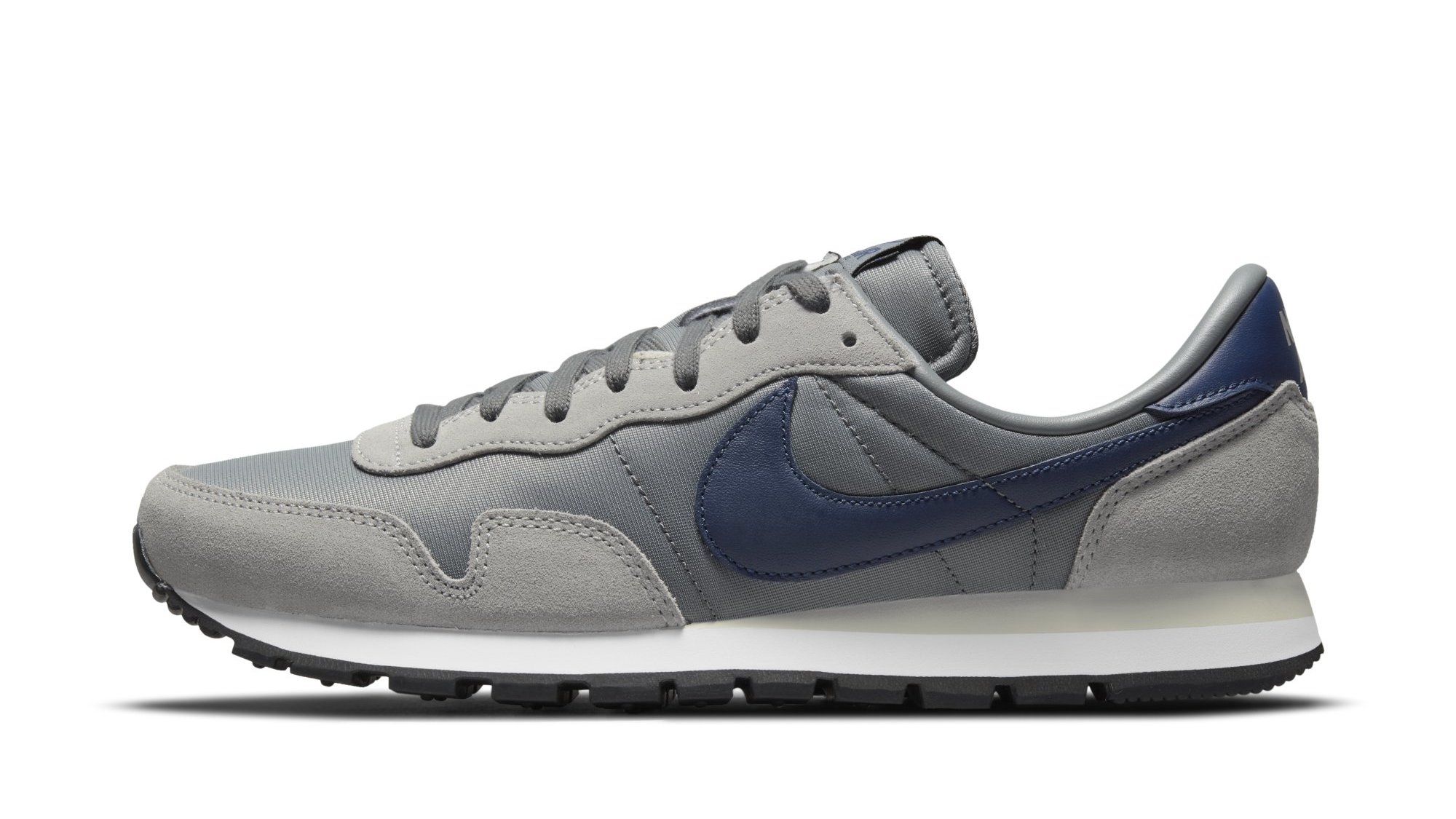
Year First Released: 1983
1983 changed things forever for Nike Running. It was the year that the Swoosh launched its first-ever Pegasus shoe.
The Nike Pegasus was conceptualized in ‘83 by veteran footwear designer Bruce Kilgore, who was responsible for conceptualizing the Air Force 1, and Mark Parker, who would go on and become the CEO of Nike. Talks about the creation of the Nike Pegasus began with a simple mission, which was to create an affordable running sneaker that meets the needs of all runners.
The popular Nike Pegasus running line gets its moniker from the winged horse of the same name in Greek mythology to represent the sneaker’s quickness. The Nike Pegasus was the brand’s first mid-priced running shoe that focused on performance and affordability while also implementing its latest technology.
The core value of introducing new tech to the affordable running line has not been lost on the brand even after releasing a total of 39 iterations of the Pegasus in 2022. Nike introduced its latest Pegasus 39 in June, which was the first time that the Pegasus featured a second Zoom Air unit as well as a more breathable upper for all-weather runs. –Victor Deng
37. Nike Flyknit Trainer
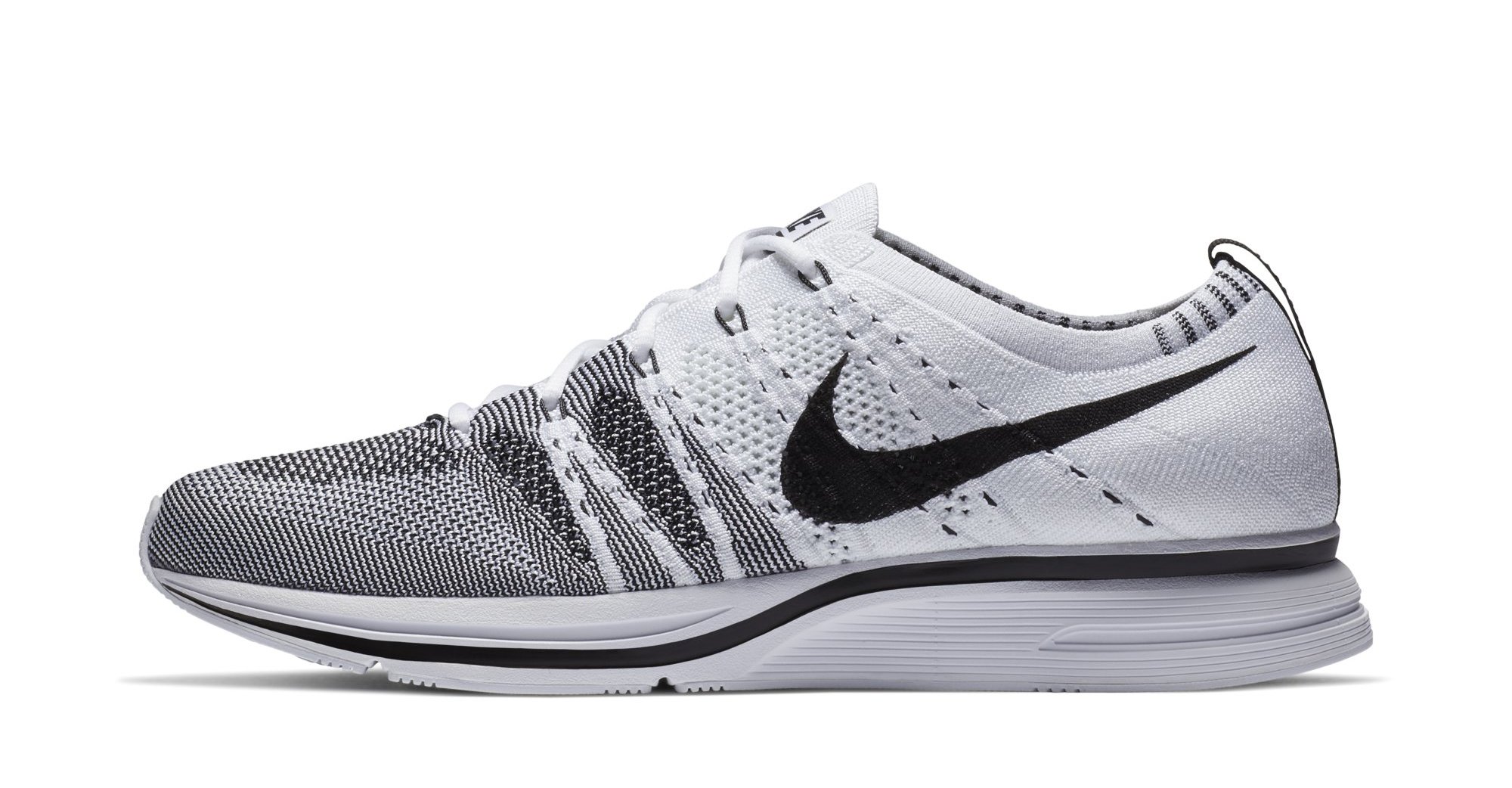
Year First Released: 2012
The Nike Flyknit Trainer was one of those sneakers that changed everything. The shoe, along with a handful of other first-generation knit models, marked the dawn of the Nike Flyknit era in 2012. It was among the first designs to use Flyknit, a Nike innovation that allowed the brand to manufacture fully knit uppers for shoes. It helped inspire a whole category of similar shoes from Nike and other brands, and was even part of a lawsuit with Adidas over the use of knit tech in footwear.
For all its novelty, the Flykint Trainer is a funny shoe in that it’s not particularly sport specific. It’s kind of a performance shoe, but doesn’t really have a home in a particular activity. The Flyknit Racer, which released around the same time in 2012, was more of a pure running shoe. The Flyknit Trainer was tacitly understood as a lifestyle shoe, and found great success there. It inspired a moment of people actually wearing new designs rather than always reverting back to sneaker designs from the ‘80s and ‘90s. Remember how big of a deal the black and white pairs were? Or how much you wanted the multicolor version? The Flyknit Trainer inspired fervor without any help from outside collaborators, in-depth storytelling around colorways, or other hype gimmicks that the retro shoes we like are so often caught up in. Instead of relying on the past, it offered a sleek vision of what the future could be. –Brendan Dunne
36. Nike Free Run 2
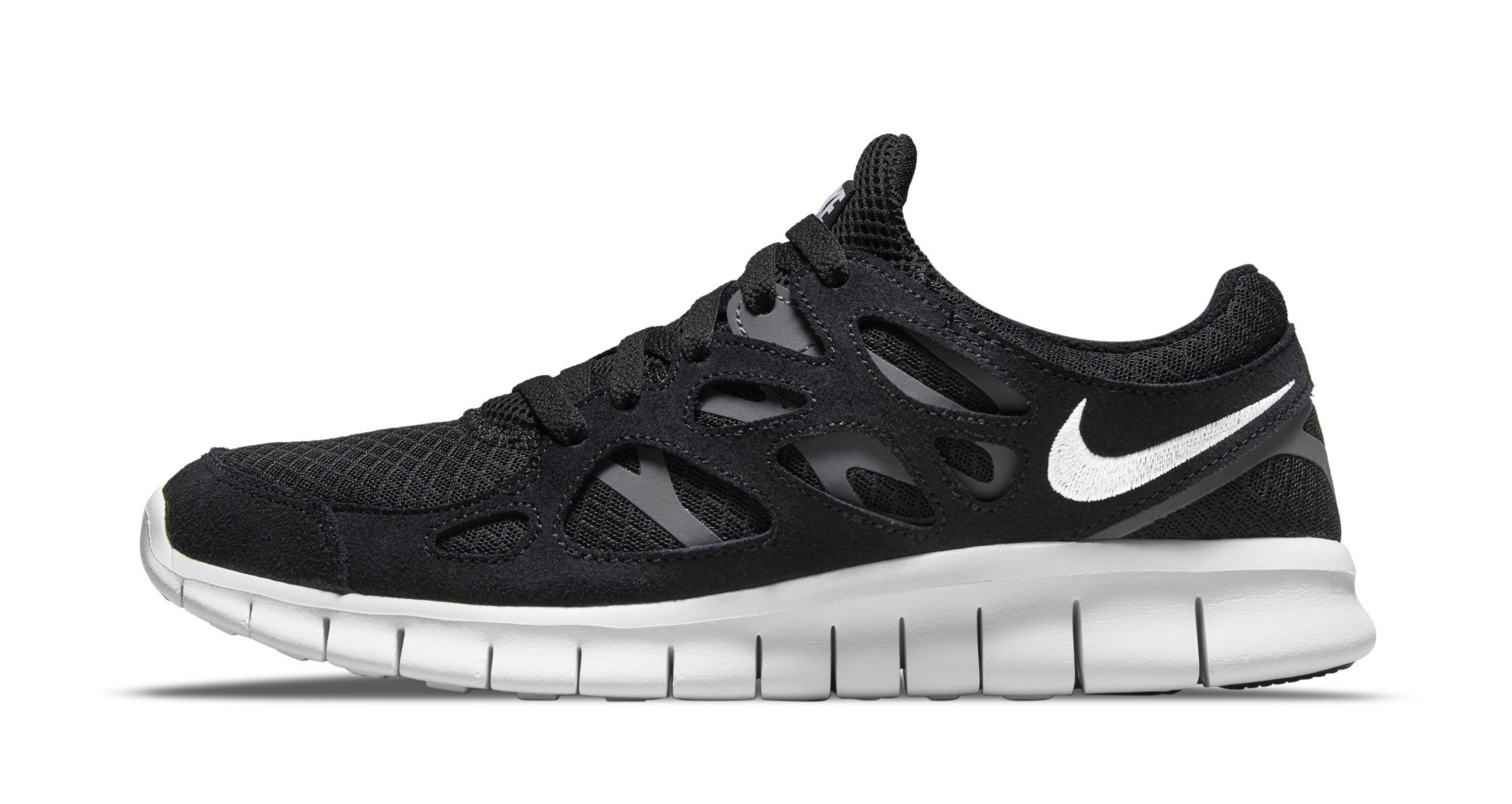
Year First Released: 2011
The Nike Free running line was conceptualized both by Tobie Hatfield and Eric Avar, and its inspiration may not be an obvious one. The designers referenced a training session from Stanford athletes, where they saw the students training barefoot at the university’s golf course. The two then took what they saw to the sketch boards and test labs. The development of the Nike Free line kicked off in the early 2000s, when the brand examined a group of men and women wearing pressure-measuring insoles that were taped to their feet.
The study captured their data with high-speed cameras to study the foot in motion, which resulted in a better understanding of “natural” landing strides. The learnings from this study directly resulted in the development of the Nike Free running shoes, which offered natural foot movement. The sneakers feature a minimal heel-to-toe offset, an unconventional shape, and a super-flexible Phylon outsole.
The first Nike Free sneaker to release was the Nike Free 5.0 V1 that launched in 2004, but the most celebrated model from the line is the Nike Free Run 2 that debuted in 2011. The sneaker is best known for its simple design and tendon-like structure, which really helped accentuate the Free technology. Best of all, the model was available for an affordable $90. Other Free Run releases of that year included the Nike Free Walk+, the Women’s Free TR Fit 2, and the Free N7 5.0 V4, which were less memorable than the Free Run 2.
The Nike Free running line, which brought the concept of barefoot running to the mainstream, has remained a bestseller for the Swoosh. –Victor Deng
35. Nike Hyperdunk
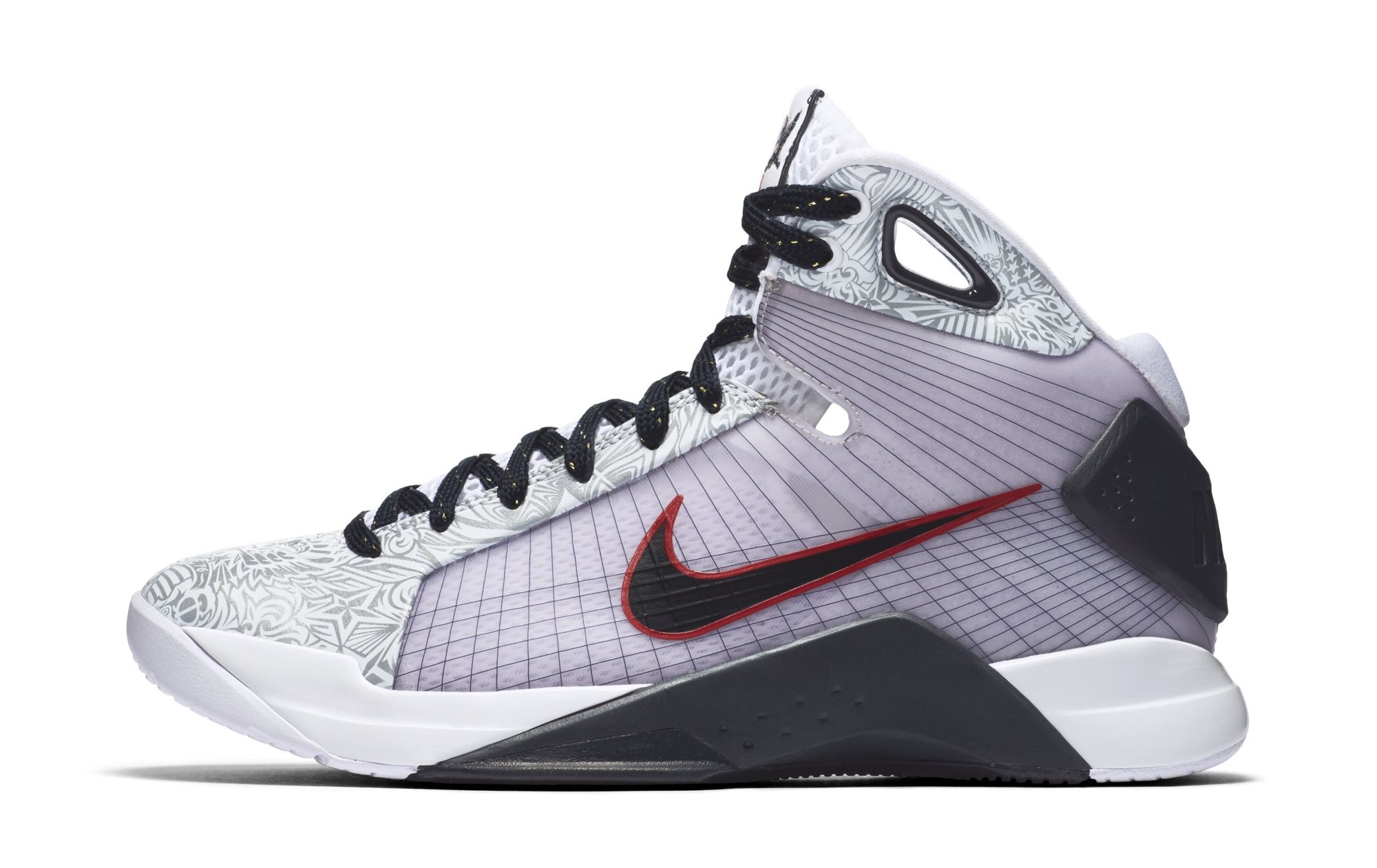
Year First Released: 2008
The Nike Hyperdunk was one of the most prolific basketball sneakers in the late 2000s. The performance basketball model, designed by industry veteran Eric Avar, was originally released in 2008 as part of Nike Basketball’s Beijing Olympics Innovation Program that took place that summer, but the inception of the model began more than two years prior to its retail debut.
Lending a hand to the sneaker’s design was Nike Innovation Kitchen director Jay Meschter, who created the innovative Flywire technology based on the suspension cables that appear on the sides of bridges. The technology was originally conceived for track spikes but was applied to the shoe’s upper, which removed significant weight from the shoe while still being able to withstand forces from cutting on the basketball courts. Nike also introduced another innovation in the Hyperdunk’s design with Lunarlon foam cushioning used for the midsole.
The shoe was on full display at the 2008 Summer Olympics, as the Swoosh employed all of its players at every position to showcase the sneaker at the global event. Beyond serving its on-court purpose, the Nike Hyperdunk has been the beneficiary of various marketing campaigns leading up to its debut, which include special cameos including at the ESPYs, numerous print and television ads, special releases including a Marty McFly-inspired colorway, and even a fictitious Recovery Center website and hotline for victims to receive treatment. –Victor Deng
34. NikeCraft Mars Yard
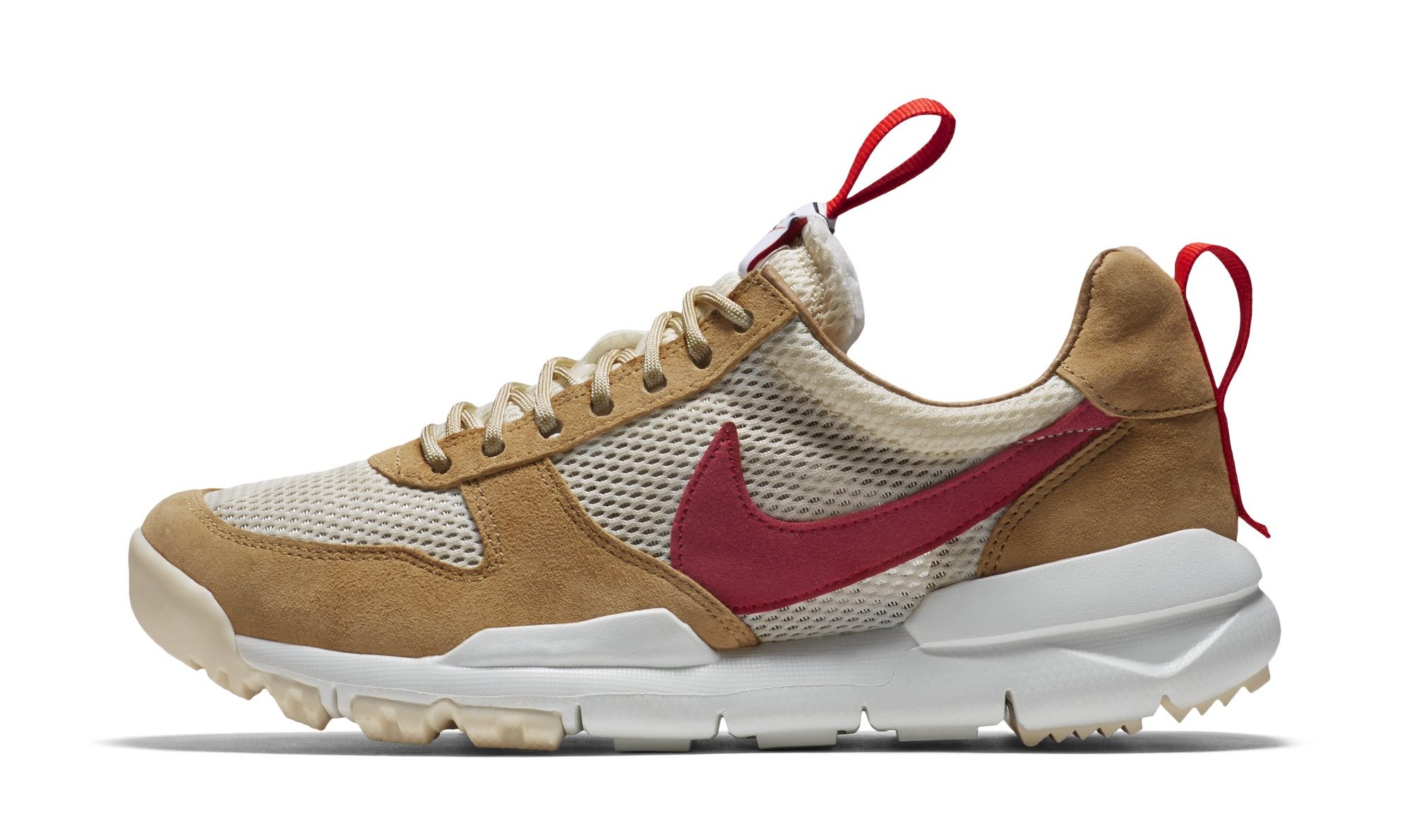
Year First Released: 2012
Long before the NikeCraft General Purpose Shoe showed up in Kohl’s stores, Tom Sachs and Nike’s partnership was born out of a challenge from former Swoosh CEO Mark Parker. “And at one point, Parker was like, ‘You know, Tom, you’re really good at talking shit, but you haven’t really designed anything. So I’m going to put the challenge to you: Show me how to do it, man,’” Sachs recounted in the 2017 book Sneakers.
The result was the Mars Yard, a 2012 sneaker that was informed by Sachs’ regular use of NASA themes. Described on the designer’s website as shoes “built to support the bodies of the strongest minds in the aerospace industry,” the earthy Natural/Sport Red/Maple sneakers took inspiration from the Apollo Lunar Overshoes (a theme revisited on a later Tom Sachs x Nike collaboration) worn for moon landings and even used special Vectran fabric from Mars Excursion Rover airbags.
To drive the theme home, the Tom Sachs x NikeCraft Mars Yard shoes were released at a “Space Program: Mars” event decked out with astronaut-themed installations at NYC’s Park Avenue Armory.
Over time, the Mars Yard’s limitations were exposed, specifically the Vectran material’s lack of durability and traction issues with the Special Forces Boot outsole. To remedy this, Sachs and Nike revisited the collaboration in 2017 with the improved Mars Yard 2.0. It featured the same colorway as the original, but added a new mesh in place of Vectran, chunkier lugs on the outsole, and reinforced stitching on the pull tabs.
Similar to its predecessor, the Mars Yard 2.0 was released at a special event, this time known as Space Camp. This time around, participants were required to tackle an obstacle course to get the shoes, although there were considerably more pairs to go around than on the first run. Nevertheless, it’s gone on to become one of Nike’s more coveted projects, and the Mars Yard franchise has been referenced numerous times on other released and unreleased product. –Riley Jones
33. Air Jordan 7
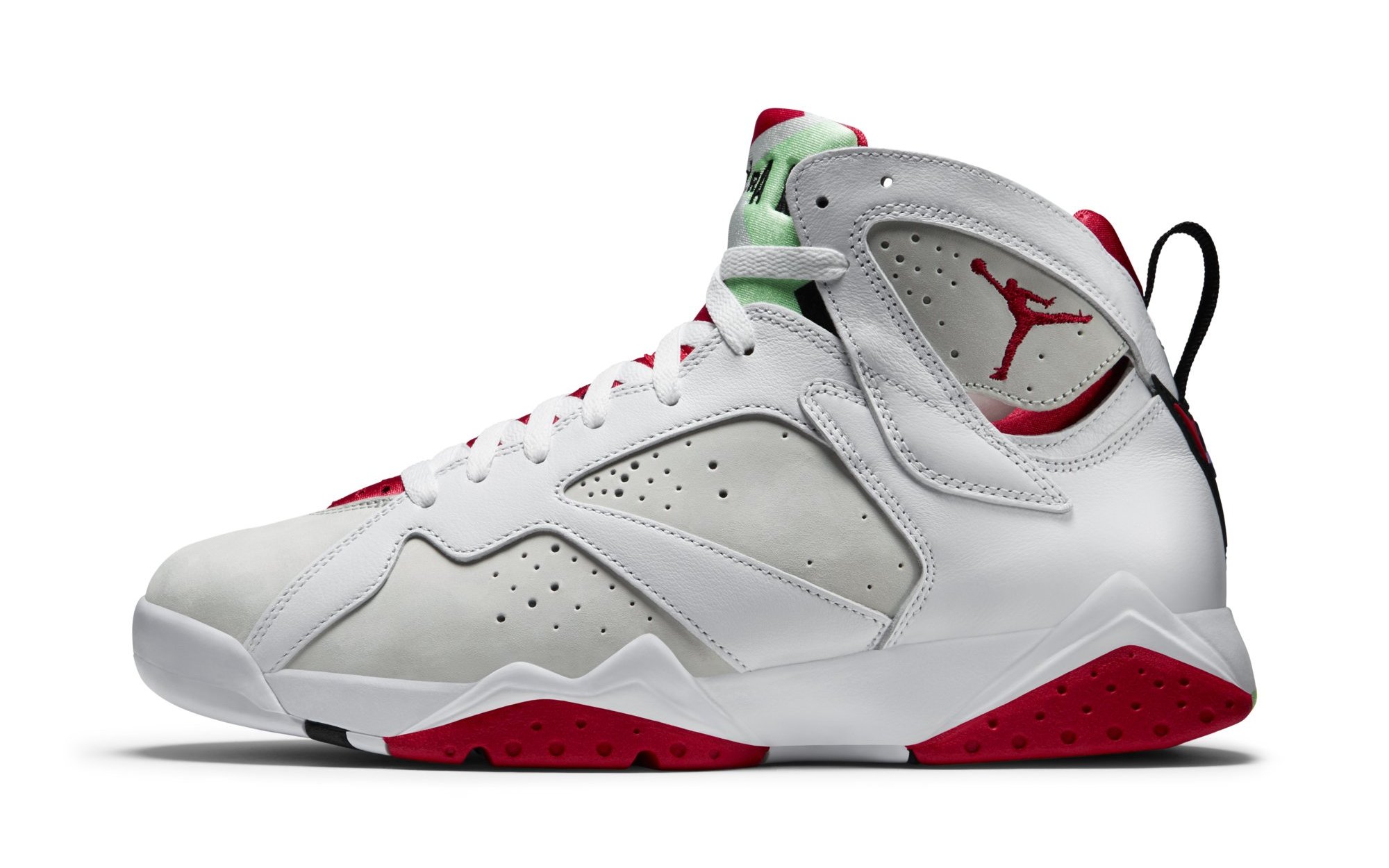
Year First Released: 1992
In 1992, Nike was set to introduce a new signature shoe for Michael Jordan as a reigning NBA champion for the first time. Once again, Tinker Hatfield was placed at the helm of the line’s latest chapter. For Air Jordans 3 through 6, also designed by Hatfield, there was a noticeable effort to make each shoe feel “bigger” than its predecessor. However, from an appearance standpoint, the Air Jordan 7 didn’t follow suit. Frills such as lacelocks, side netting, visible Air, and translucent soles were absent this time around as he opted for a cleaner look.
The minimal design was no accident. Hatfield borrowed elements from another one of his creations—the Nike Air Huarache. Details such as layered build, neoprene inner bootie, and die-cut ankle were particularly reminiscent of the Nike Air Flight Huarache. The more intricate storytelling was communicated through the use of bold colors and geometric patterns positioned in key areas on the shoe, including the tongue and outsole.
By the time of the Jordan 7 launch, Mars Blackmon returned to his stoop in Brooklyn and another iconic figure stepped into his place as Jordan’s marketing partner-in-crime—Bugs Bunny. Together, along with the rest of the Looney Tunes, they released a series of “Hare Jordan” animated commercials, which laid the groundwork for what eventually became Space Jam. Bugs was even given his own colorway of the shoe, a white and red version simply known as Hare. The shoe’s pop culture relevance also extended to music, with Jordan wearing the Bordeaux colorway in Michael Jackson’s video for “Jam.”
Jordan eventually won his second championship and a bevy of other NBA accolades in the Jordan 7, but the events that unfolded during the summer of ‘92 are what defined the model’s legacy. He and the best players in the NBA were assembled as part of the USA Dream Team sent to Barcelona to compete in the Olympic games. Jordan wore the Olympic colorway as the rockstar lineup made easy work of the competition in Spain en route to a gold medal. By summer’s end, it was never more clear that Michael Jordan was a global star and Air Jordan was a global line. –Brandon Richard
32. Nike Zoom Kobe 6
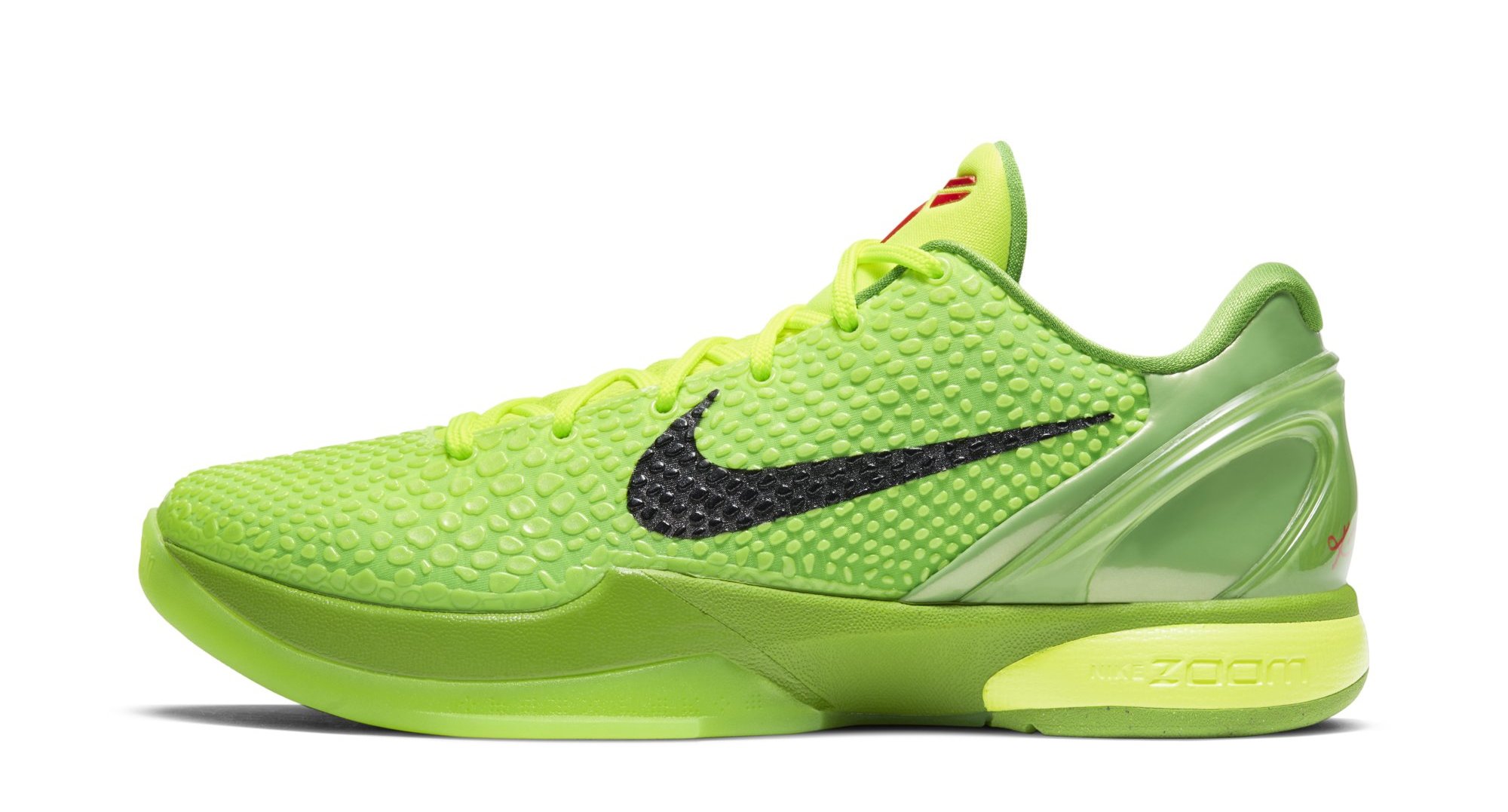
Year First Released: 2010
The concept of the low-top signature basketball sneaker as we know it started with Gilbert Arenas’ Adidas Gil Zero in 2006 and was popularized by the Nike Zoom Kobe 4 when it launched in 2008. But it didn’t reach its final boss form until the Nike Zoom Kobe 6 released in late 2010.
The model utilized much of what made its two predecessors so popular and amplified them with a Flywire-based snakeskin upper, carved out external heel counters, a pliable foam-based insole that molded to the wearer’s foot, and a sticker traction pattern. These elements combined for a fully realized iteration of what a low-top basketball could be without the distracting and limiting gimmicks of its successor’s interchangeable cut and cushioning systems.
“Like a Porsche you don’t change the whole car, you choose your spots,” said Tom Luedecke, who helped design and develop the shoe, to Sole Collector back in 2010. “One year it’s the transmission, one year it’s the motor. That’s how we approached it this year.” It was that evolution that landed the Kobe 6 right in the sweet spot.
Its weight, or lack thereof, was another highlight; clocking in at just 10.5 ounces in a size 9. It arrived during an arms race to the bottom in terms of performance basketball sneakers, just before Adidas dropped the sub-10-ounce Crazy Light the following year.
Interestingly, the Kobe 6’s most iconic colorway—the bright green model worn by Bryant on Christmas Day in 2010, was never intended to be a “Grinch” theme. “Green Mamba was the inspiration and that’s sort of tongue-in-cheek to‘Black Mamba of course,” Luedecke explained. “We couldn’t just do an all-black shoe or everyone would say ‘Oh, that’s the Black Mamba, duh.’ [Laughs.] We have that in the back pocket so why play that card if you want to have fun? We had ‘Green Mamba,’ and two, it’s Christmas. If you hold this shoe up a certain way, it could look like a Christmas Tree.” –Zac Dubasik
31. Nike ACG Air Mowabb
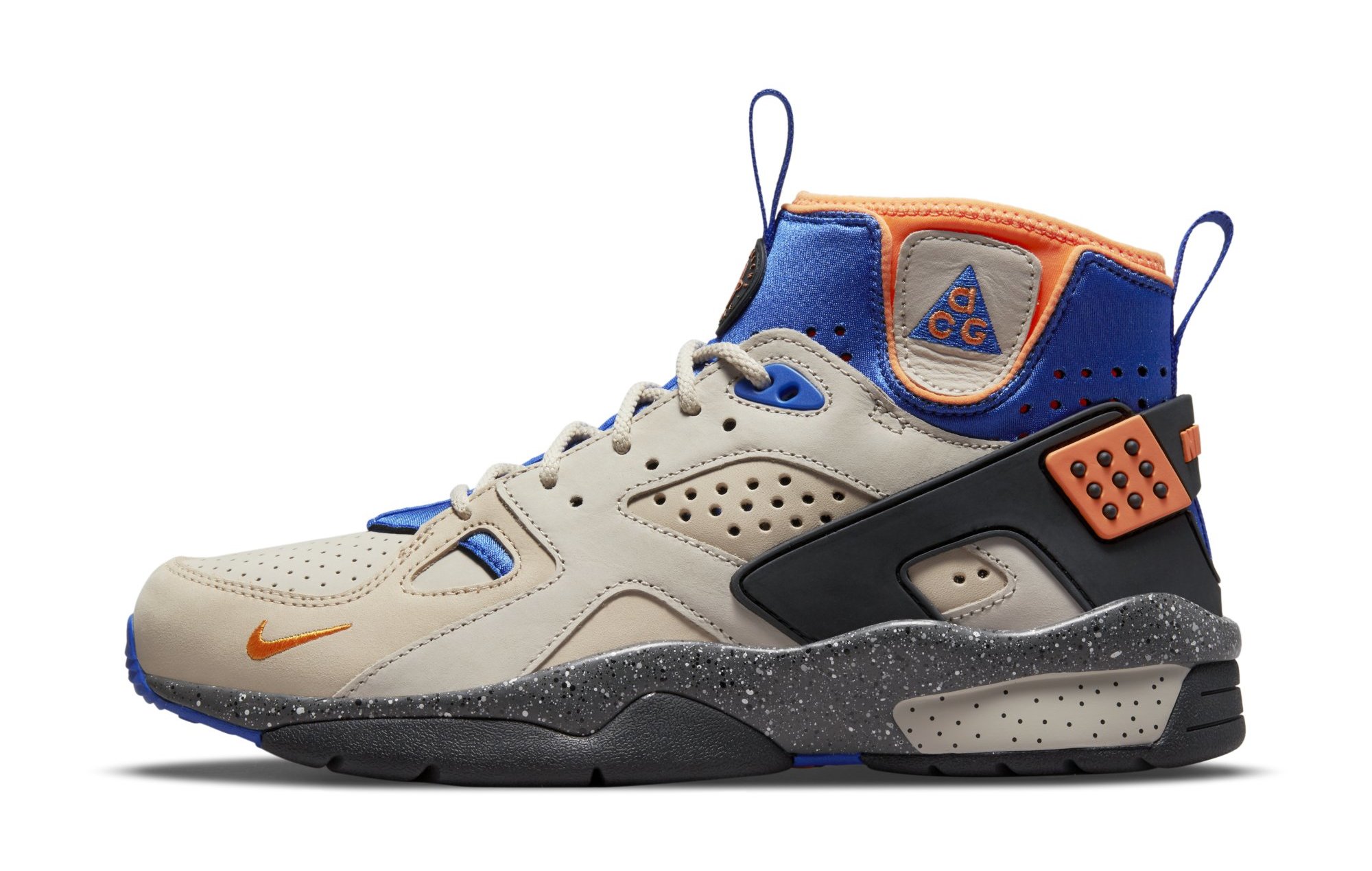
Year First Released: 1991
Nike designer Tinker Hatfield’s original 1990 Mowabb concept sketch has the phrase “the great outdoors with an athletic twist” inscribed on the bottom in his signature handwriting. The Mowabb has gone on to become the quintessential representative of the Nike ACG line. It was truly groundbreaking for its time—flipping the script on traditional hikers and creating a multi-purpose outdoor crosstrainer that looked unlike anything else before it. Part of its visual appeal lies within its moccasin-inspired upper that includes sweeping cuts of layered leather, rugged speckled midsole, rubberized heel-counter and most importantly—the Huarache neoprene inner-bootie.
It’s a shoe that is just as comfortable on a hiker’s foot on the trails of Moab, as it was on Jerry Seinfeld’s traversing the streets of Manhattan, the perfect blend of form and function. The Mowabb’s original run lasted two cycles that included 4 original colorways and two “Mowabb Plus” colorways that featured updated materials and functional pull-tabs (much to the joy of everyone struggling to get their foot through the Huarache sleeve). The colorways feature earthy tones mixed with vibrant accents, underscoring “the great outdoors with an athletic twist” mantra.
The Mowabbs were retroed a handful of times throughout the early and mid-2000s, but really came into their own and tapped into their true lifestyle potential over the past few years as collabs with Olivia Kim and Comme des Garçons helped extend the silhouette further off the trails.
One of the things Tinker’s original sketch also had was a note to include Pendleton material. While that didn’t make the original incarnation in 1991, his vision did come to life as a Bodega and ComplexCon exclusive, as well as a Nike ID option in 2017.
Nike dialed the Mowabb energy up a notch in 2021—releasing four of the OG colorways along with a handful of new ones—including the addition of two pull-tabs and a mini-Swoosh on the forefoot, much to the chagrin of OG purists. –Kevin Luyster
30. Nike Air Max2 CB 94
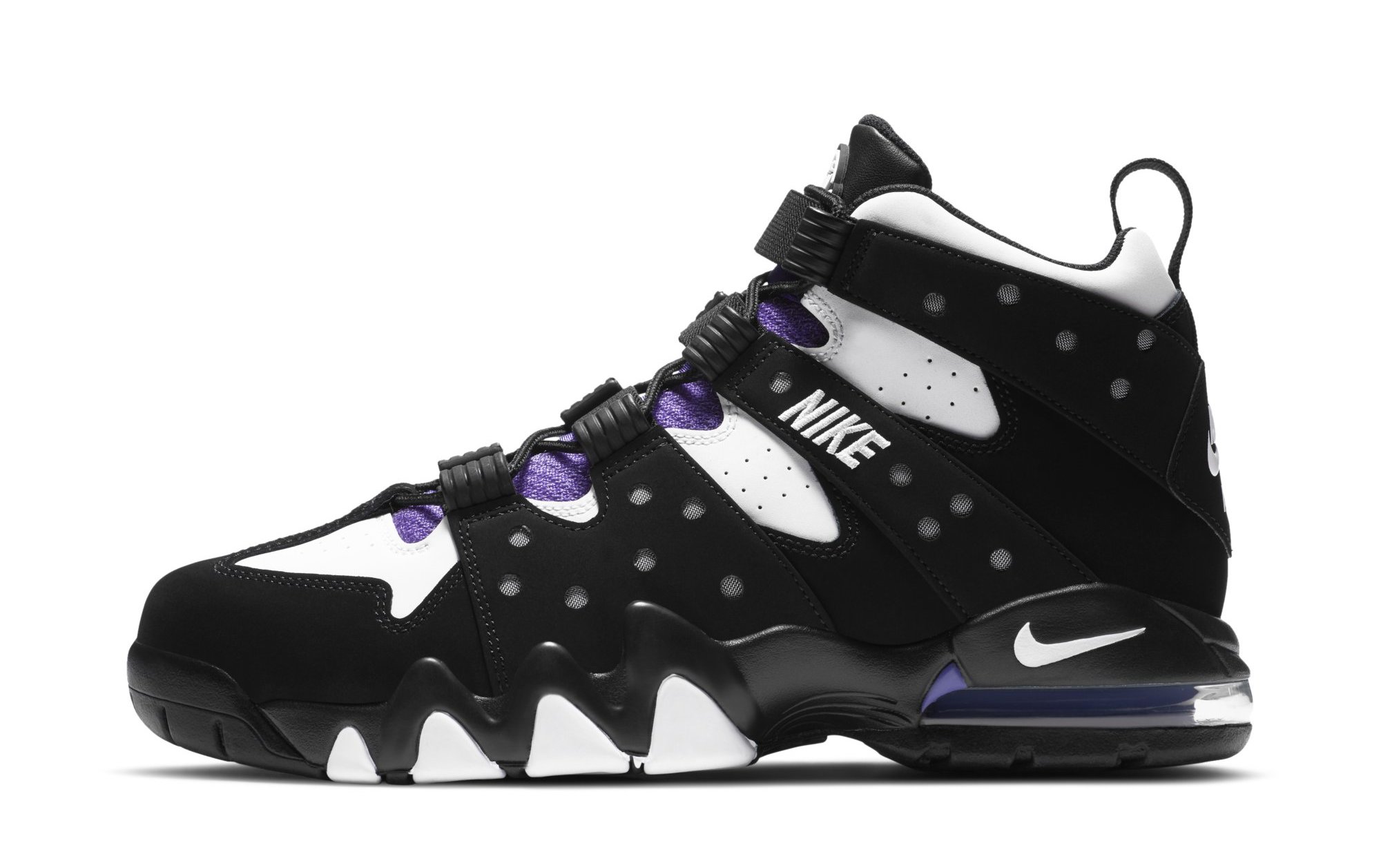
Year First Released: 1994
If one were to rank Nike’s signature basketball lines, they’d be remiss to omit Charles Barkley. Best known these days for his commentary as an analyst on Inside the NBA, Sir Charles was once one of the most dominant forces in the league. During the late 1980s and early ‘90s when the sport revolved around big men (and MJ), Barkley held his own as a 6-foot-6 power forward, leading the NBA in rebounds in 1988, earning MVP honors in 1993, and being selected for 11 straight All-Star Games.
He did all of this while wearing Nike footwear, including a handful of models that have maintained loyal fan followings throughout their retro histories. The most significant though, is the Air Max2 CB 94. As its name suggests, the sneaker was originally released in 1994, a year in which Barkley struggled with injuries yet managed to put up consistent numbers.
The shoe itself took pages from Barkley’s on-court intensity, integrating straitjacket-inspired elastic straps with the lace system for lockdown. Its 180-degree Air Max2 unit represented Nike’s souped-up “Air Max Squared” cushioning, while the sole’s jagged outrigger took on the look of teeth. Even the eyelets were reinforced with plastic, giving the hoops shoe a decidedly boot-like ruggedness. The aggressive high-top’s design was led by Tracy Teague, the Nike designer also responsible for Ken Griffey Jr.’s most memorable sneakers.
While Barkley’s sneaker history can’t be condensed to just one model (even his “unofficial” signature shoes like the Air Force 180 hold weight), the Air Max2 CB 94 has an edge due to its lasting appeal and relevance. In 2003, before sneaker culture really took off, Nelly used the shoe for his “Air Derrty” collaboration. The design also served as the base for 2013’s Barkley Posite Max, a mash-up model that gave the shoe visibility to a new generation. These days, the Air Max2 CB 94 remains coveted, with OG general release colorways regularly selling out and flipping for hefty premiums. –Riley Jones
29. Nike LeBron 8
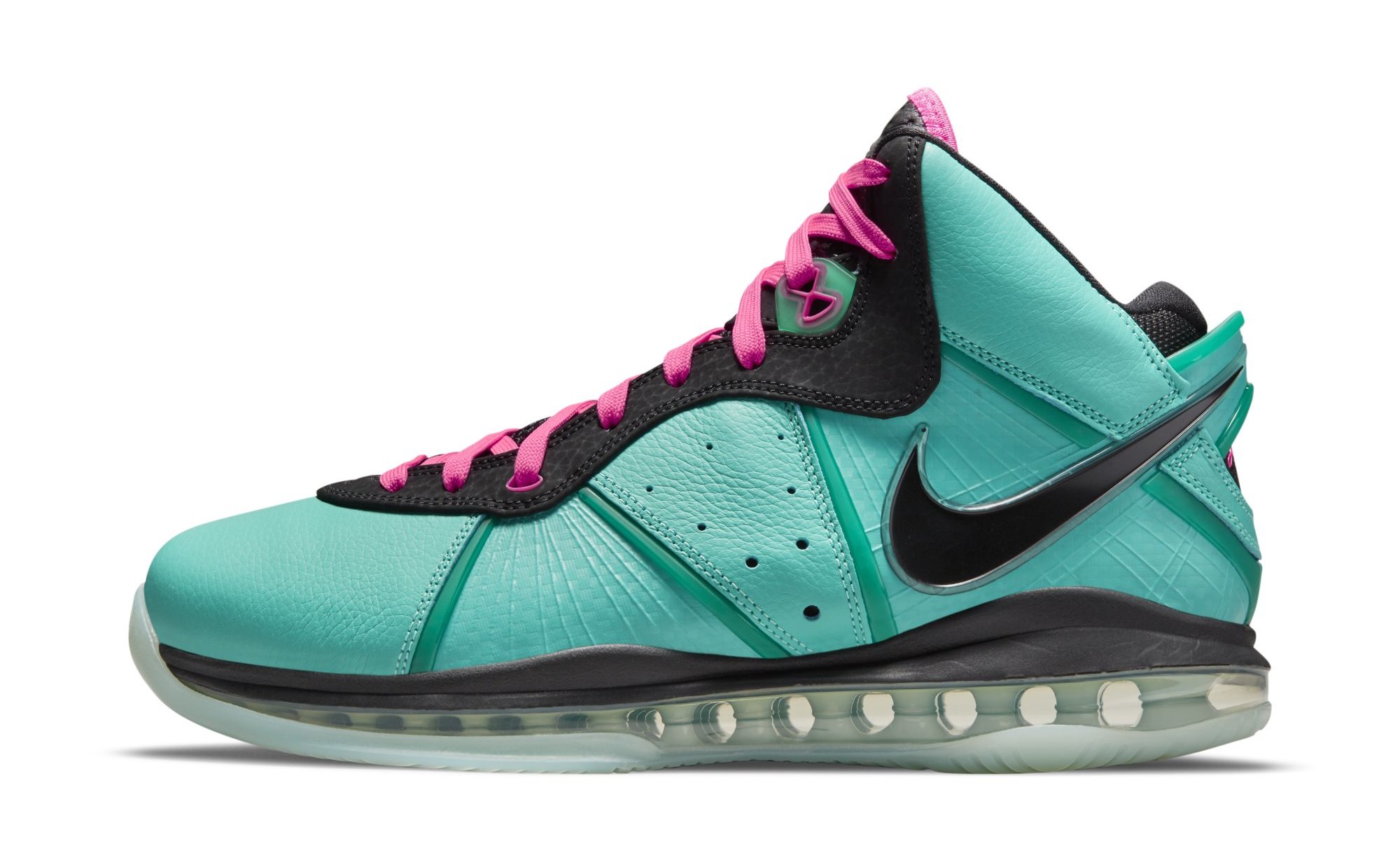
Year First Released: 2010
“I am not a role model,” said LeBron James as he bit a strawberry-frosted doughnut. It was part of his latest commercial, his first as a member of the Miami Heat. The statement echoed Charles Barkley, who made the same remark in his infamous 1993 Nike ad. James has just taken his talents to South Beach after seven years as Cleveland’s hometown hero. He had been turned into the NBA’s biggest villain overnight. And he had to fit the part. This new persona (which, let’s be honest, never really quite fit him) accompanied the debut of the LeBron 8.
Designer Jason Petrie’s mission was creating a sneaker that helped define LeBron’s new era. But he didn’t completely overhaul the LeBron’s sneaker line. The 8 borrowed elements from the LeBron 7, like a 360 Air Max bag and use of Flywire reinforcements throughout the upper. It would end releasing in three unique variations throughout the 2010-11 season–a V1 with leather uppers and suede overlays, V2 that replaced the more premium textiles with a breathable synthetic upper, and the V3, reserved for postseason play, which got even lighter (an ounce lighter, to be exact).
“We just wanted to create a silhouette that, on the shelf, didn’t look like anything else,” designer Jason Petrie told Complex for its Sneaker of the Year book. “You can notice it from 100 yards away just because of that.”
If the silhouette wasn’t enough, Nike made sure that we would all take notice of its latest creation for its biggest athlete. On Oct. 16, 2010, the “South Beach” LeBron 8, a Miami Vice-inspired pair with a Filament Green leather upper and hot pink laces, hit stores. The pair had the sneaker world in a frenzy and was undoubtedly the biggest release of that year. Over 10 years later, it’s seen as a defining moment for not just the LeBron line, but a moment that laid the foundation for modern sneaker culture. –Mike DeStefano
28. Nike Air Penny 2
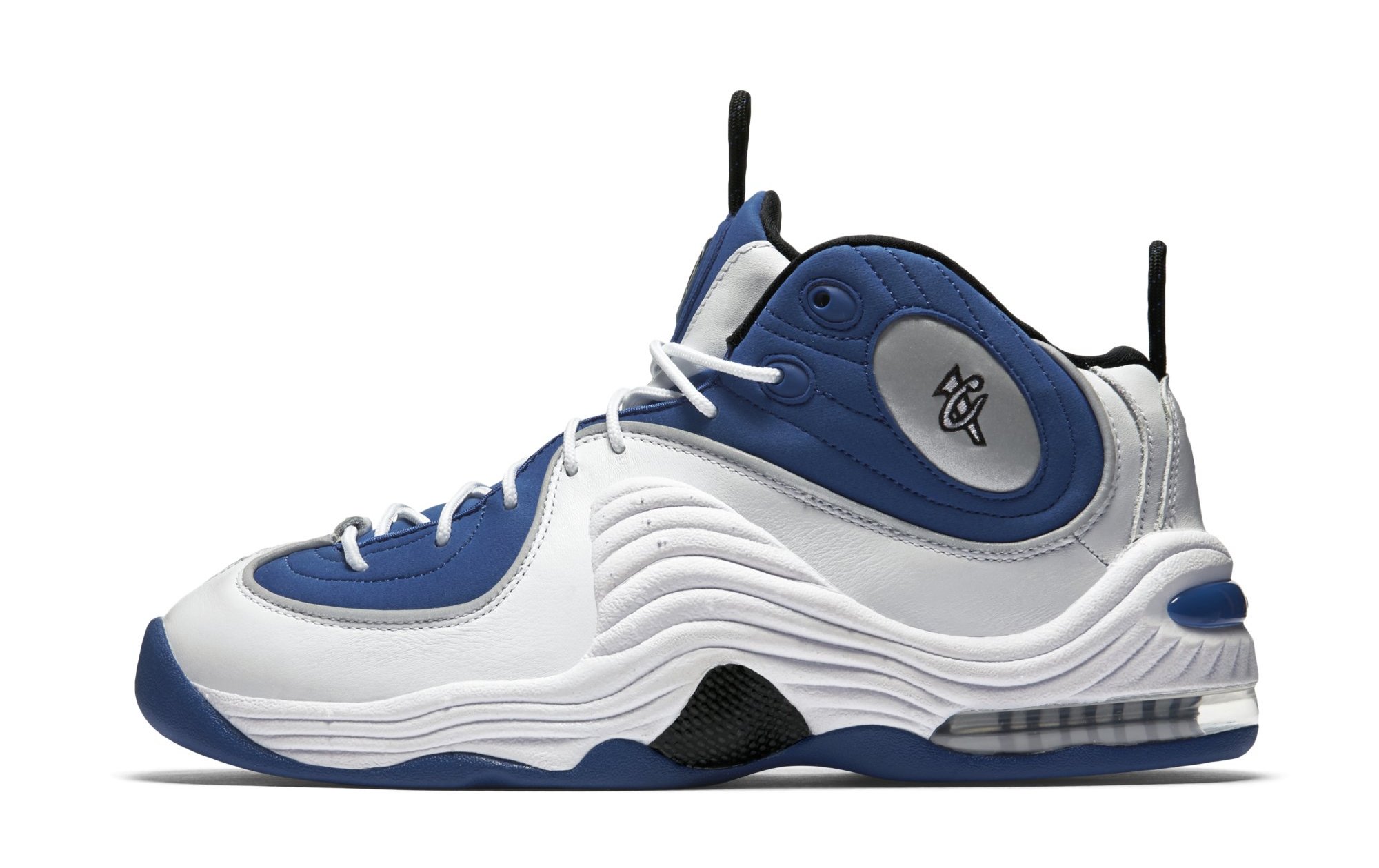
Year First Released: 1996
The 1996-97 season truly marked a new era in Orlando. Following Shaquille O’Neal’s shocking departure to Los Angeles, the Magic was unquestionably Penny Hardaway’s team. After three years of sharing the stage with one of the NBA’s biggest personalities, it was now time for his star to shine alone.
While things had drastically changed basketball-wise for Hardaway, there was a lot of stability in the development of his second signature shoe, the Nike Air Penny 2. Once again, Eric Avar took on the role of lead designer following the success of the Air Penny 1. Often, the most challenging part of having an extremely successful debut signature sneaker is developing a worthy sequel that garners similar fanfare. For example, the Air Jordan 2 has picked up a niche following over the years, but it’s struggled to ever come close to matching the wide appeal of the Air Jordan 1. So, with the Penny 2, Avar’s mission was simple—take everything that worked the first time and build on it.
Like the first shoe, the Air Penny 2 was mid-cut silhouette that featured durabuck, suede, and full-grain leather builds. The dynamic cushioning setup of forefoot Zoom Air and heel Max Air, debuted in the Penny 1, was retained. Perhaps the defining Air Penny detail, the lateral Phylon wing, was utilized again, this time featured more prominent than before. Reflective 3M panels and a topographic-style traction pattern were new details, but the Penny 2 was generally a shoe that just looked like the Penny 1 grew up. Truly a seamless progression from its predecessor.
Also consistent was the usage of mascot Lil’ Penny, who was back and “bigger” than ever for a new series of commercials. The pint-size puppet, often laced up in miniature Air Penny 2s, revved up the antics, joining Penny for an imaginary detective movie, making music in the studio with Kevin Garnett, throwing pool parties, and, of course, continuing his pursuit of Tyra Banks. Together the duo proved to have staying power as a marketing powerhouse.
The Air Penny 2 was an example of the old adage “if it ain’t broke, don’t fix it.” From the design of the sneaker to the marketing behind it, everything was a seamless transition from its predecessor, continuing to lay the foundation for one of the all-time great signature sneaker lines. –Brandon Richard
27. Nike Air Trainer SC High
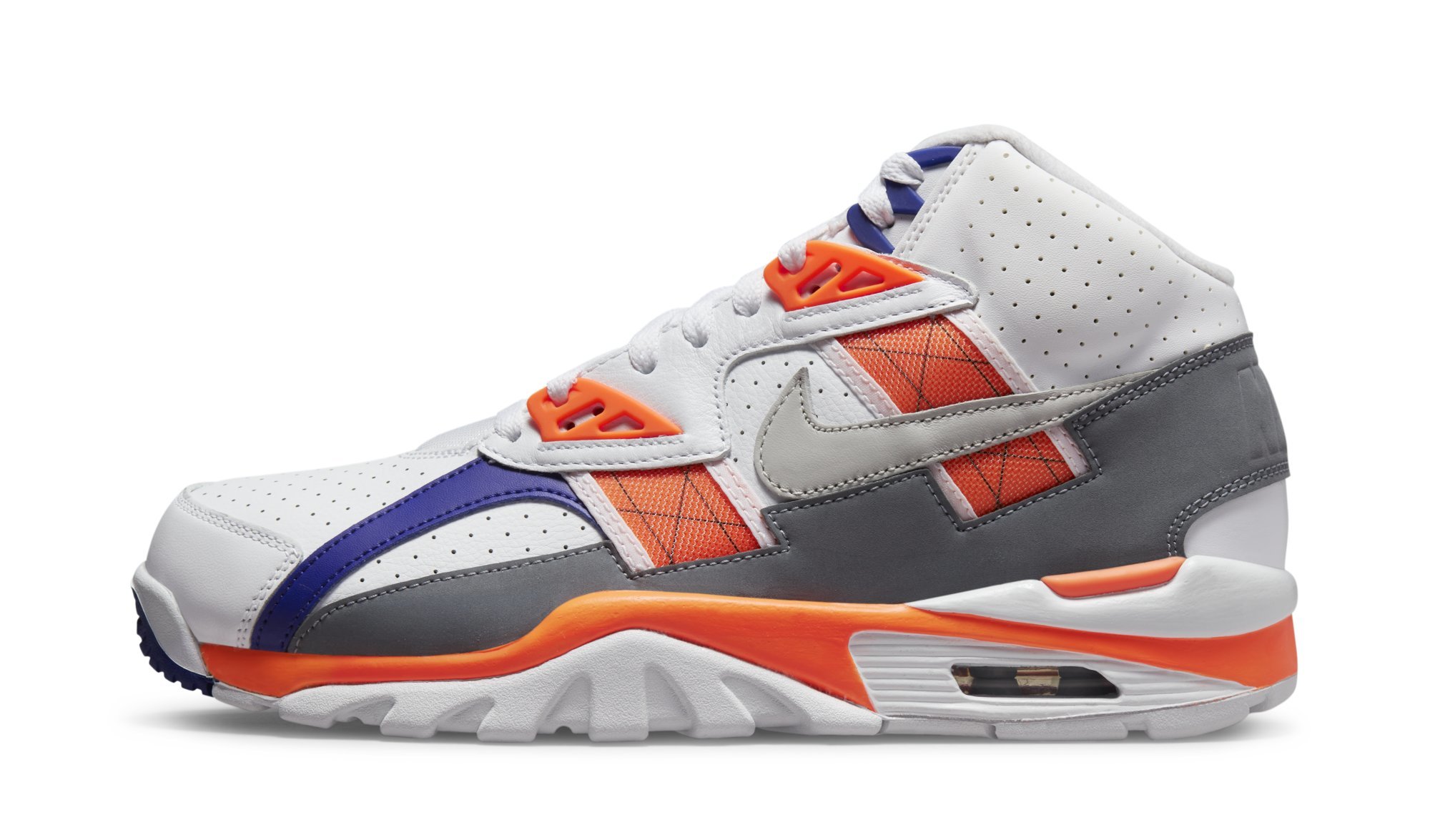
Year First Released: 1990
Aside from the Air Jordan line, Bo Jackson’s Air Trainer may be the best example of Nike’s product design and unrivaled advertising working together in perfect harmony. Although it wasn’t a signature shoe by today’s standards, the Tinker Hatfield-designed Air Trainer SC was Bo Jackson’s sneaker, through and through.
Released in 1990, the Air Trainer SC High was the third Air Trainer SC iteration to be released. Picking up where 1988’s Air Trainer SC (best known for its “Medicine Ball” colorway) and 1989’s Air Trainer SC (referred to as the Air Trainer SC 2 today) left off, the 1990 model opted for an even higher cut than its predecessors and also removed their distinct midfoot support straps for what could be considered a cleaner look. Instead, its lockdown came by way of an ahead-of-its-time technology dubbed Web-Tec (used to a lesser degree on the Air Trainer SC 2) that functioned similarly to Flywire of the 2010s. It came in a handful of memorable original colorways, but it’s the white, orange, and blue “Auburn” combination inspired by Jackson’s alma mater that remains the model’s definitive make-up.
Bo’s dual-sport stardom combined with Hatfield’s idea for multipurpose cross-trainers made for the perfect marketing marriage. Longtime Nike agency Wieden+Kennedy were responsible for the numerous “Bo Knows” ads, which played up Jackson’s talents to excel in baseball, football, basketball, tennis—and just about everything else. The ad originally debuted during the 1989 MLB All-Star Game and was revisited with new variations in the early ‘90s. In one of the clips, the aforementioned “Auburn” SC Trainer Highs are featured seconds in, scoring them a permanent place in footwear history.
The Air Trainer SC High’s legacy has been somewhat of a mixed bag. “Auburn” releases are usually well received, but recent executions of pairs like the “Raiders” have left something to be desired. There’s also a few original colorways that have still yet to receive proper re-releases all these years later. Overall though, the brand has mostly given the silhouette the attention it deserves. –Riley Jones
26. Nike Mag
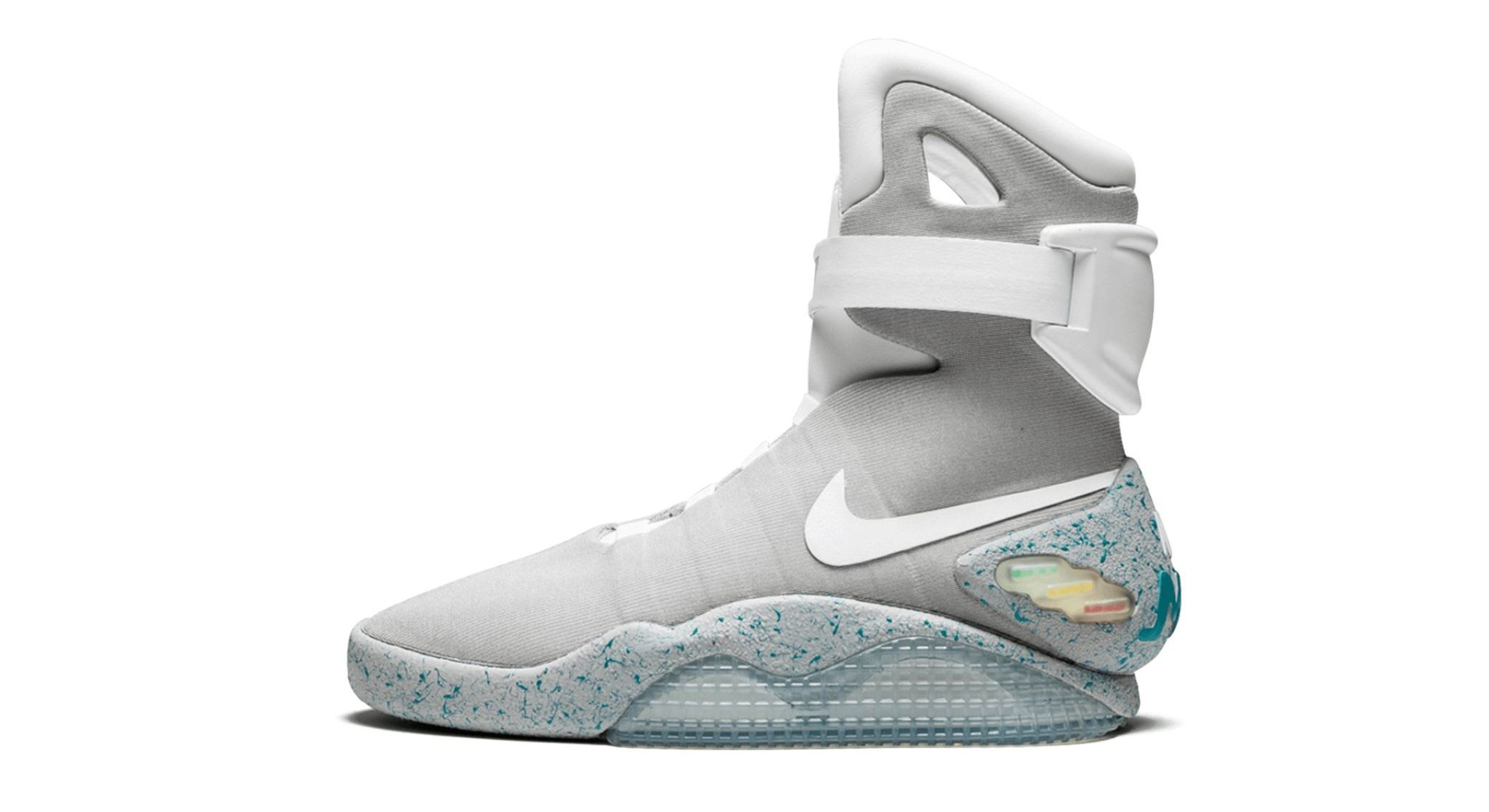
Year First Released: 2011
For 22 years, the Nike Mag was merely a prop. The self-lacing high-top sneakers were worn by Michael J. Fox’s time-traveling character Marty McFly in 1989’s Back to the Future II, marking the first time Nike ever designed a sneaker specifically for a movie. In the film, the Mag served as a representation of what footwear could be like in the distant future. However, the thing about the distant future is that it always seems to arrive sooner than expected. For the Mag, that sooner arrival came in 2011.
During September that year, Nike revealed that it had quietly been working on making the Mag a reality, unveiling a somewhat mass-produced “retro” of sorts that came equipped with a power-charged lighting system. For the project, Hatfield was joined by Nike senior innovator Tiffany Beers, who had a reputation for pushing boundaries with technology implementation. The company listed 1,500 pairs of Mags on eBay, raising $6 million for the Michael J. Fox Foundation for Parkinson’s research. As incredibly satisfying as it was for the shoe to finally be a reality there was still work to be done as long as it didn’t lace itself.
During an event in February 2014, Hatfield confirmed that we’d see a version of the Mag with power lacing. Specifics weren’t announced at that time, but it was widely speculated that the wait wouldn’t be long as Oct. 21, 2015 was the date that McFly traveled to in the future and wore the Mags—and Nike doesn’t miss out on those types of moments. Sure enough, Nike invited Fox to an event on that exact date and presented him with the very first pair of auto-lacing Mags. It was also announced that a limited-edition run of the auto-lacing version would be made available via raffle in Spring 2016, with proceeds once again going to the Michael J. Fox Foundation for Parkinson’s Research.
Less than 100 pairs were made available to bid on through a modified version of Nike’s draw system in which users could purchase an unlimited amount of entry tickets for $10 each. Despite the lower quantity, the raffle raised another $6.75 million for Parkinson’s research.
The technology utilized in the functional Mag evolved into what became known as Nike Adapt, spawning a range of auto-lacing sneakers such as the HyperAdapt, Adapt BB, and Adapt Auto Max. We’re not quite ready for hoverboards and flying cars, but Nike delivered on its promise of what the future could hold. –Brandon Richard
25. Air Jordan 12
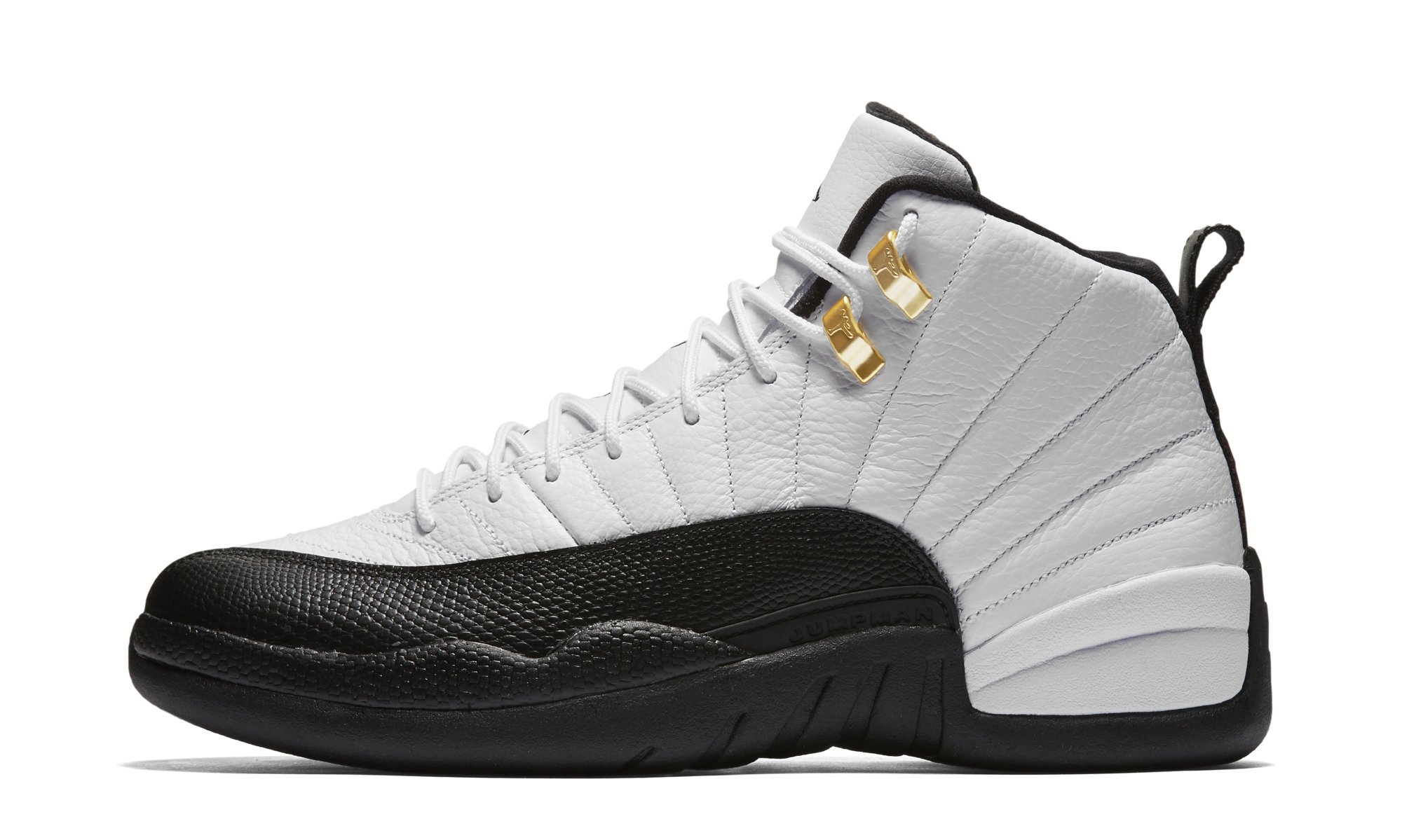
Year First Released: 1996
With the Air Jordan 12, Nike and Tinker Hatfield had the challenge of living up to the commercial and cultural success of the Air Jordan 11. There’s a natural temptation to follow up flashier designs with something equally boundary-pushing, but Hatfield showed restraint and took a more sophisticated approach to the Jordan 12, as Michael Jordan was transitioning into a full-fledged businessman off the court.
Working closely alongside Jordan, Hatfield looked to Japan for inspiration. His primary muse for the Jordan 12 was unexpectedly a 19th-century Japanese women’s dress shoe. Additional details, such as the parallel lines that run throughout the upper, were drawn from the “Rising Sun” version of the country’s flag, which would stir up some controversy down the line. According to Hatfield, Jordan had no hangups with the shoe being derived from women’s footwear because he considered himself a purveyor of fashion and was only concerned about the shoe looking good.
Much like that dress shoe, the Jordan 12 had a premium look and feel. It was purposely designed asymmetrically, which Hatfield believed gave it a sophisticated and aggressive look. Supple full-grain and reptilian-textured leathers were used on the upper. Gold-plated upper eyelets added to the luxury aesthetic. On the performance side, it was the first Air Jordan equipped with Zoom Air cushioning. An improved version of the carbon fiber shank that debuted in the Air Jordan 11 was added for enhanced support and responsiveness. The model is often heralded as the most durable Air Jordan ever made.
The Jordan 12 was originally released in five colorways; two white-based pairs for home games, two black-based pairs for away games, and an alternate “Obsidian” make-up. Of course, the most iconic pair in the group is tied to arguably Jordan’s most memorable single-game performance—Game 7 of the 1997 NBA Finals, a.k.a. the “Flu Game.”
The bold black and red colorway was on Jordan’s feet as he gutted his way through the flu (or possibly food poisoning if alternate theories are to be believed) for a 38-point performance in a series-shifting victory. He wore the black and white “Playoffs” colorway to help clinch the Bulls’ fifth championship in Game 6.
Jordan Brand was announced as its own sub-brand in September 1997, making the Jordan 12 the last Jordan flagship model released directly under Nike. In addition to being yet another championship sneaker for Jordan, the shoe represented the idea that taking a step back is sometimes necessary to make progress. By not trying to one-up the Jordan 11, Hatfield and Jordan created a sneaker that stands on its own as one of the most revered models in the Air Jordan line. –Brandon Richard
24. Nike Air More Uptempo
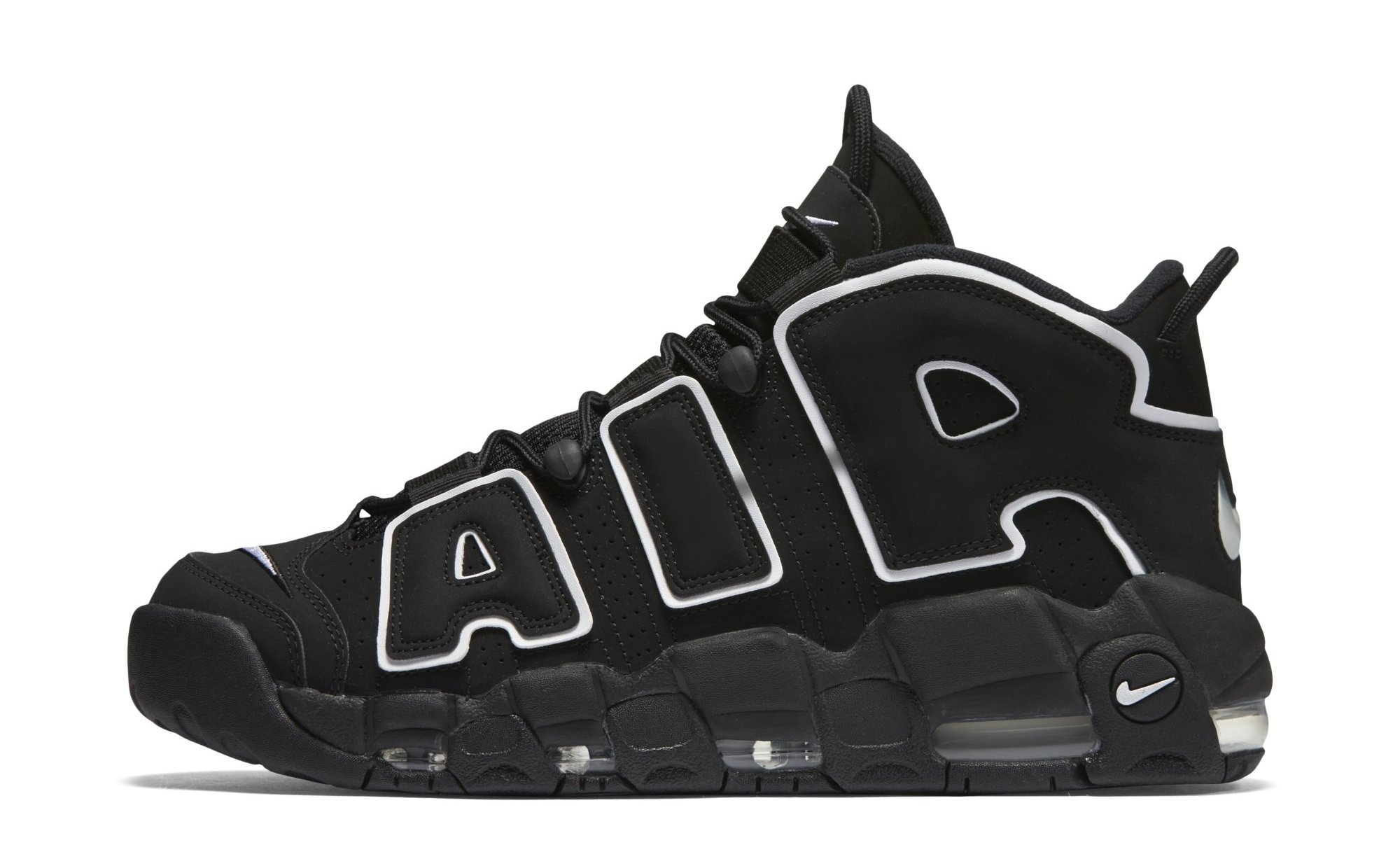
Year First Released: 1996
Few sneakers are as immediately recognizable from a distance as the Air More Uptempo. The 1996 model was designed by Wilson Smith, Nike’s first Black footwear designer, and stands as his most iconic creation.
On the court, the Air More Uptempo was made famous by Scottie Pippen. MJ’s right-hand man wore the in-your-face sneakers sporadically during ’96, most notably during the NBA Playoffs (where the Chicago Bulls won the first championship of their second three-peat) and later that summer as a member of the U.S. men’s Olympic team (aka “Dream Team III”). While not an official signature sneaker, it’s one of those pairs that’s been so closely tied to a specific athlete, plenty of people out there still call them the “Pippens.”
“I was pretty shocked,” Pippen said of his first time seeing the sneakers in a 2017 Nike interview. “I thought it was a little overwhelming. But I felt like it was something I could handle on the basketball court because I was very confident in the way that I was playing and the way that my career was going. It was something I was willing to step out in.”
The shoe famously features massive “AIR” lettering in all caps across both sides and true to its name, used a heel-to-toe visible Air bag underneath. To drive the maximalist theme home, Wilson’s sketches show that at one point the shoe was destined to be called the Nike “Air Biggest.” The designer was inspired by graffiti, pop art, and architecture when conceptualizing the sneakers and their bold branding.
Nearly 30 years later, the Air More Uptempo is arguably as relevant as ever. It was used in a 2017 collaboration with streetwear brand Supreme (which replaced the signature lettering with—what else?—a “SUPREME” spell-out. The Air More Uptempo’s lettering style was also repurposed by Cactus Plant Flea Market for a 2020 Air Force 1 collab. And despite dozens of new make-ups throughout the years, retro releases of original colorways almost always sell out. –Riley Jones
23. Nike Air Max Plus
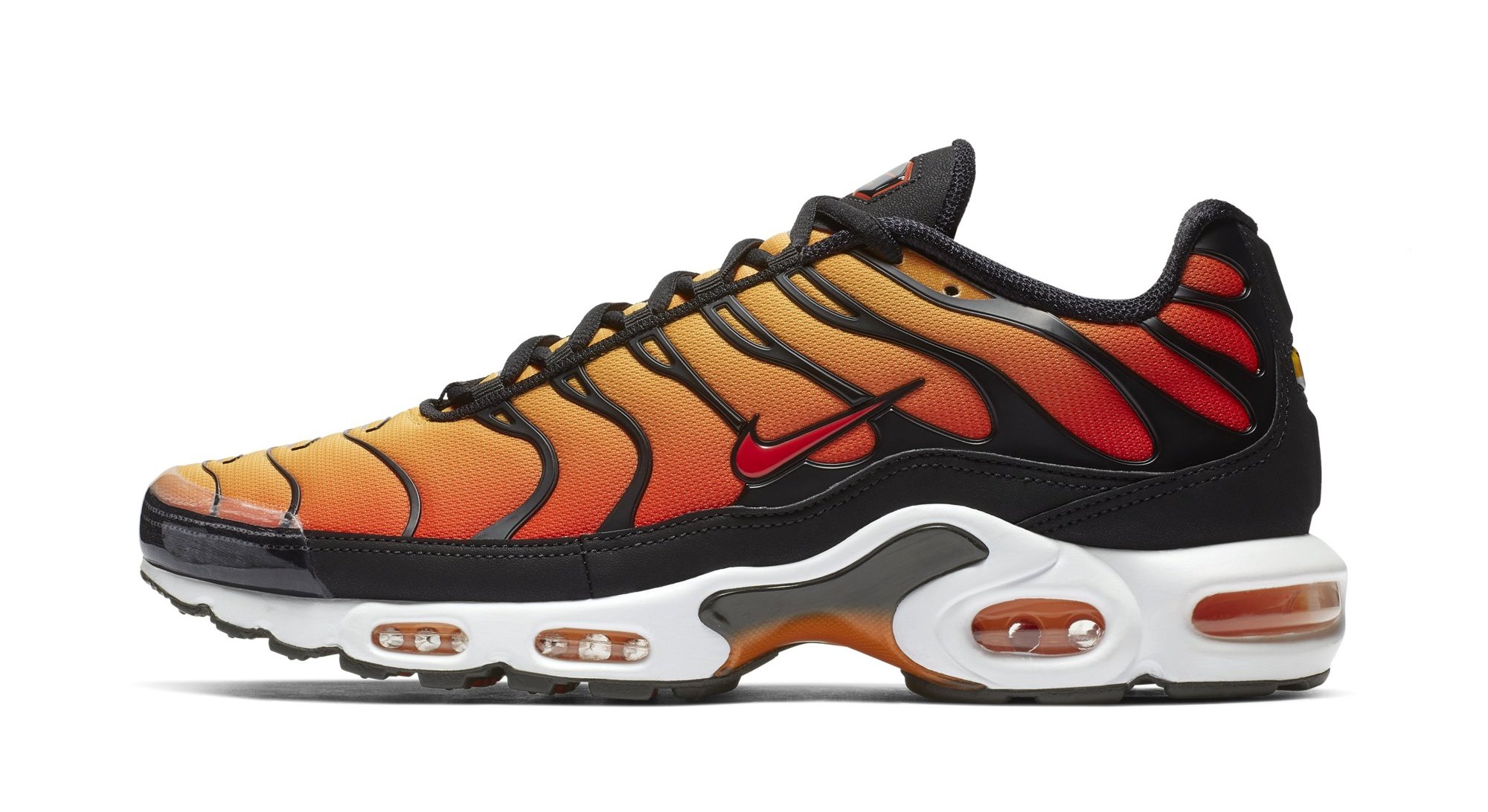
Year First Released: 1998
Imagine walking into a Foot Locker in 1998 and seeing this thing for the first time. The Nike Air Max Plus (also known as the Air TN in reference to its Tuned Air tech in the soles) was an exclusive to the big-box retailer and actually arrived there with little explanation. The story goes that after Nike designer Sean McDowell finally settled on a version of the shoe that Foot Locker would approve, the company tested out the sneaker by putting it right on shelves without any explanation or introduction. So there it was, this wavy, aggressive Air Max shoe sitting and waiting to be discovered by teenagers being let out of school—its debut was even timed around when the last bells of a day’s classes would ring.
The Air Max Plus has been on sneaker shelves pretty consistently since, and not just Foot Locker. It’s not a mainline Air Max model per se, and is more a sibling than a successor to titans like the Air Max 1, 90, or 95, but that hasn’t dulled its impact. The original colorways, the fiery orange and watery blue, are right up there with the “Neon” 95 or the “Infrared” 90. It’s a pedestrian shoe in the best way, the kind that almost never needed limited numbers to generate excitement.
The Air Max Plus is buoyed by cult status in different geographies. It has a following in the suburbs of Paris, in the streets of London, and particularly in Australia, where the shoe historically had a somewhat nefarious connotation. Its connection to any kind of criminal activity has all but faded as the Air Max Plus became more mainstream in the last decade. It’s not the most comfortable Nike sneaker, and maybe never was a real performance model for people who were serious about running, but you can’t deny that it’s one of the best looking Nikes of all time. –Brendan Dunne
22. Nike Air Tech Challenge 2

Year First Released: 1990
Do yourself a favor and check out Andre Agassi at the 1990 French Open Final. It’s the perfect visual symphony of hot lava print, lycra denim shorts, a furious bandana-tethered mullet, and, of course, the Nike Air Tech Challenge 2. Agassi was essentially a walking Nike billboard here, but it still felt undeniably authentic. The Air Tech Challenge 2 amplified Agassi’s persona, akin to Superman donning his cape and served as a counter culture rock ‘n’ roll middle finger to the tennis status quo. Agassi wasn’t the only tennis icon sporting the ATC2—bad boy John McEnroe was the flag bearer for the slightly less vibrant “Clay” colorway—creating a nice passing of the torch transition for two of Nike’s biggest tennis stars.
The Air Tech Challenge 2 became a career-defining piece of footwear for not only Agassi, but the sneaker’s designer Tinker Hatfield. It felt like everything Hatfield touched during this era turned to gold, and not enough can be said about the lasting impact this sneaker has had that’s rippled out beyond the tennis court.
You know a sneaker has cracked into the greater culture-sphere when you have an eclectic lineup of Megadeth frontman Dave Mustaine, former President George Bush, and Tim “The Toolman” Taylor all confidently rocking the “Hot Lava” masterpiece. The Air Tech Challenge 2 was absolutely a sneaker of the times and embodied the neon energy of the late ‘80s into the early ‘90s. The masses were blessed with five ¾ cut colorways and five low-top colorways during the sneaker’s original 1990 run.
Fans of the ATC2 would have to wait 18 years to finally get a proper retro, but once the floodgates were open, a healthy flow of colorways both new and old have continuously graced the shelves over the years—with the “Hot Lava” colorway leading the charge with four separate retro releases (2008, 2014, 2016, 2019). Eagle-eyed sneakerheads will notice that the Nike Yeezy 2 features the same midsole and outsole tooling as the ATC2—a testament to the lasting impact and mold breaking design that Tinker created over three decades ago. –Kevin Luyster
21. Nike Air Presto
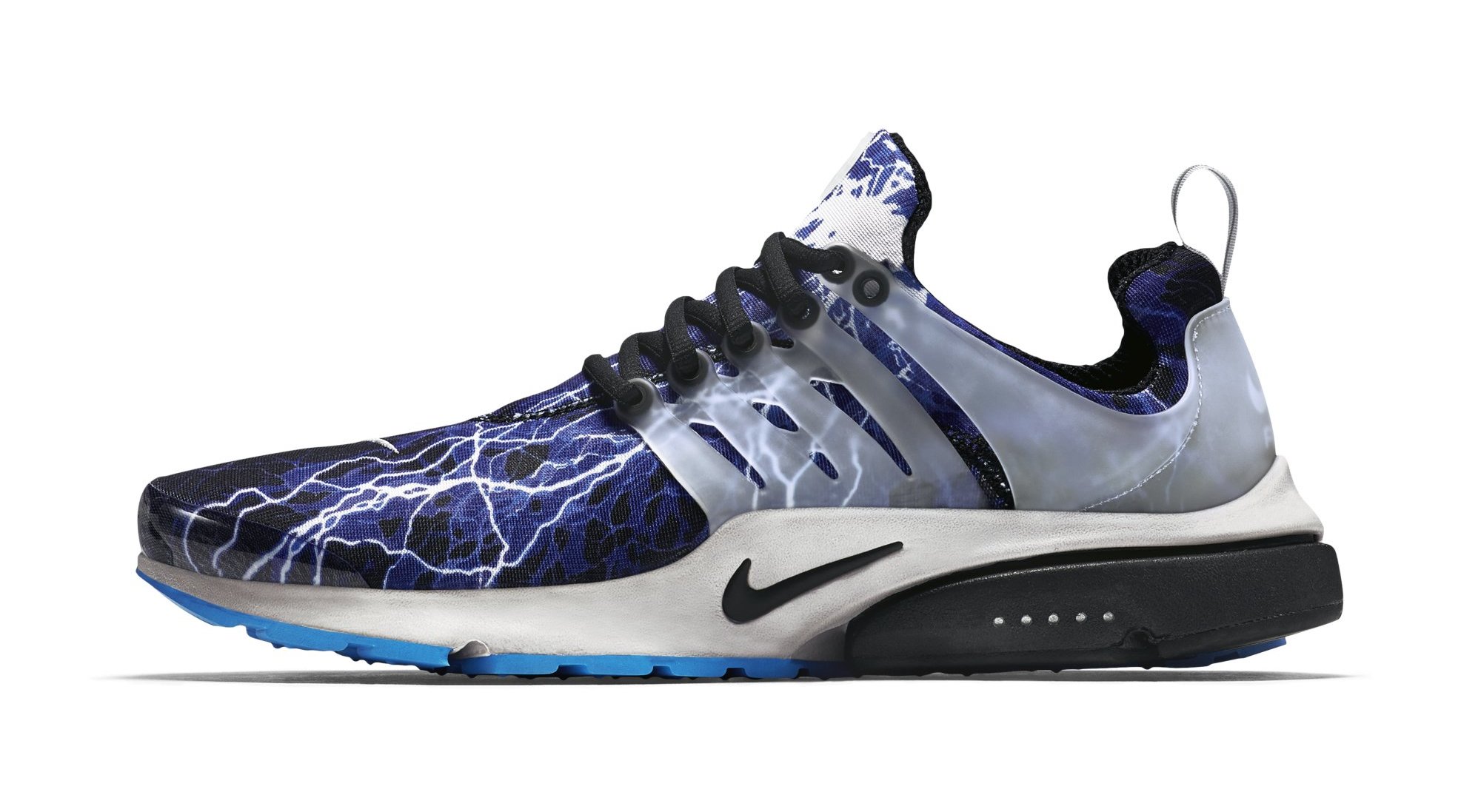
Year First Released: 2000
The success of the Nike Air Presto now spans three decades. Nike’s “T-Shirts for Your Feet” were a hit when they originally dropped in 2000, and they still maintain their relevance today, carried on in part by high-profile collaborations over the years like those by Acronym and Virgil Abloh and frequent availability on Nike’s ID and By You customization platforms.
The sneaker is widely praised for its comfort, which was the plan from the very start when the creative team featuring Tobie Hatfield began work on the model in 1996. In fact, Nike’s original name for the sneaker was the Air Comfy. After that was shut down by the Nike legal department due to its use by a New England slipper brand, future Nike CEO Mark Parker inquired how big the brand was with Hatfield. “Maybe we can entertain buying the company so we can get the name,” he said.
Hatfield’s work on the project and its resulting comfort were the outcome of the Nike veteran being left to his own devices in Nike’s first research and development facility in Taiwan. The stripped-down styling utilized pieces of material from existing models found laying around, and updated the bootie from brother Tinker’s Air Huarache with a more breathable mesh found in the medical industry. The sneaker’s design was eventually finalized by Bob Mervar, who became interested in the project after seeing Hatfield’s progress.
“I started sketching it and really what the design gesture was is sort of a scallop this way [motions forward] and a scallop this way [motions in opposite direction]” Mervar explained. “And then I thought I could connect all that to make it one message. It looked cool in parts but then I thought I could integrate it.”
Even the shoe’s original sizing convention played into its concept of maximum comfort. Rather than the standard numbering system found in virtually all modern footwear, the Air Presto initially released with a S/M/L/XL sizing scale, further playing into the “T-Shirts for Your Feet” marketing.
On top of being a hit on its own, the Air Presto also helped set the groundwork for Nike’s massively successful Free line in the mid 2000s. –Zac Dubasik
20. Nike Blazer
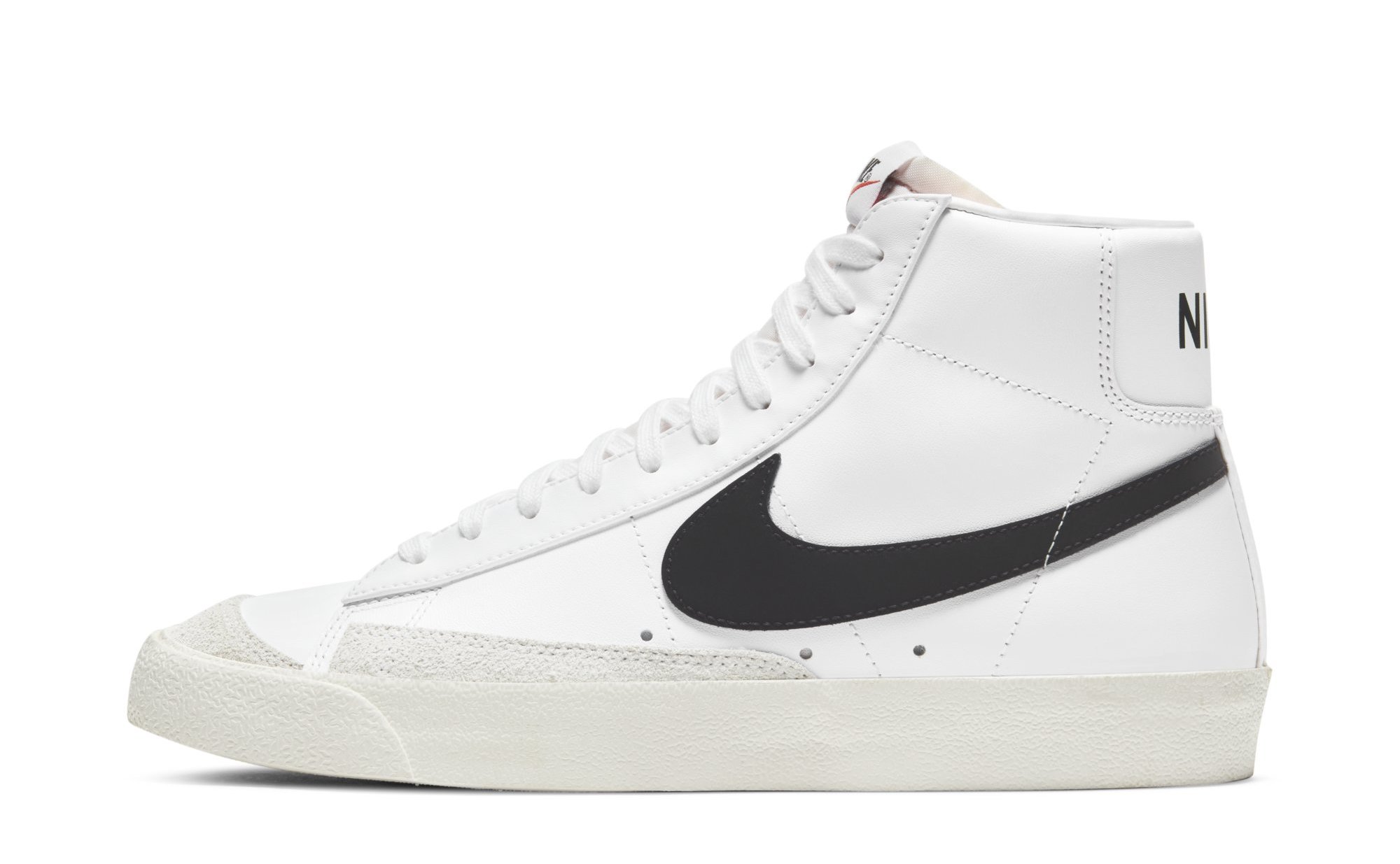
Year First Released: 1972
The Blazer does not have the retro pedigree of some of Nike’s other early basketball sneakers; it doesn’t have a particularly deep catalog of great collaboration designs to ensure it as a perennial hype model in the 21st century. It’s not been as consistently flashy as the Dunk or the Air Force 1, but it is significantly more foundational.
Alongside the Bruin (a shoe that’s been even less important as a retro and hence misses out on inclusion here), the Blazer was one of Nike’s first basketball sneakers when it was released around 1973. The sneaker was named after Portland’s Trail Blazers, the NBA team that shares its home city with Nike. It was worn most famously by George Gervin, who donned the Blazer as the Ice Man in a Nike poster that featured him sitting on a frozen throne.
Although the shoe hasn’t been in the same way the Dunk has, it’s experienced a similar trajectory in its second life. It’s been a retro staple for the past few decades, although not one that usually commanded long lineups or big resale market flips. Like the Dunk, it found a new home in the SB line, which has been the source of the most memorable Blazers—Supreme went crazy with their trio, and the “Milkcrate” is still a neckbreaker. The Blazer was also buoyed by Virgil Abloh, who redid the shoe in his first Nike collection in 2017 and came back with subsequent colorways in the year after that. More recently, the white and black one has become quietly dominant, a kind of “Panda” Dunk style that mostly slipped under the radar. The Blazer itself isn’t quite under the radar, but it’s a sneaker that’s usually been adjacent to the spotlight rather than right in it. –Brendan Dunne
19. Nike Air Huarache
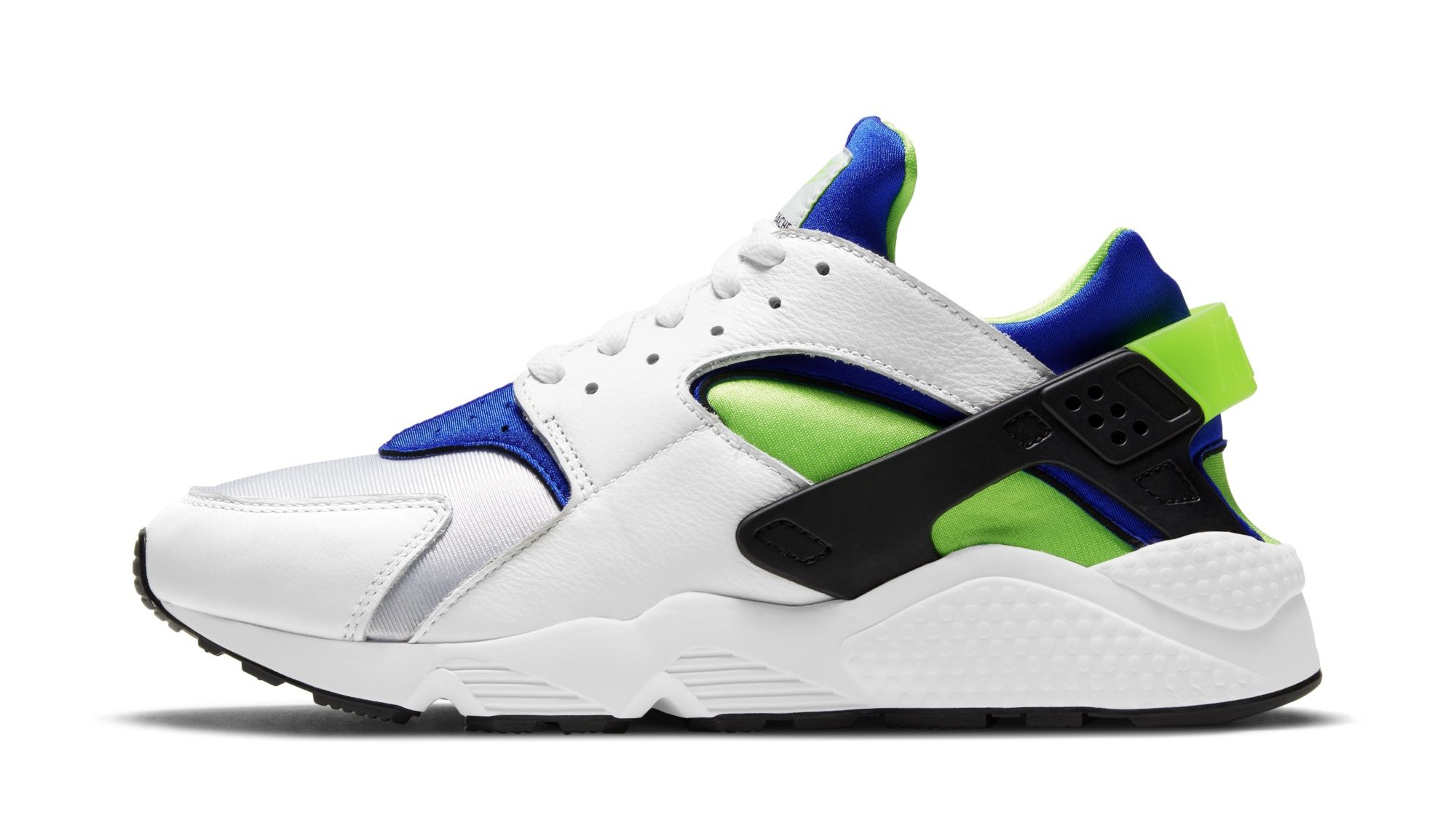
Year First Released: 1991
The thing that nobody wants to talk about when it comes to a good number of classic Nike sneakers is that the Swoosh makes the model. Whether or not you can admit it, there are a bunch of Nike sneakers out there that wouldn’t mean nearly as much to you without that logo. And it makes sense—the mark is a sportswear icon that manages to convey a hell of a lot in one sharp stroke. But good design should stand on its own sans any brand mark cheat code.
The Nike Air Huarache is one of those Nike shoes that didn’t have to scream about being a Nike shoe in order to carry the cool of a Nike shoe. The model, designed by Tinker Hatfield and released in 1991, looks like a response to the brand’s over-logoed sneakers of that era, using just one on the tongue. What the shoe lacked in recognizable ticks it made up for everywhere else—there was the neoprene inner bootie that allowed the Huarache to hug the wearer’s foot, the heel counter piece around the back to make sure the embrace was a strong one, the “Scream Green” colorway that popped with fluorescent hits.
The Huarache, a popular model in its day that’s since turned into a retro juggernaut, has a story similar to many of the boldest Nikes of the late ‘80s and early ‘90s. There were doubters—according to Hatfield, the sneaker was initially booked in by just one store, which ordered around 50 pairs. Product line manager Tom Archie, who was working on the Huarache, felt it could be much, much more, and had Nike’s factories produce an extra 5,000, despite not having the authority to up the allocation. He took those pairs to the New York Marathon and hawked them directly out of Nike’s booth, smoking through the stock expeditiously. By the end of the year, Hatfield remembers, another 250,000 were out the door. Not bad for a shoe without a Swoosh. –Brendan Dunne
18. Air Jordan 6
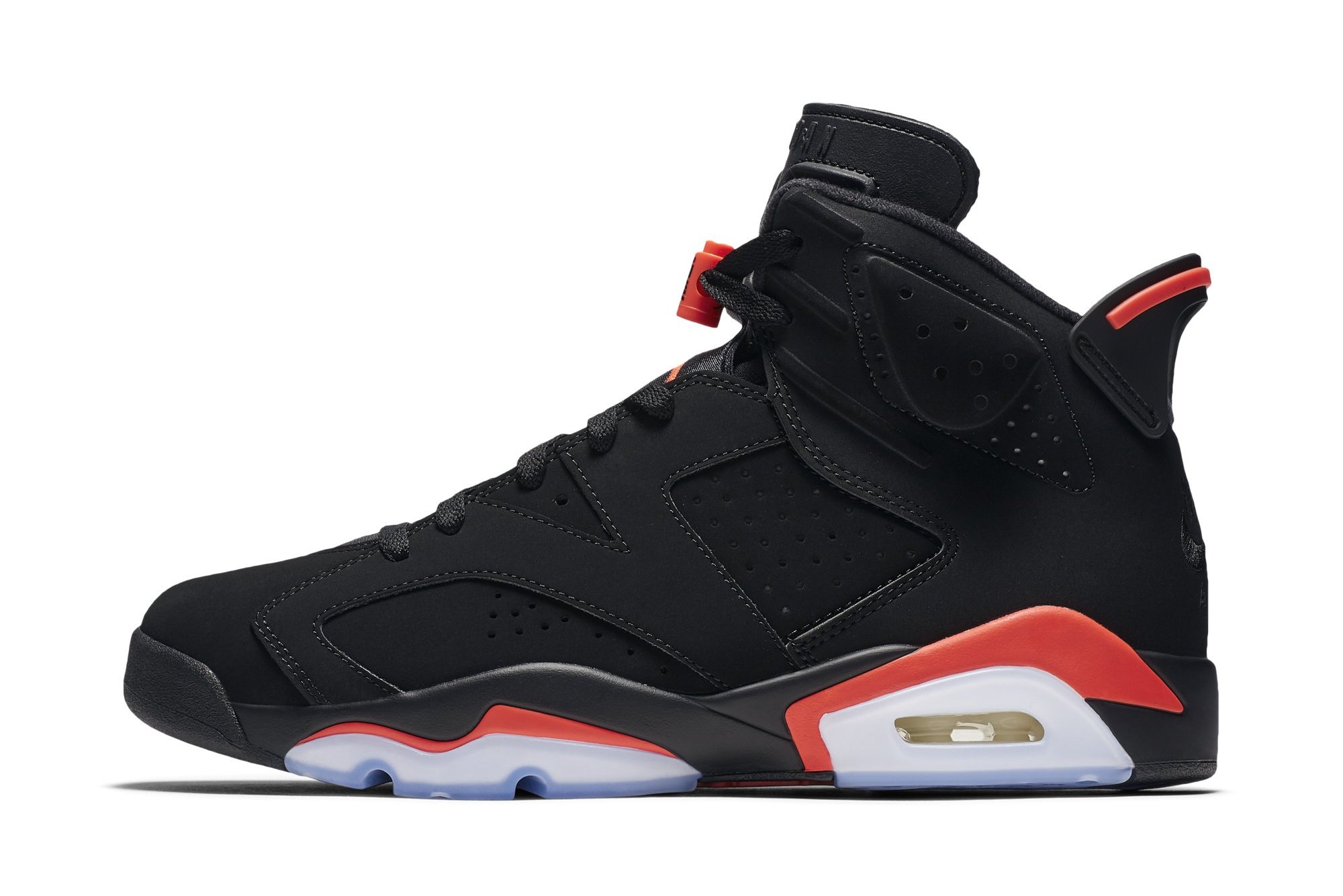
Year First Released: 1991
Any discussion about the most important sneakers worn by Michael Jordan in his storied NBA career has to include the Air Jordan 6, the shoe in which he won his first NBA championship and first Finals MVP award when his Chicago Bulls squad faced the Magic Johnson-led Los Angeles Lakers. Like many of the sneakers from MJ’s heralded Air Jordan signature line, this silhouette was designed by Nike legend Tinker Hatfield. It originally released in 1991 in five colorways: “Maroon,” “Sport Blue,” “Carmine,” as well as the two black and white-based “Infrared,” with the latter pairs being the most notable styles of the group.
The Air Jordan 6 was famously inspired by Michael Jordan’s Porsche 911 sports car, which is specifically referenced with the sneaker’s pull tab on the heel modeled after the car’s rear spoiler. The sneaker’s original release featured “Nike Air” branding on the heel, which ended up being the last Air Jordan shoe. The tongue is equipped with two holes, allowing wearers to slide their foot into the sneaker easier, while the outsole features a combination of solid rubber and translucent pods.
Jordan asked Hatfield to make a sneaker that featured a clean toe box similar to his Italian dress shoes and easier entry into the shoe, according to the designer in MJ’s 2005 book, Driven From Within.
The Air Jordan 6 also had its fair share of popularity off the court. A boot version of the sneaker appeasr on the feet of Michael Keaton in the film Batman Returns in 1992.
The Jordan 6 saw a huge retro push in the 2000s, including the shoe’s debut as a low-top. Unlike the original release, the retro versions featured only Jumpman branding, which replaced the iconic “Nike Air” embroidery on the heel.
Fast forward to present day, and the Air Jordan 6 continues to be key in Jordan Brand’s business. The company recently brought back the “Defining Moments Pack” Jordan 6 that originally released as a two-shoe pack alongside the Air Jordan 11 in 2006, which paid tribute to the sneakers he wore during his most iconic basketball moments. The silhouette has also been at the center of some of its high-profile collaborations in recent years, as the brand joined forces with Houston rapper Travis Scott to deliver their first Air Jordan 6 collab in 2019, followed up by a second iteration in 2021.
After celebrating its 30th anniversary last year, it’s safe to say the Air Jordan 6 isn’t going anywhere. –Victor Deng
17. Nike Air Yeezy 1

Year First Released: 2009
Kanye West dabbled in various footwear projects prior to the Nike Air Yeezy 1, but the 2009 release officially marked the beginning of the Yeezy brand. It was his first publicly released Nike sneaker after an exclusive “College Dropout” Air 180 from 2006 that never hit stores.
Created alongside Mark Smith, who was Nike’s creative director of special projects at the time, and Tiffany Beers, who was then Nike’s special projects innovator, work on the Air Yeezy 1 began in 2007 after Smith received a call from then-CEO Mark Parker.
“It was an interesting design challenge to try and put things together from a design standpoint,” Smith told Sole Collector in 2009. “It was based on a call from Mark Parker, basically. We just kind of went into it saying that we wanted to do something that was unique, and Kanye’s clear vision was that it should feel retro. I just listened, and he thought it should feel like it came from the [1980s].”
Compared to other popular sneakers on the market in the late 2000s, the Air Yeezy 1 stuck out like a sore thumb—in the best way possible. Performance basketball sneakers and their retro counterparts had moved away from the ultra-high-top cuts of the ‘80s and ‘90s, and certain rereleases like the Air Jordan 1 nearly abandoned their high-top form altogether during this period. Low-top runners were beginning to come into vogue, and the trendy high-tops of the time mostly came from designer brands such as Auto Matsumoto—a favorite of West’s that would seemingly inform many of the details on the Air Yeezy 1.
The Air Yeezy 1 was created in various prototype forms before being finalized. Instead of the glow-in-the-dark sole on the retail pair, one early rendition included a battery-powered light-up sole reminiscent of what would appear a few years later on Nike’s Back to the Future MAG sneakers. These pairs included what was nicknamed a “Death Star” midsole with a large circular indentation and a more streamlined design. One rare sample even featured the tooling of the Air Jordan 6.
Ultimately, Beers, Smith, and West decided to lean more retro than futuristic, co-opting the midsole from the Air Jordan 3. Since the light-up outsole they had considered using would be too expensive and wouldn’t last long, the developers chose to emphasize its glow-in-the-dark capabilities.
“We did a number of formulations and probably did 10 or more mixes, and the one that came out the best was not actually the highest mix, but it was one of the mid mixes,” Beers told Sole Collector. “It turned out that it held the charge of the light really well for a long time, and it didn’t degrade much, because I think the first few we tried degraded the quality of the rubber.”
Each of the Air Yeezy 1’s three retail colorways—“Zen Grey,” “Blink” (short for black/pink), and “Net”— followed a similar theme in that they combined neutral base colors with brighter accent colors. Yet, all these years later, the colorway that is arguably the most significant is one that didn’t actually release. Known as the “Grammy” sample, a mostly all-black Air Yeezy 1 worn by West at 2008’s music awards set a record in 2021 after selling at Sotheby’s for $1.8 million. To date, it’s the most expensive sneaker ever sold. –Riley Jones
16. Nike Air Max 97
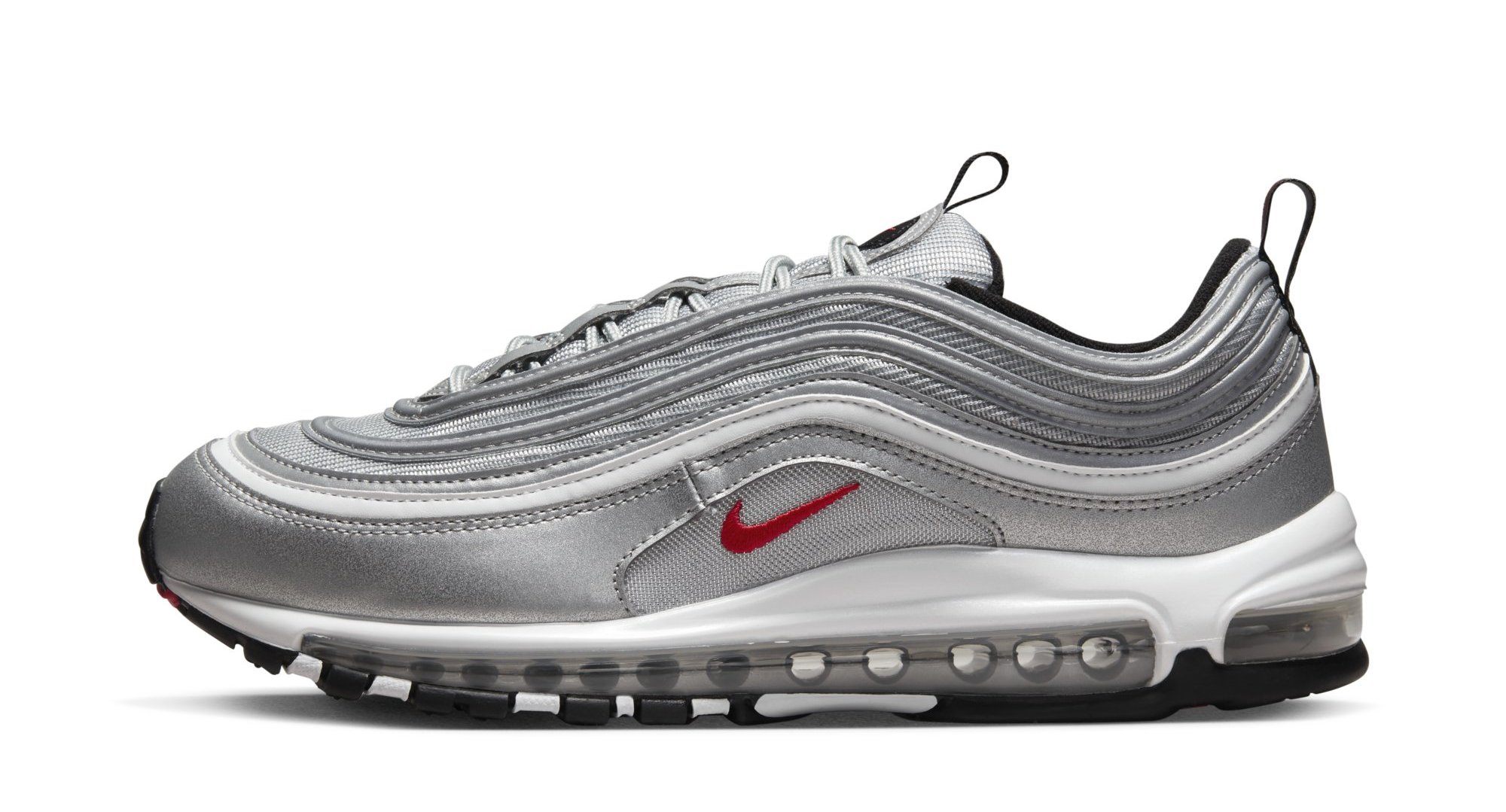
Year First Released: 1997
If you’ve been into sneakers for a good decade at least (not that that’s a prerequisite for loving them or caring about their history), you should be able to remember when the Air Max 97 was a significantly more niche shoe. It’s always been beloved by a sector of Nike obsessives, but for most of the 2000s, there just weren’t that many out there.
For those who are still catching up: The Air Max 97 was designed by Christian Tresser, who wanted the upper’s wavy lines to look like the ripples in a pond. The sneaker’s flashy metallic debut was fashioned after the flashy sheen of mountain bikes, and not the Japanese bullet trains as some lore suggests. It was an immediately futuristic sneaker, an incredibly appropriate snapshot of what shoes could look like at the turn of the millennium. It was potent especially in Italy, where the 97 hit runway stages in fashion shows and populated the country’s clubs.
Where does the Air Max 97 sit now? It’s everywhere without quite being rinsed. The original silver colorway and the second wave gold version are still powerful, kept reasonably protected by Nike. OK, there have been a couple misses in the mix but those can be forgiven. The special editions are infrequent enough so as to still feel special, with Skepta’s being a high point and those subtle tweaks with the Italian flag are a smart homage that didn’t overdo it. Despite being everywhere these days, the Air Max 97 manages to not ever feel like too much. –Brendan Dunne
15. Nike Air Trainer 1
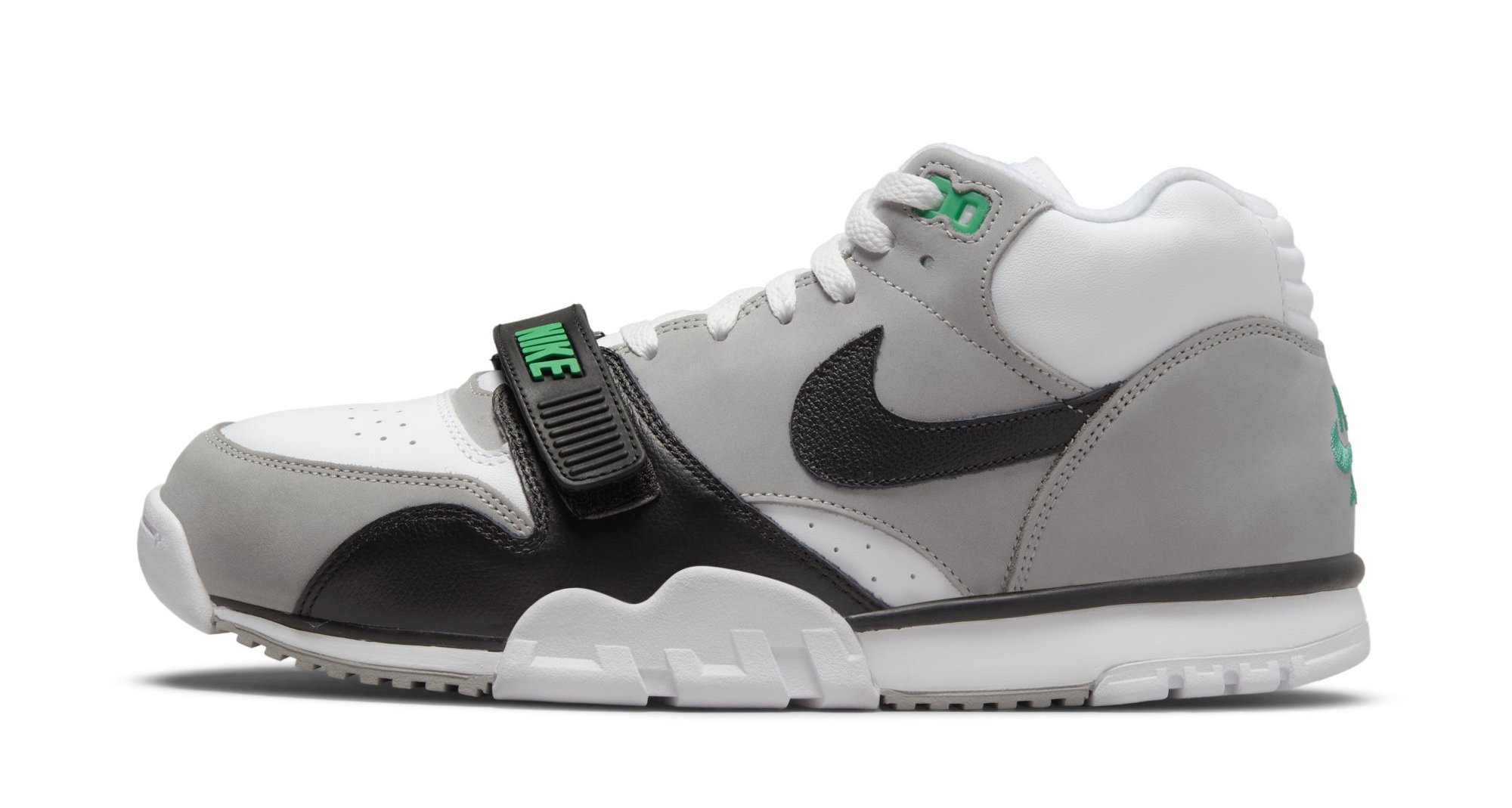
Year First Released: 1987
Working with Michael Jordan and designing for the Air Jordan line is what Tinker Hatfield is best known for, but the footwear industry veteran has countless other notches on his belt, among them the Nike Air Trainer 1. The story of how the Air Trainer 1 came to be begins in 1987 with Hatfield, his gym bag, and him noticing athletes at the gym switching between shoes for different activities; running, playing basketball, etc.
“I would go to the club, and I’d actually have three pairs of shoes in my bag,” Hatfield said in a 2009 interview with Sole Collector. “I was not gonna go for a five-mile run in a pair of basketball shoes, but people were doing just that. My observation was that most people would show up there with one pair of shoes, whether they were running shoes or basketball shoes or tennis shoes, and try to do multiple things with one shoe. Well, it just doesn’t work that way, and a basketball shoe is a terrible thing to run more than wind sprints in. It’s one of the worst things you could jog around in. So people are doing that, and I’m going, ‘Well geez, now I see a path to a project.’”
With that in mind, Hatfield began sketching the design, and the first person he showed it to was fellow footwear stalwart Mark Parker. The duo, who went on to become two of the most powerful men in Nike’s history began working together on an entirely brand-new sneaker category. At first, Nike’s marketing department was strongly opposed to the idea, fearing that if they created a shoe that was good enough to run in and to play basketball in, it would hurt the sales of the two individual categories.
“The shoe was going to be a compromise,” Hatfield said. “We can always design a better basketball shoe or a better running shoe, but this is going to sit in the middle where it’s good enough for most people.”
The Air Trainer 1’s most revered colorway, the “Chlorophyll,” harkens back to Hatfield’s days at the Portland YMCA, borrowing its color scheme from the gym’s weight training equipment that was black and white with bold green writing. On top of its practicality, the Air Trainer 1 was backed by a number of Nike’s most popular athletes, including its involvement in one of the brand’s most recognizable ad campaigns, “Bo Knows,” starring multi-sport athlete Bo Jackson. Surprisingly enough, it was on the tennis court where the Trainer 1 really took off, on the feet of legends the likes of John McEnroe and Andre Agassi.
Similar to many other Nike basketball sneakers (think the Air Jordan 1 and the Dunk), the Air Trainer 1 was revered and adopted by the skateboarding community. Eventually, the shoe officially made its way under the Swoosh’s SB umbrella where a number of all-time colorways were released, including the “Paul Brown,” Huf’s “Gold Digger” collaboration, and the “Bamboo.” In 2020, the “Chlorophyll” remake was released with SB on its tongue. Thirty-five years since the Air Trainer 1’s industry-shifting debut, many consider it to be one of both Hatfield and Nike’s greatest creations of all time. –Ben Felderstein
14. Nike Air Max 90

Year First Released: 1990
I wrote a whole chapter on this shoe, Nike’s most popular Air Max model of all time, for our Sneaker of the Year book, and my biggest takeaway was: There’s not a lot of information on the sneaker’s origin. The Air Max 90 is an updated version of the Air Max 1, the revolutionary shoe from 1987 that (sadly) taught a whole generation of runners to heel strike. The bubble is roughly the same size as the Air Max 1 and its original color scheme is white and red, just like the Air Max 1, but the red on the 90 is Infrared, which might be Nike’s best color ever. The “Infrared” Air Max 90 might be Nike’s best colorway on an individual shoe ever.
The 90 also has a beefier tongue than the Air Max 1 and was used by the brand as a more mainstream model that you’d see in every mall store and would be used to inspire the Air Max Wright and LTD, two of the brand’s best-selling Air Max models that get no love. The 90 has had stellar collaborations: The “Bacon” from DQM, Dizzee Rascal, Kaws, Huf’s “Hufquakes,” Virgil Abloh’s Off-White versions, and size?’s “Clerks” pack, to keep it light. The Air Max 90 is a shoe you can wear every day, and many people do. The original women’s colorway is great, too, and so is the “Laser Blue.” Let’s not forget the “Homegrown” pair, either. Or how about the “Denims” or “Warhawks”? Get the point? The shoe keeps going and going. –Matt Welty
13. Nike Air Foamposite One
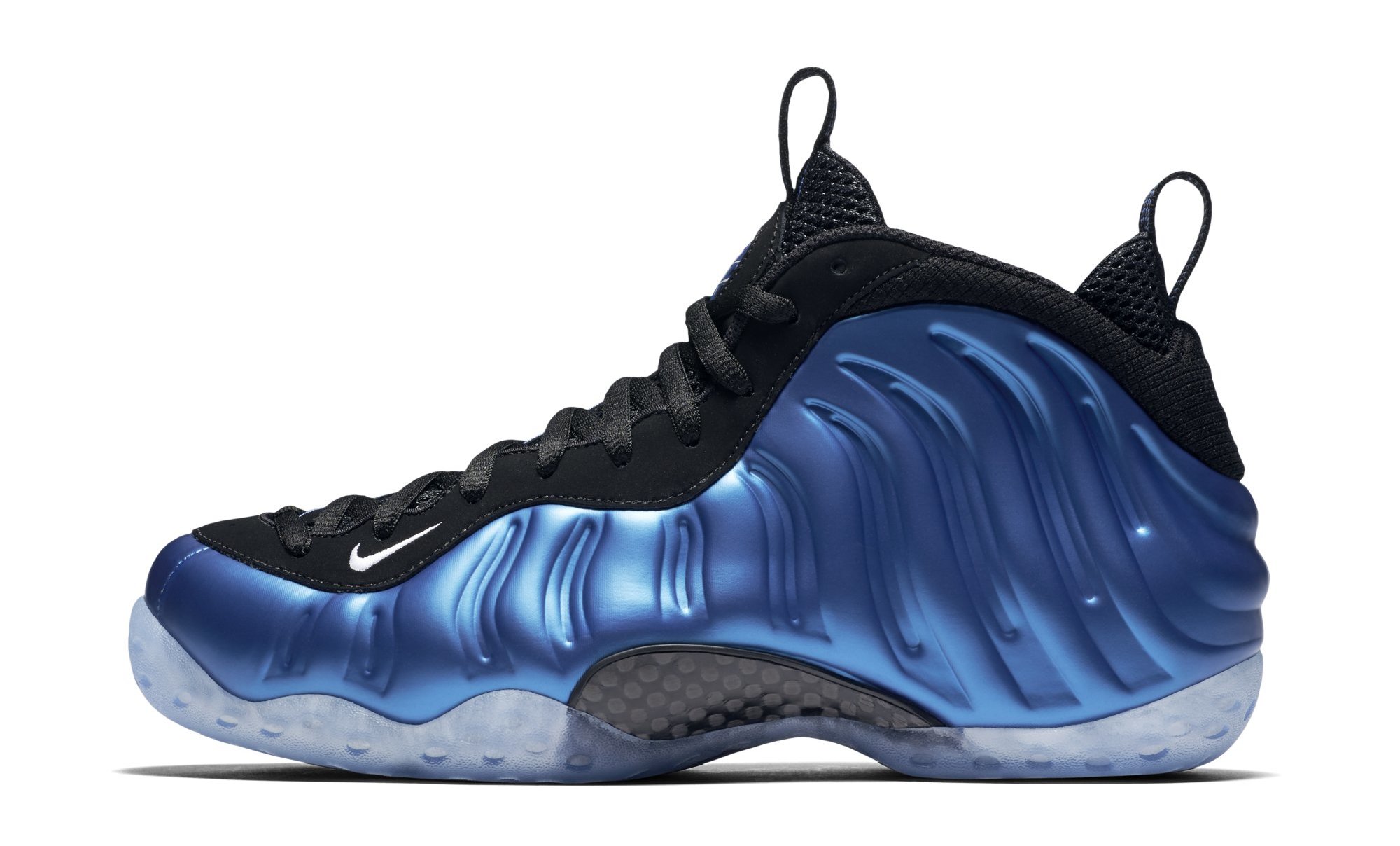
Year First Released: 1997
Twenty-five years on, there’s still nothing quite like the Air Foamposite One.
Although it’s most commonly associated with Penny Hardaway, it wasn’t originally created for him. Designer Eric Avar created the Foamposite with the intention of making it a signature shoe for former Chicago Bulls star Scottie Pippen. As we know, that didn’t materialize, and as the story goes, the shoes were spotted in a bag by Penny during a briefing.
“The Foamposite sample was the last thing left in the bag and I hadn’t even taken it out because all the voices had gotten in my head and I was almost embarrassed,” Avar said in a Nike SNKRS feature. “So we’re just finishing up and Penny looks over and says, ‘What’s that in the bag?’ I almost hesitated to take it out, but I did and he grabbed it, and just goes, ‘What is this?!’ I said it’s this concept we’re working on. He just stopped me right there, and said ‘That’s it. I want that to be my next shoe.’”
And that was that. The Foamposite material, which begins as a liquid that is poured into molds and heated between 130 and 175 degrees Fahrenheit to achieve its shape, was done up in a “Dark Neon Royal” that perfectly complemented the Orlando Magic’s late ‘90s jerseys. Nike branding was minimal, with only a small Swoosh appearing near the toe while the tongue and heel space was reserved for Penny’s “1 Cent” logos. Cushioning came by way of Zoom Air—Nike’s most cutting-edge underfoot tech at the time—and stability was bolstered by a large carbon fiber shank.
The Air Foamposite One hit stores in 1997 for a retail tag of $180, a price point that was rarely seen in that era. Adding to their allure was Arizona Wildcats’ Mike Bibby breaking them out on-court before Penny himself during an NCAA tournament game. Then, when Penny wore them, he faced fines from the NBA for violating now-defunct uniform rules because the shoes didn’t have enough black on them. To get around this, he colored in the upper’s inner ridges with a Sharpie, a story that was later referenced by Nike on a special 2015 release.
When it comes to special releases, the Air Foamposite One has no shortage of them. Many people point to 2012 All-Star Weekend’s “Galaxy” pair and the ensuing madness around it as a pivotal shift in sneaker culture. When streetwear brand Supreme collaborated on the shoe in 2014, things got so rowdy they had to shut down the in-store release altogether and change their drop procedure going forward. Over the years, the Foamposite has also been used to pay tribute to Tianjin, China, and was given away in a contest for the animated film ParaNorman.
A staple of DC and Baltimore in its early days, the Foamposite started to gain wider recognition with the aforementioned “Galaxy” release. The popularity of the printed pair led Nike to experiment with various graphic treatments on the molded upper in the years that followed, including “Fighter Jet,” “Area 72” Pros, and the always-polarizing “Weatherman,” complete with a doppler radar-like pattern. –Riley Jones
12. Nike Cortez

Year First Released: 1972
Nike’s first sneaker might be its most controversial shoe ever. The Cortez has lived on since 1972 to help define Nike. It’s a shoe that’s transcended from running to become a cultural icon. A model that’s been worn by George Costanza, Farrah Fawcett, Forrest Gump, and become a mainstay in California’s Mexican-American community. But its origins are what would set the tone for Nike thereforward. Before Nike was Nike, co-founder Phil Knight ran Blue Ribbon Sports, which helped import and sell Onitsuka Tiger sneakers from Japan to the United States. Knight knocked off Tiger’s Corsair sneaker and originally caled his own the Nike Aztec. The name didn’t stick, so he named it the Cortez, after Hernan Cortes, who fought the Aztecs.
In the ‘80s and ‘90s, the sneaker became associated with Los Angeles’ gang culture and became dangerous to wear for those who weren’t affiliated. “The shoe was for the ’hood. It wasn’t mainstream fashion like it is now. Accessibility and price point made that shoe what it is,” says Spanto, the co-owner of L.A. streetwear brand BornxRaised, who was raised in Venice, California. “They sold it at every swap meet, every ‘hood shoe store for $20-$30. It fit the aesthetic of how we dressed in the ‘80s and ‘90s: classic American workwear, Dickies, and Ben Davis.”
“Everything has changed since then, but back then you didn’t wear that shoe unless you were about your shit,” Spanto says. “If you weren’t about your shit and you wore that shoe to school or the movies, best believe you were going to get pressed. Your shoes were probably going to be revoked.”
The shoe has been redesigned in collaborations by Mr. Cartoon, a widely reputed tattoo artist from the area, and Union, one of the city’s longest-running streetwear stores, both which were homages to L.A. But to many, it doesn’t get better than the original white, red, and blue or the black and white nylon pairs. –Matt Welty
11. Nike Zoom Kobe 4
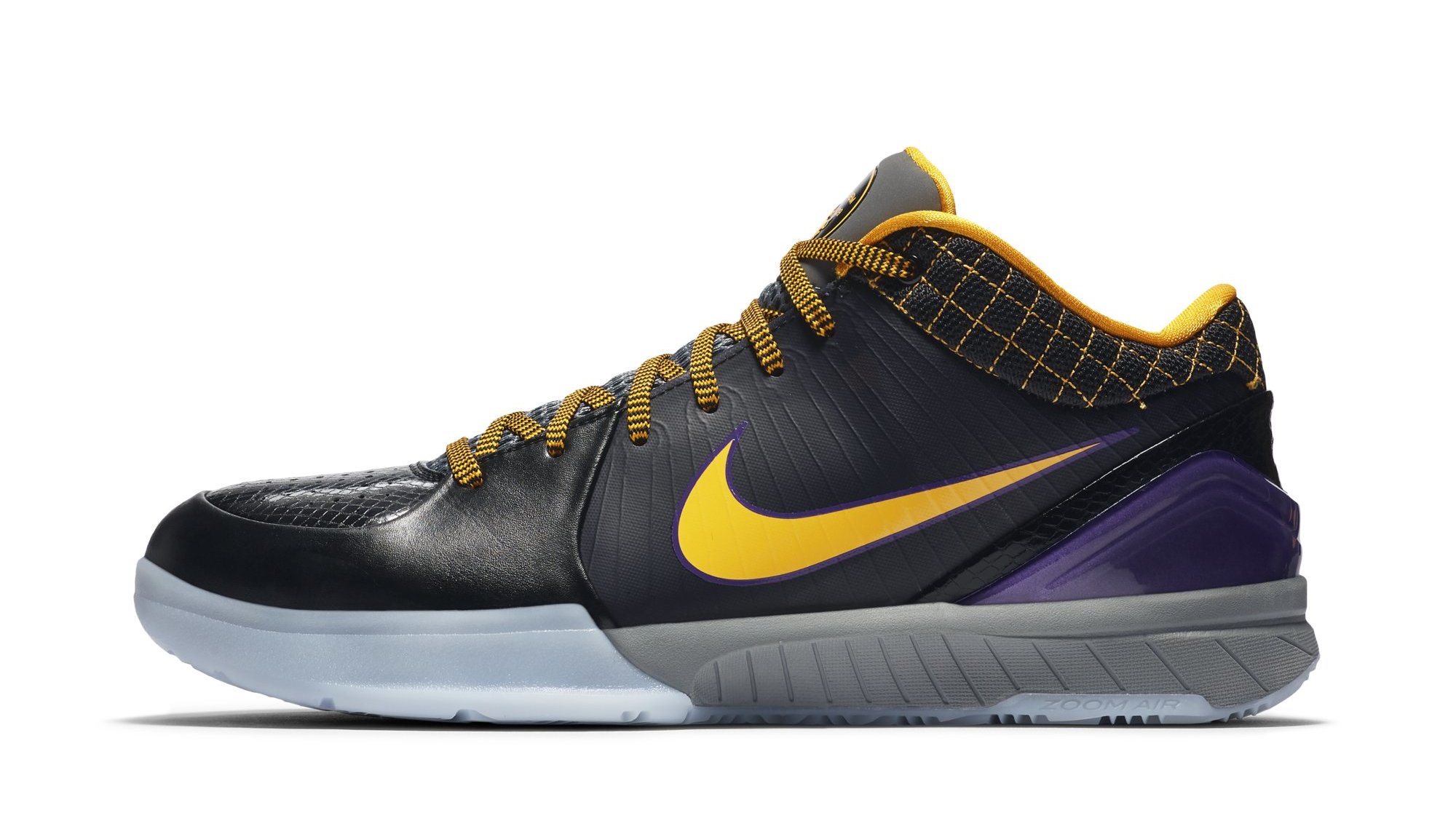
Year First Released: 2009
When you take a look around the basketball sneaker landscape today, you may notice the variety of low-top basketball sneakers available on the market, almost all of which are indebted in some way to the Nike Zoom Kobe 4 in 2009. Prior to the Zoom Kobe 4’s debut, the accepted wisdom in basketball was that hoopers who wore low-top basketball shoes were more prone to getting injured, but Kobe Bryant set out to debunk that fallacy. Bryant looked to soccer for answers, which is where he noticed that the athletes in that sport weren’t wearing high-top shoes but instead wore some of the lowest-cut silhouettes on the market, including the Swoosh’s Mercurial football boot.
The person tasked with designing Bryant’s fourth signature shoe was former senior designer at Nike’s Innovation Kitchen Eric Avar, who’s also responsible for creating some of the most iconic Nike Basketball silhouettes from the 1990s like the Zoom Flight 95, the Air Penny 2 and the Foamposite One, just to name a few.
The Zoom Kobe 4 was the lowest-cut sneaker in the Nike Kobe line thus far. The lure behind creating a lower-cut basketball shoe was that it would allow wearers to be closer to the ground for better on-court control and stability while also freeing up the ankle and providing a better range of motion. The lower profile would also reduce the shoe’s overall weight as compared to high-top sneakers in the same category.
Even though the Nike Zoom Kobe 4 came at a lower profile compared to the other hoop models from that era, it wasn’t lacking in innovation. The upper featured the Swoosh’s innovative Flywire technology on the midfoot panels, which provided lockdown and protection, while an external heel counter and molded ankle collar provided foot security. Tucked within the forefoot of the midsole is a Zoom Air unit that provides responsiveness on the court, a carbon fiber shank plate at the midfoot, and a full-length herringbone traction pattern on the outsole for grip.
Bryant and his Lakers squad would go on to win a championship against the Orlando Magic during the 2008-’09 NBA season, further cementing the legacy of the Nike Zoom Kobe 4. –Victor Deng
10. Air Jordan 5
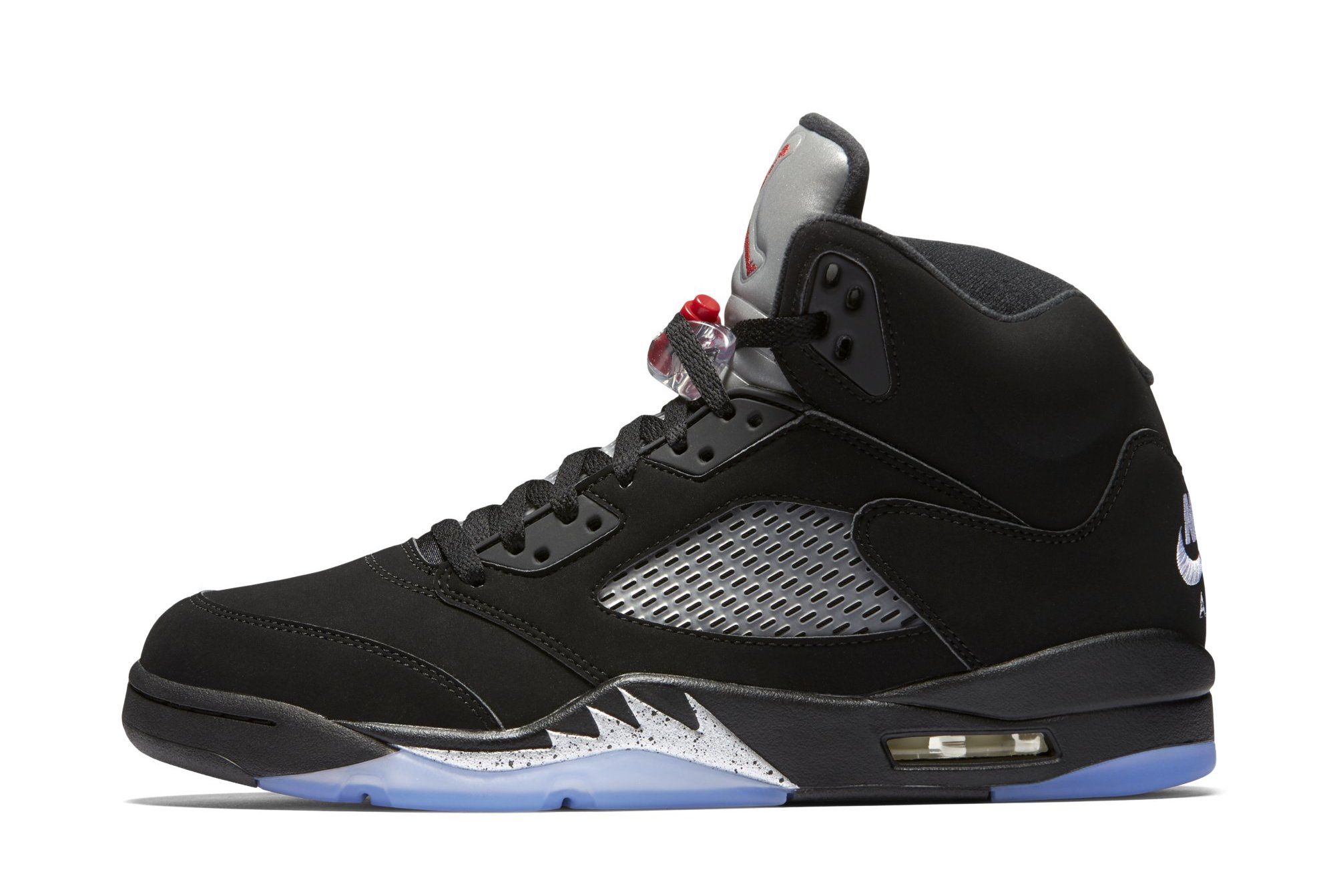
Year First Released: 1990
In the latter half of the 1980s, Michael Jordan and his signature line of Air Jordan sneakers began dominating the footwear landscape. After the less-than-stellar release of the Air Jordan 2, the 3 and 4 did exactly what was needed and righted the ship of what is now the most iconic line of sneakers in the world. Carrying that momentum forward, designer Tinker Hatfield kicked off the ‘90s by creating the Air Jordan 5, with design elements harkening back to the past and looking towards the future.
Hatfield looked to the American-engineered World War II P-51 Mustang fighter jet used for air raids in Germany for the model’s inspiration. A special version of the plane, “The Shark” featured a set of sharp teeth on its nose, which Hatfield used to inspire the signature element of the Jordan 5, its set of shark teeth on its midsole. Easily one of the most photographed athletes in history, Jordan’s fifth signature sneaker came equipped with a reflective 3M tongue that lit up with the flash of the hundreds of cameras in the arena on a given night. Finally, the Air Jordan 5 introduced a clear outsole, now a mainstay in the sneaker world, as well as a plastic lace lock, an element carried over to the Air Jordan 6.
In 1990, the Air Jordan 5 made its debut at a retail price of $125 with only four original colorways dropping that year: white and black “Metallic” iterations with 3M tongues, a “Fire Red” version, and the now-beloved “Grape,” a departure from the familiar Chicago Bulls variations. It took 10 years for the 5 to hit shelves again, returning in both OG Metallic colorways, a White and Silver Metallic version, and a nod to Jordan’s Laney High School. 2006-2008 were banner years for the Jordan 5, with fan-favorite and non-original colorways the likes of the “Green Bean,” “Olive,” “Burgundy,” “Laser” , and the “Raging Bull” pack all releasing. A number of special edition 5s have dropped over the years as well, including a “Doernbecher” pair, an entrant in the “Bin 23” collection, both “Tokyo” and “Shanghai” iterations, and a “Quai54” colorway. In recent years, the Jumpman’s top collaborators have worked on the 5, including Marcus Jordan’s Trophy Room Store and this year’s plethora of DJ Khaled colorways.
In September of 1990, The Fresh Prince of Bel-Air premiered starring Will Smith. Now an iconic part of pop culture, Smith’s fashion-conscious character had an Air Jordan 5-heavy rotation throughout the show’s six seasons. A crucial part of the shoe’s history, the Jordan Brand created a “Bel-Air” colorway in 2013 and turned it up a notch in 2018 by dropping a laceless version of the “Grape” Jordan 5 to pay homage to the way Smith wore his sneakers on screen. While the Jordan 5 does not quite carry the legacy that one of MJ’s championship-winning models does, it is the sneaker that he recorded his career high 69 points in. Jordan also won his fourth scoring title in 1990 and led the Bulls to the Eastern Conference finals, where they were eliminated by the Detroit Pistons. –Ben Felderstein
9. Nike Air Yeezy 2
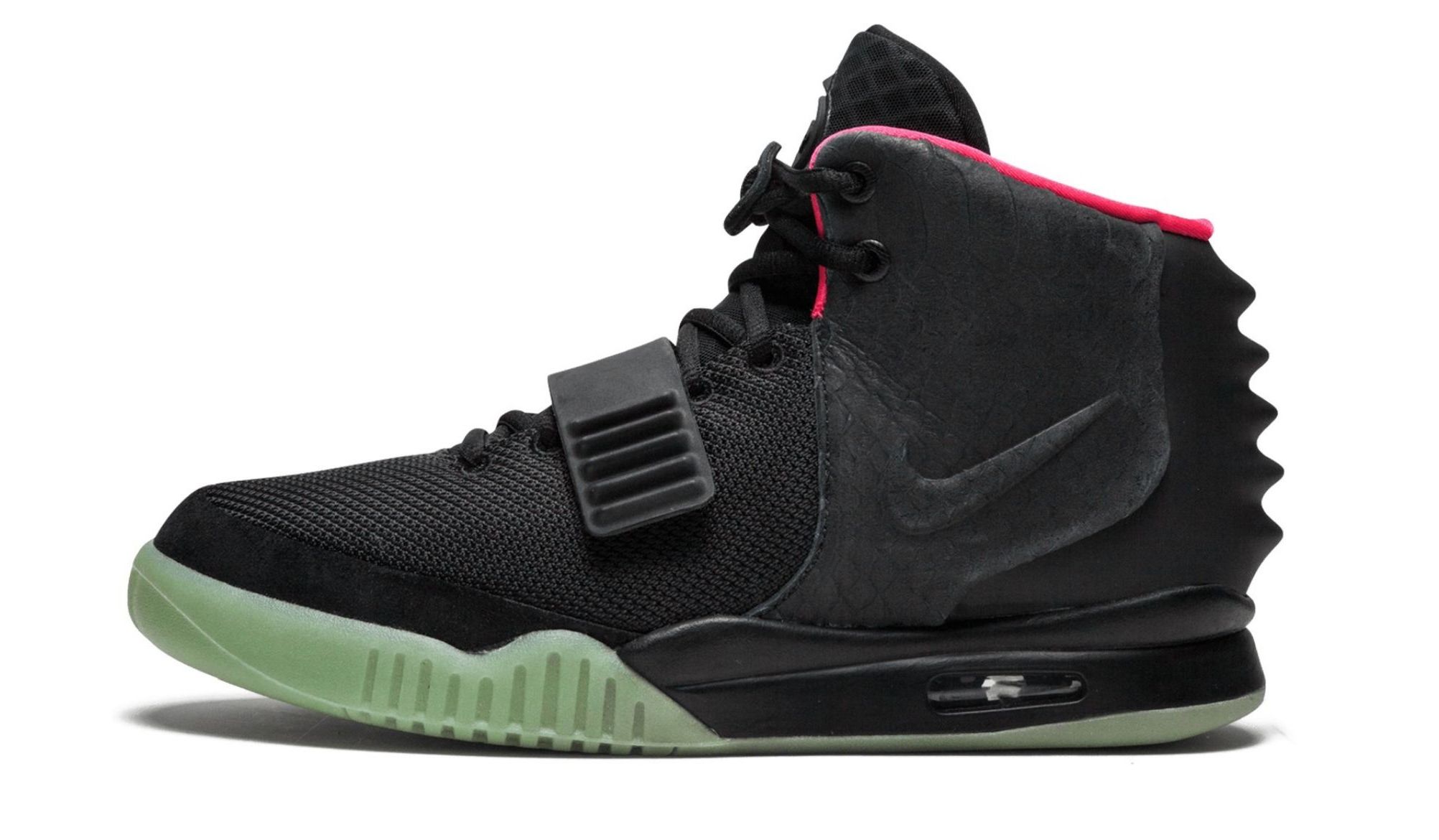
Year First Released: 2012
Before he was persona non grata, Kanye West was one of the most influential people in sneakers. There was a period during the 2010s when just about any pair he laced up, from general releases like the “Varsity Red” Air Jordan 6 to rarer pairs like the “Independence Day” Air Max 90s, would see an uptick in retail sales and, more often than not, aftermarket value. The Kanye effect was very real, and it hit hardest on his own sneakers—especially the Air Yeezy 2.
Years prior to the Adidas Yeezy brand becoming a mutli-billion-dollar business with hundreds of SKUs, there weren’t many Ye-designed sneakers for fans to choose from. The limited selection amplified the demand for his Nike output, which began with 2009’s Nike Air Yeezy and was followed up with the Air Yeezy 2 in 2012. While the original Air Yeezy featured aggressive high-top cut and exaggerated padding, the Air Yeezy 2 was more pared down, with materials and color selections that later would wind up informing a number of non-Yeezy releases from Nike and other brands. Not only was it more wearable than its predecessor, but Kanye’s sartorial sway was stronger than ever, making the Yeezy 2 his most coveted silhouette to date.
“The Yeezy 2 was trying to push what Nike could bring to the table and create something super iconic,” designer Nathan VanHook told Complex in 2015. And while the word “iconic” is tossed around way too much in sneakers and fashion, the Yeezy 2 is very much deserving of the title.
It was released in three colorways: “Pure Platinum” and “Solar Red” to kick things off, and “Red October” later down the line. All three of these color combinations would go on to inform dozens of follow-up Nike releases from Roshe Runs to Foamposite Pros. To say that Nike was shameless in its Yeezy-fication of so many shoes isn’t quite fair—the brand owned the designs after all—but the trickle down effect was clear to see. Other brands got in on the action as well, with all-red tonal sneakers becoming commonplace for a few years.
All of the Yeezy 2s were impactful, but the “Red October” is the shoe’s definitive colorway. Arriving nearly two full years after the original Yeezy 2s, the “Red October” released after months of speculation and back-and-forth over whether the shoes would actually even come out. Out of nowhere, they finally dropped via a Nike tweet in February 2014 and sold out within minutes. To this day, they remain the most valuable Yeezy 2 on the resale market, and the all-red Yeezy phenomenon even made its way to the present on the Foam RNNR. –Riley Jones
8. Nike Air Max 95
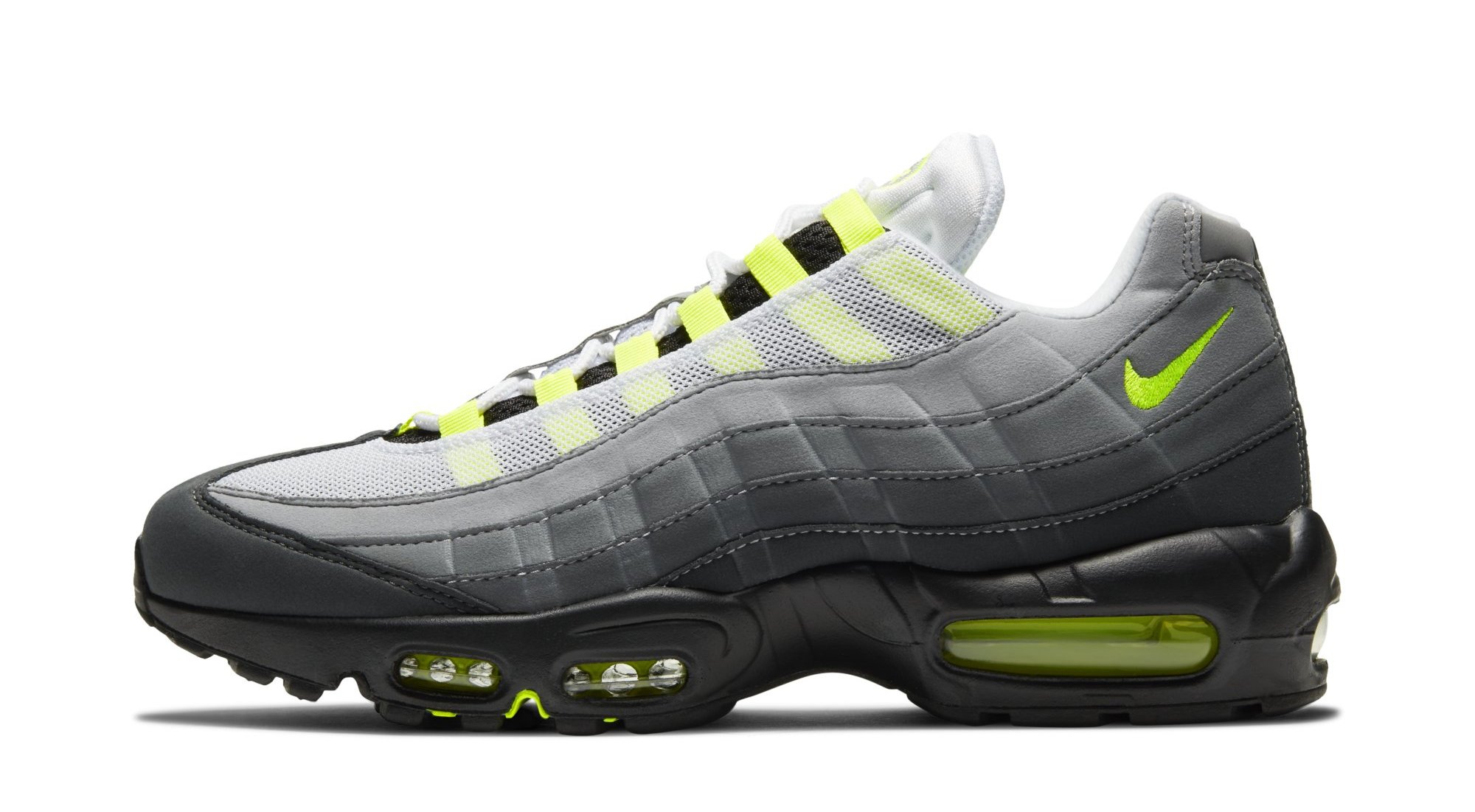
Year First Released: 1995
Sergio Lozano’s Air Max 95 is almost 30 years old, but it still looks fresh today. The designer, who’s also responsible for shoes like the Air Max 98 and Air Tuned Max, was inspired by human anatomy in creating the 95, looking to mimic the way the body’s bones, tissue, and joints connect and support one another. In doing so, he created a model that withstood the test of time and gained devoted followings across continents.
It may be hard to imagine today with shoes like the VaporMax and Air Max Scorpion, but before the Air Max 95 debuted, Nike’s signature visible Air technology was used only in the heel area of shoes. From its introduction on 1987’s Air Max 1 all the way up to 1995’s Air Max 2 Light, visible Air came in various shapes and volumes, but it was always at the rear of the shoe. That changed with the Air Max 95, Nike’s first sneaker to use visible Air cushioning in the forefoot. And although it was introduced on the Air Max 95, the amplified cushioning would become commonplace across categories including basketball before the introduction of full-length visible Air in 1997.
Another design choice that helped the Air Max 95 stand out was its minimal branding. Rather than plaster the shoe’s lateral and medial sides with large logos, Lozano used a small Swoosh seen only on the outer heel.
“We figured Nike was pretty recognizable as a brand and that the design could stand on its own. Why did we need it?,” Lozano said in a 2015 Nike News feature. “We already had visible air and we were debuting forefoot visible air on top of that. We applied the Swoosh to act as punctuation. Needless to say that was another big point of contention.”
You also can’t talk about the Air Max 95 without acknowledging its most famous colorway. The sneaker’s definitive makeup combines black and shades of gradient grey with an eye-catching neon yellow. Lozano admits that the neon shade wasn’t a new color for Nike at the time and already a staple of its running and racing output. Yet, over time, the Air Max 95 has all but made it its own. Its “Neon” colorway has been referenced time and time again on sneakers including the Air Jordan 4, Air Force 1, LeBron 15, and more. As great as the “Neon” is, it would be a disservice to not mention some of the other notable colors including “Chili Red,” “Comet Red,” “Grape,” and “Tide Pool Blue.”
On the collaboration front, notable Air Max 95s include projects with Atmos, Comme des Garçons, Parra, Stash, and Supreme.
Although regional sneaker favorites have become less of a thing with the advent of the internet, Lozano’s design is one that still holds particular significance in certain areas. In London, the model’s been long known as the “110,” a nod to its original 1995 price point. And in Japan, the sneakers were once so coveted that wearers were frequently assaulted by Air Max 95-thirsty thieves. One Japanese TV show even referenced the phenomenon in a sketch.
These days, you’re just as likely to see Kim Kardashian wearing them as you are a group of football hooligans or Japanese sneaker collectors, yet the Air Max 95 remains relevant despite becoming something of an every person’s shoe. –Riley Jones
7. Air Jordan 4
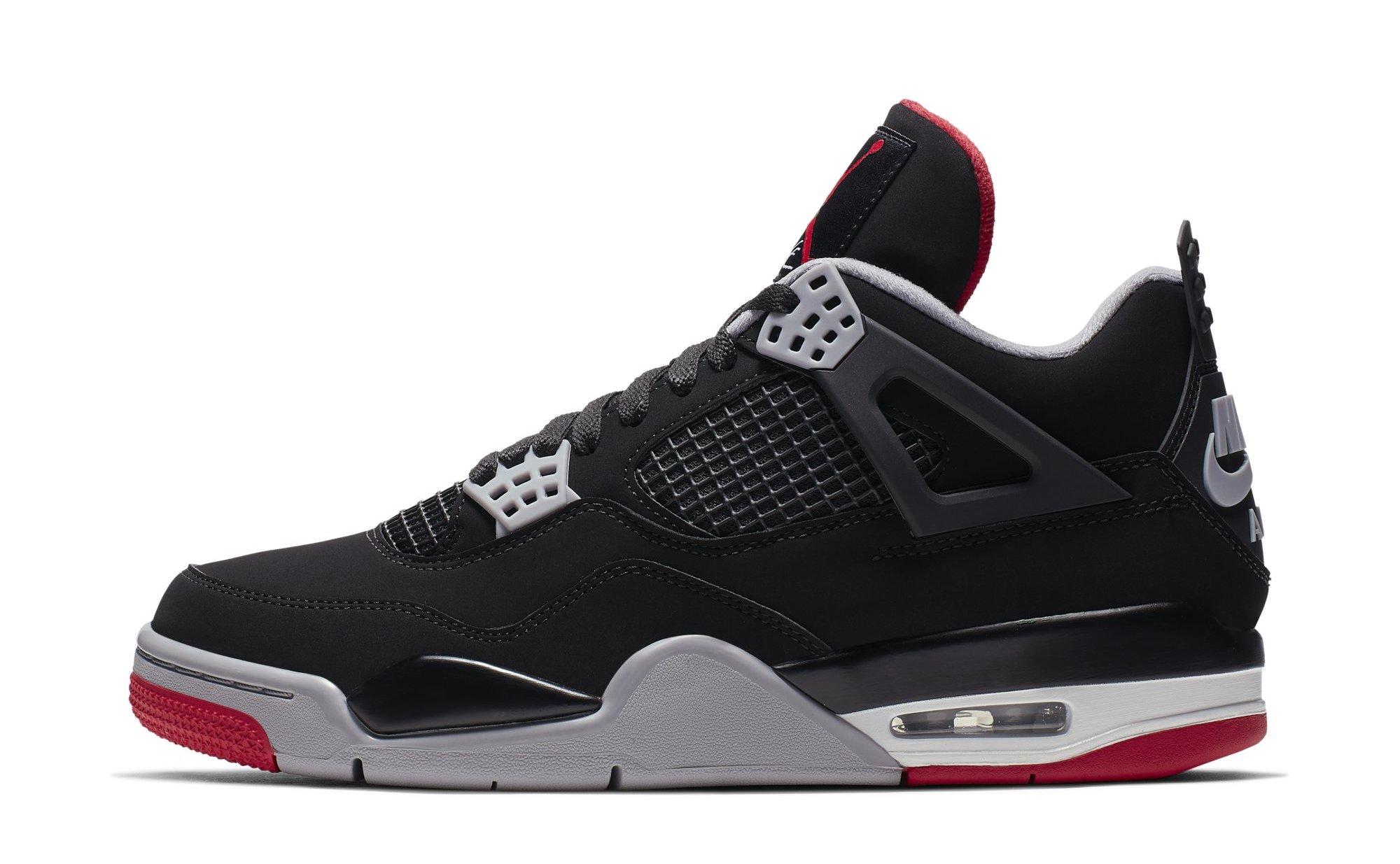
Year First Released: 1989
The Air Jordan 4 shares many physical characteristics with its predecessor, without the prestige of being the shoe that prevented Michael Jordan from leaving Nike. In that context, it’s understandable that it would fall behind the Air Jordan 3 in terms of the greatest Nikes of all time, but it has so much of its own history and so many of its own moments that it’s not that far back.
Beginning with the design, Tinker Hatfield followed up his work on the Air Jordan 3 with a focus more on utility and less on luxury. He still incorporated soft leathers, but added more functional pieces like plastic support wings and the shoe’s signature mesh netting on the quarter panels—an element he was challenged on from within the brand.
“People said, ‘You can’t sell mesh at that price point,’” Hatfield told Sole Collector in a 2008 interview—the Air Jordan 4 retailed for $110 in 1989. “I said ‘Well, we’ll just do a different kind of mesh.’” He explained that the team was able to create a new urethane-based mesh with different qualities and characteristics than past examples, which had performance benefits in its lighter weight and breathability.
The support wings were developed to give a more customized fit with multiple options for how they could be laced. “It was more about technology and this ability to modify it yourself,” Hatfield said of the 4’s concept. “Whereas the 3 had technology in it, it was more about this soft, luxury item that just happened to be a basketball shoe for the world’s best player. This one was an about-face from the 3.”
On-court, the shoe’s most iconic moment came at the expense of the Cleveland Cavaliers, and Cavs guard Craig Ehlo in particular, as Jordan hit “The Shot” in the deciding Game 5 of the first round of the 1989 NBA playoffs. The Bulls would later lose to the eventual NBA Champion Detroit Pistons in the Eastern Conference Finals, but the play became one of the defining moments and most-played highlights in MJ’s entire career. It was even immortalized in a 2012 Air Jordan 4 colorway that took the black and red version Jordan wore for the play and flipped it with the Cavs’ then-colors of royal blue and orange.
The Air Jordan 4’s legacy isn’t only defined by what happened on-court, though. Spike Lee’s 1989 film Do the Right Thing provided the platform for the model’s biggest pop culture moment when character Buggin’ Out had his white and cement 4s scuffed by a passing bicycle. The scene was commemorated with a special colorway of its own in 2017, this one featuring faux scuffs to honor the incident.
The model also featured in one of the most famous pieces of media ever produced for the Air Jordan line in the form of the “Playground” poster. The piece features a photo of Jordan in front of a graffiti-laden backdrop, once again wearing the black and red colorway of the 4, elevating over a group of kids for a dunk. Its representation of a dream that could be achieved made it a staple of bedroom decor in the late ‘80s and early ‘90s.
The aspiration it created back then, combined with a steady stream of updates—both new colorways and collaborations, and the return of originals, have made it one of the most enduring models of the entire Air Jordan line.
“I hear from people all of the time that this is their favorite one,” Hatfield said. –Zac Dubasik
6. Air Jordan 11
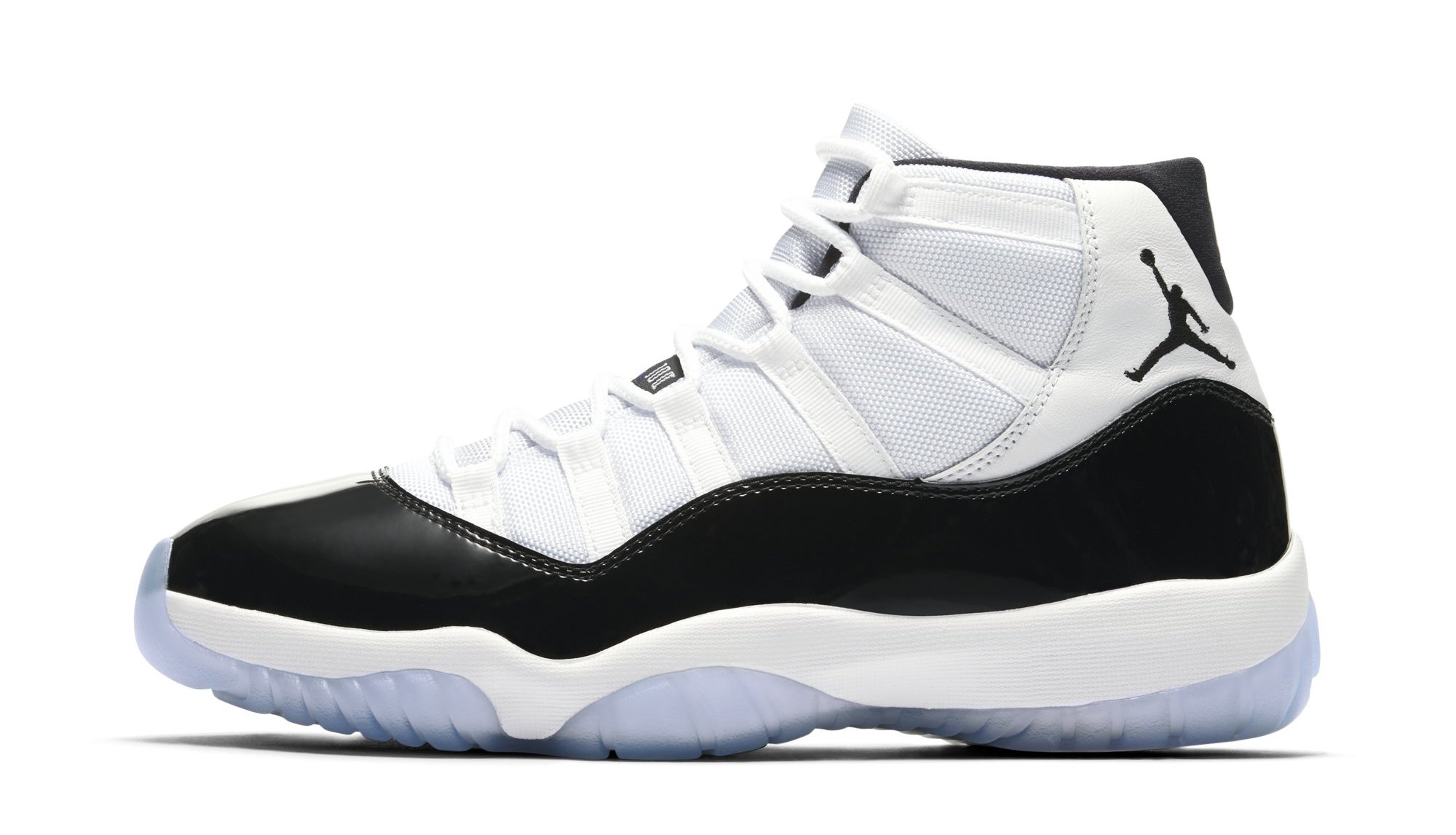
Year First Released: 1995
If you step into a room wearing a pair of Air Jordan 11s, odds are all eyes will be on your feet. Decades after their initial release, the sneaker still carries an air of prestige that commands attention. Sneaker designer Tinker Hatfield’s magic formula of patent leather, ballistic mesh, and clear soles turned what could have been an over-the-top mess into a masterpiece. It’s a shoe that has transcended time, crossed over into multiple sports, and is one of the rare pieces of footwear that has broken ground as a true fixture in pop culture.
Developed by Tinker when Michael Jordan still had one foot on the baseball diamond—an emphasis on performance, new tech application, and a luxurious flair informed many of the design decisions. Fans got an early peak of the 11 when MJ wore them during the 1995 playoffs and Ahmad Rashad famously flashed them in front of the camera on the sidelines.
The original lineup of Jordan 11 was concise and with a purpose. Three mid-top colorways were available to the public—white/black-dark concord, white/columbia blue-black and black/true red-white. It was the perfect three-hit combo that covered the regular season, All-Star Game, and playoffs with each pair racking up iconic on-foot moments with MJ front and center.
The Jordan 11’s credentials extended well beyond their on-court accolades during the 1995-96 season. They’re the shoe Will Smith said goodbye to Bel-Air in during the finale of The Fresh Prince of Bel-Air, and the 11 could regularly be seen making guest appearances on sitcoms and concert stages during this era. A fourth unofficial OG colorway, now nicknamed the “Space Jam,” had a starring role in MJ’s first blockbuster film and would eventually see a few ultra hyped releases to the public years later and pop up in lyrics from the likes of Lil Wayne.
The Jordan 11 also helped usher in Jordan Brand’s retro era in the early 2000s, quickly becoming a status symbol in the sneaker world. There was no bigger flex on sneaker forums than posting a picture of your Jordan 11s lined up shot on your two-megapixel camera. A new crop of talent could be seen rocking the 11 on-court, with Darius Miles and Quentin Richardson injecting new energy into the model. Players like Warren Sapp, Deion Sanders, and Randy Moss extended the 11’s coverage onto the football field, adding to the growing list of PE exclusives that fans would drool over. The “Cool Grey” 11s were one of the first sneakers to spark a frenzy during their release in the spring of 2001, and the 11 quickly became a sneaker that you circled your calendar in anticipation of each retro release. Some people even took the sneaker’s formal wear inspiration literally and there are many awkward pictures of Jordan 11s paired with tuxedos and suits at proms and weddings to prove it.
As the years have gone on, the Air Jordan 11 has found itself cemented as a December Holiday release tradition for Jordan Brand and a legacy model that can still be seen on courts across the globe from the pros on down. The Air Jordan 11 is a sneaker designed by a man at the top of his game in Tinker Hatfield for a basketball player at the top of his game in Michael Jordan and will continue to turn heads and break necks for years to come. –Kevin Luyster
5. Nike Dunk
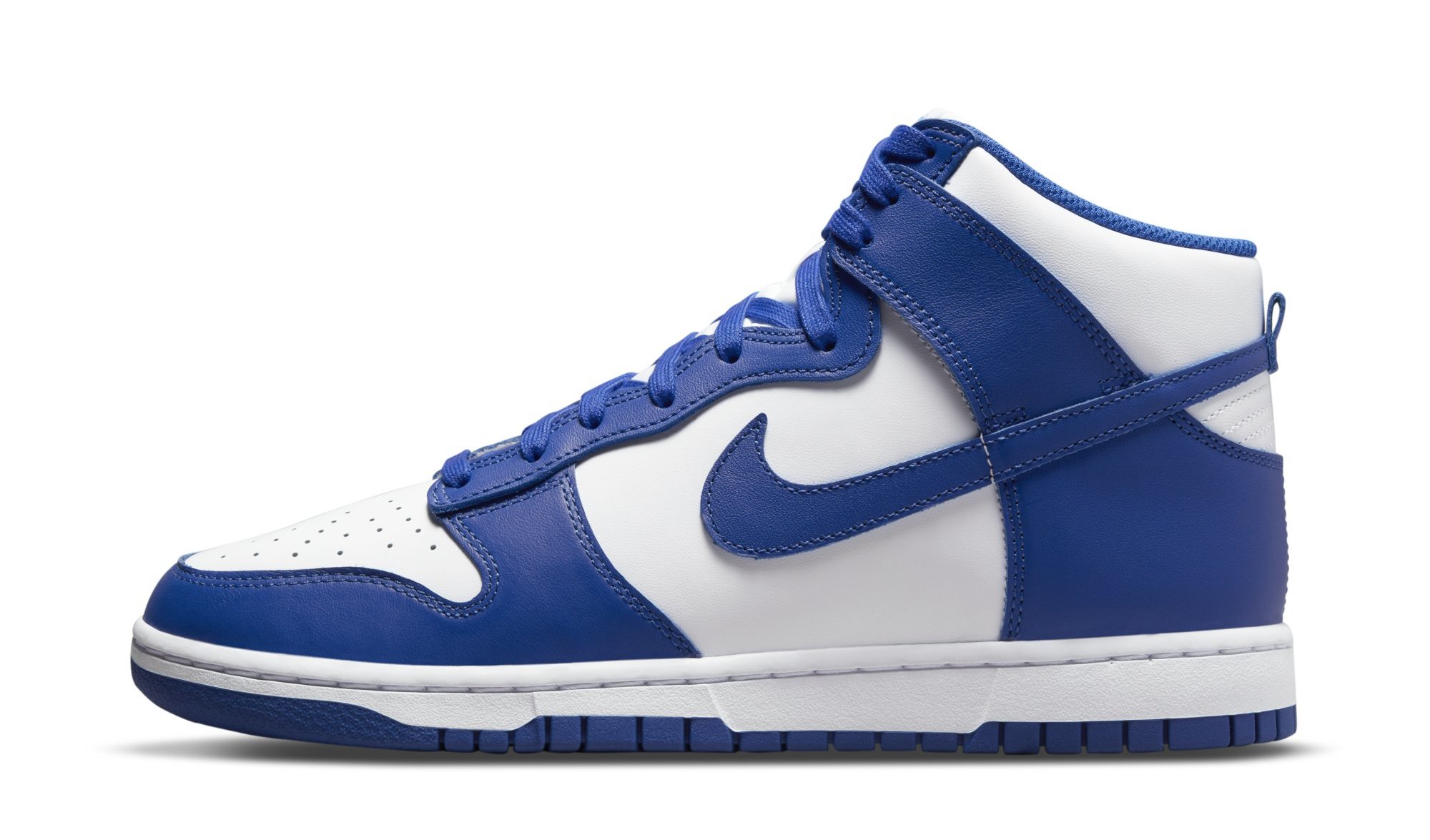
Year First Released: 1985
The Nike Dunk is the ultimate storytelling canvas in sneaker form. The Dunk’s ability to evolve and host some of the most creative applications of colors, materials, textures, and prints has cemented them as an immensely important shoe that has become a de facto voice of the people, telling athletes’, collaborators’, and artists’ stories since their initial launch in 1985.
The Nike Dunk changed the scale of sneaker and apparel releases from the very beginning. Its genesis was the product of a substantial campaign that infused D1 college colors onto the Dunk’s leather panels. This “Be True To Your School” collection featured seven original colorways in both high and low-top form as well as a supporting apparel line. Extra details like the Wildcat symbol on the tongue tag and a “CATS” graphic on the heel added to the theme for Kentucky Wildcats player editions.
Things were quiet for the Dunk until the mid-’90s when a budding vintage sneaker scene exploded in Japan. Wanted ads in newspapers offered “cash for sneakers” prompting readers to check their basements and attics for ‘80s Nike basketball shoes with a key focus on the Nike Dunk. This spark started an explosion of retro demand that helped inform Nike’s product line into the late ‘90s.
With the retro era fully underway by the late 2000s, the Dunk was a core component of Nike’s slate. It didn’t take long for suede, colored midsoles, grip-tape material, and fatter tongues bolstered by elastic to find their way onto Dunks. Design cues like stitched heel emblems found on the “NYC” Dunks and fabled “Wu-Tang” Dunks provided yet another flourish to the sneaker’s ever expanding design language. An evolution was taking place in the form of the Dunk Pro B and CO.JP releases—allowing a new generation to put their stamp on the shoe while paving the way for the Dunk SB.
The foundation of the skateboarding-specific Nike Dunk SB was built on the color stories of four of the original SB team members. Richard Mulder, Danny Supa, Gino Iannucci, and Reese Forbes all drew from personal inspiration to inform the material and color choices of their respective Dunks when the line officially kicked off in 2002. The SB line continued to gain momentum with a consistent stream of innovative colorways, collaborations, and use of new materials with the likes of Supreme, Zoo York, Chocolate, and a number of Nike SB team skaters. The Dunk SB was a trailblazer when it came to hyper-limited releases and artist collabs, creating a unique distribution system that made the sneakers only available to select SB account holders—sometimes with the additional caveat of being regional or event exclusives. Sneakers like the “Paris” Dunk that featured a unique print from French painter Bernard Buffet elevated the shoe to a work of art. In the mid-2000s this was all revolutionary stuff within the sneaker world.
The Dunk SB line hit a crescendo with releases like the “Diamond” and “Pigeon” Dunks in 2005, with chaos erupting during the Pigeon release that made headlines. A new hype-driven “gotta catch ‘em all” mentality had swept through the scene, drastically changing the way store releases were handled from then on.
As time went on and Dunks cooled off, a devoted group of enthusiasts kept the lights on until a new generation was ready to pick up where the previous one had left off. Momentum began to build in the late 2010s as celebrities like Travis Scott and Virgil Abloh dusted off pairs from a decade prior, reminding the masses of the depth and quality of the Dunk line while also backing Dunk releases of their own. The Dunk’s resurgence and consumer habits lined up perfectly with the SNKRS app era, as a host of new collaborations, colorways, and storytelling started to mount and Nike poured continuous energy into new releases. It’s somewhat ironic that a simple black and white colorway dubbed the “Panda” has become the Dunk of choice for the general public in 2022—but this only underscores the staying power of the sneaker as a lifestyle staple and proof that the Dunk format works, whether it’s dressed up with neon green fur or condensed down to its simplest form in two colors on leather. –Kevin Luyster
4. Air Jordan 3
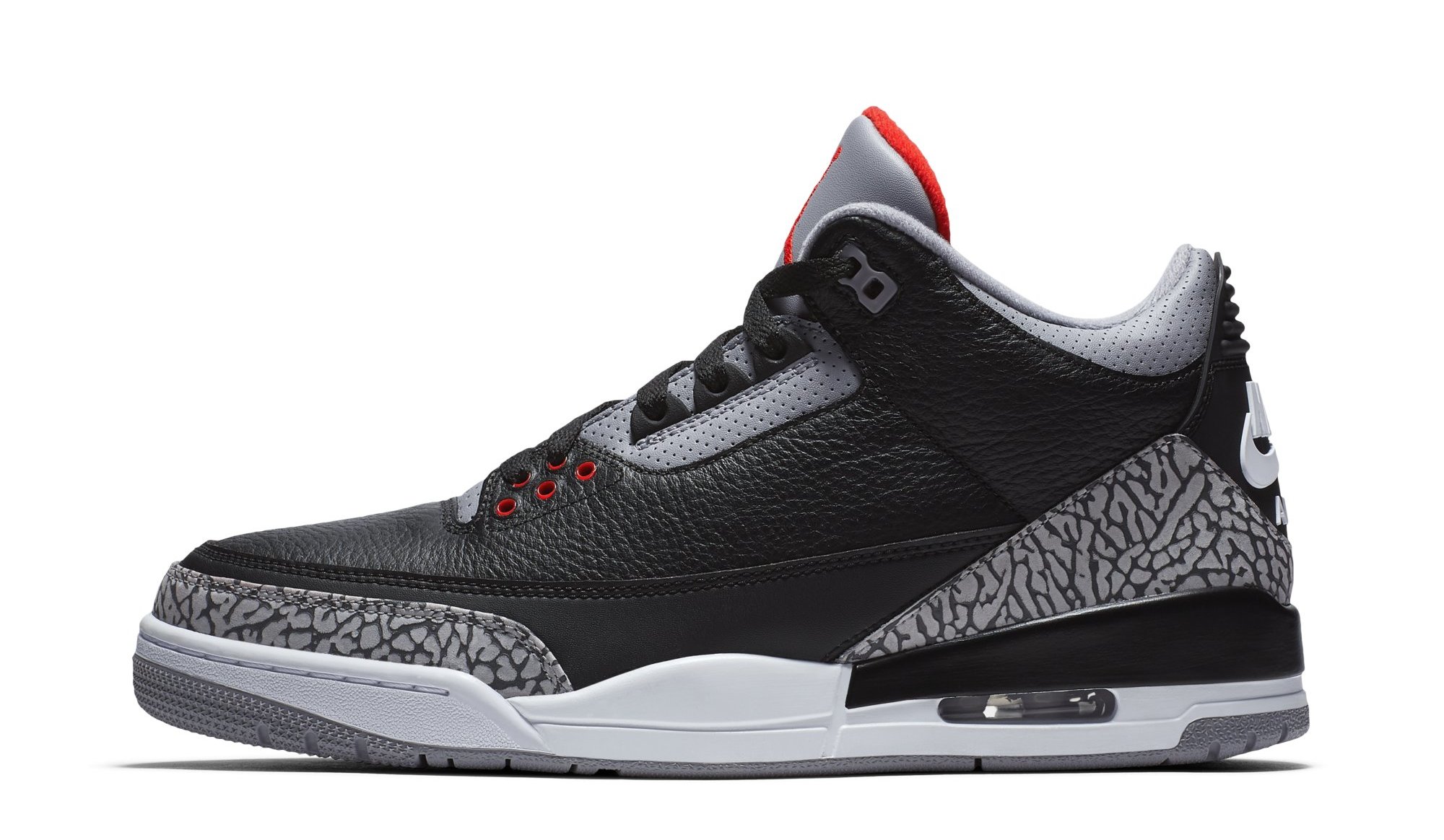
Year First Released: 1988
Sneaker culture—and the multibillion-dollar industry around it—might not even exist without the Air Jordan 3.
Tinker Hatfield’s back was against the wall going into the creation of the shoe in 1987. Michael Jordan was unhappy with his previous shoe, the Air Jordan 2 (designed by Peter Moore and Bruce Kilgore), after spending much of the 1985-’86 season sidelined with a broken foot sustained while wearing it. By all accounts, he was planning to leave the brand for Adidas, but it was in large part the Air Jordan 3 that swayed him to stay with the Swoosh.
“Phil Knight was pretty well convinced that Michael was gonna leave Nike,” Hatfield told ESPN in 2020. ”Phil was very, very concerned. I think he thought for sure we had lost him. There was this one last meeting.”
The meeting took place at an Orange County, California hotel where Hatfield, Knight, and Jordan’s family gathered to discuss the future of the sneaker line. After arriving late, Jordan cut to the chase.
“Michael was not in a great mood when we arrived,” Hatfield said in a 2018 Jordan Brand interview. “He said ‘Show me what you got.’ I had the shoe there under a black cloth, like a shroud. You couldn’t really see very well what the design was like but he had already seen some of the stuff in the two previous meetings. When I picked the [Air Jordan 3] up, Michael grabbed it from me and started looking at it. Within a few minutes he was smiling and asking all kinds of questions. Within 20 minutes, the meeting was pretty much over.”
The Air Jordan 3 is a widely beloved classic today, but the shoe that Hatfield presented to MJ in the meeting was unlike anything around at the time. The Air Jordan 2 came in all white-based colorways. Hatfield signaled a shift by coming out of the gate and showing Jordan the “Black/Cement” make-up. Some of the designer’s early sketches featured a Swoosh on the shoe, but the upper was ultimately kept clean and devoid of side branding. Instead, it introduced a whole new logo, the Jumpman, which replaced the Wings stamp from the Air Jordan 1 and Air Jordan 2 and would go on to become the franchise’s signature emblem. And then there was the elephant print, a pattern that Jordan and Hatfield had discussed in a previous meeting that became one of the 3’s standout details.
Jordan stuck with Nike and began wearing the Air Jordan 3 toward the end of 1987, but it wasn’t until the following year that the shoe released to the public and had its defining moments. During the 1988 NBA All-Star Weekend’s dunk contest, Jordan laced up the “White/Cement” colorway and took off from the free-throw line, besting Dominique Wilkins for the trophy in a close match up. The next night, he wore the “Black/Cement” pair during the All-Star Game, dropped 40 points, and won Most Valuable Player.
Along with the Air Jordan 1 and 2, the Air Jordan 3 was one of the first models in the line to receive a retro. In 1994, Nike reissued the “Black/Cement” and “White/Cement” colorways. The sneaker wasn’t rereleased again until 2003, then again in 2007. Since then, it’s more or less been a mainstay of Jordan Brand’s retro lineup aside from a brief discontinuation in 2014.
Its original colorways remain its most popular, but the Air Jordan 3 has seen plenty of well-received new renditions, collaborations, and unreleased friends-and-family styles in its 30-plus-year history. Some of the most notable non-OG pairs include Oregon’s PEs, DJ Khaled’s collabs, the A Ma Maniere collab, and Nipsey Hussle’s promo “Victory Lap” version. –Riley Jones
3. Nike Air Max 1
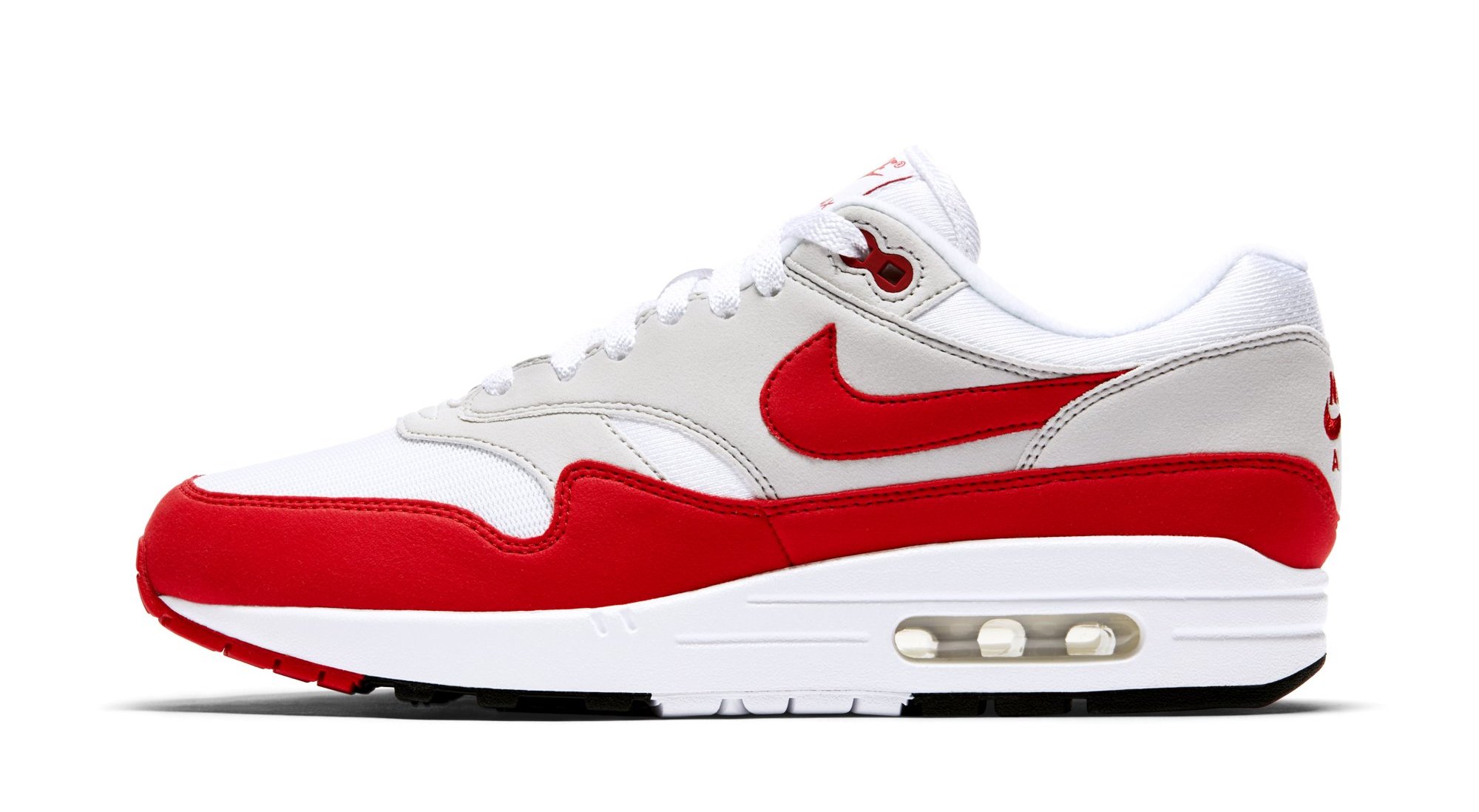
Year First Released: 1987
In 1978, Nike released the Air Tailwind, a running shoe infused with its new Air cushioning system. The innovation was the idea of an aerospace engineer named Frank Rudy, who presented Nike co-founder Phil Knight with the then-radical concept of the gas-filled urethane pouches a year earlier. The groundbreaking technology became the company’s most important innovation and would be used in models such as the Air Force 1 and Air Jordan.
About three years after introducing Air, Nike hired Tinker Hatfield as a corporate architect. Hatfield spent his first four years with the company designing office space, showrooms, and stores. He was then asked to consider designing sneakers, an opportunity he jumped at because it was a new challenge and he could work his architectural background into footwear development.
The first high-profile project Hatfield was presented with was the Air Max, which would be included in an “Air Pack” along with models such as the Air Trainer 1, Air Sock, Air Revolution, and Air Safari. He believed that Nike had grown a little complacent with design and that people were in search of something new. He then recalled trips he had taken to Paris, where he visited Centre Pompidou, a complex building designed to give spectators a view of its inner workings while standing outside. Hatfield was inspired to carry this concept of openness over into footwear design.
In the years leading up to Air Max, Nike had been trying to find a way to enlarge its encapsulated Air bags. Hatfield, applying Centre Pompidou’s exposed concept, designed a midsole with cut-out windows that would make the bags visible. After all, most consumers had no idea what Air actually was, and this potential breakthrough in technology was also an opportunity to appeal to their curiosity and desire for understanding. “Why not just show it?” thought Hatfield.
The development of visible Air wasn’t without its critics. Hatfield faced pushback internally at Nike, much as the Centre Pompidou design team received from the world of architecture. “When you do something different, you have to have a pretty thick skin,” said Hatfield during an interview in the series Respect The Architects. “People are going to take shots at you. They’re going to criticize what they don’t understand.”
Hatfield said people at Nike, including the head of marketing for running, were unhappy with the concept of visible Air and felt it left the shoe “too vulnerable.” Some Nike officials were even opposed to the launch colorway of the Air Max, which featured a bright red overlay inspired by Centre Pompidou’s vibrant exterior.
In 1987, the Nike Air Max was officially released, complete with the eye-catching red colorway and visible Air design. “I wanted to push it as far as I could possibly push it without being fired,” said Hatfield. The model would spearhead one of Nike’s most important lines of footwear and visible Air crossed over to sneakers made for athletes such as Michael Jordan, Bo Jackson, Ken Griffey Jr., Penny Hardaway, and LeBron James. A staple of Nike’s business on every level for more than 35 years, Air Max has maintained its standing as arguably the brand’s most popular innovation. Today, Nike celebrates Air Max Day annually on March 26, the day the original Air Max launched. –Brandon Richard
2. Nike Air Force 1

Year First Released: 1982
It’s hard to imagine nowadays, but the Air Force 1’s story nearly ended just after it began.
Introduced as a high-top in 1982, and followed by the release of its low-top form in 1983, the Air Force 1 was Nike’s first basketball shoe to use the brand’s signature Air cushioning technology. Despite being groundbreaking in that regard, Nike planned to put an end to the sneaker’s production in 1984. However, due to its popularity in Baltimore, owners of the city’s Cinderella Shoes and Charley Rudo Sports stores urged the sportswear brand to keep releasing the shoe.
“It was [Charley Rudo Sports owner] Harold Rudo and myself who came up with this idea of resurrecting the Air Force 1,” Cinderella Shoes owner Paul Blinken said in a video retrospective. “They thought we were fucking crazy. They said, ‘But I believe in you guys.You guys are crazy enough to ask for it, we’re crazy enough to make it.’ We were forced to take 1,200 pairs of each color: a white/royal blue and a white/chocolate brown. We took ‘em, we sold ‘em right out.”
This success led to the “Color of the Month” program which, saw new color-ups of the Air Force 1 High hit the stores on a monthly basis. Retailer Downtown Locker Room eventually got involved, and soon Baltimore was a must-visit destination for people seeking sneakers from areas like New York and Washington, D.C.
Nike had been swayed, and the Air Force 1 continued to release sporadically throughout the mid-to-late ‘80s. It became ubiquitous on basketball courts and street corners, maintaining its presence on the East Coast. It was embraced by hip-hop artists and visionary designers like Dapper Dan, who applied high-fashion prints from brands like Gucci and Louis Vuitton to the shoe’s panels.
By the time the early ‘90s hit, the Air Force 1 was much more commonplace. This is also the period when the white-on-white Air Force 1 Low, widely considered to be the most important version of the sneaker, started showing up in stores. Keeping a crisp pair of white AF1s in rotation was a must, to the point where some collectors, like DJ Clark Kent, were known for only wearing a pair a single time before moving on to a fresh one.
The Air Force 1 became a full-on cultural phenomenon in the 2000s. Nelly’s 2002 single “Air Force Ones” was proof that the trend had extended far beyond the I-95 corridor. NBA star Rasheed Wallace played in them night in, night out—so much so that Nike started making him special-edition versions.
In Japan, the Air Force 1’s popularity led to a new kind of adoration. Nigo’s A Bathing Ape brand created a spinoff of the sneaker known as the Bape Sta, a shoe which was immensely popular in its own right and led to dozens of other imitators. This Air Force 1 knockoff phenomenon still takes place today and has led to Nike filing a number of lawsuits for trademark infringement—including one against Bape in January 2023.
The Air Force 1 had something of a full circle moment in 2022 when late designer Virgil Abloh’s Louis Vuitton collaboration was released. The shoes were largely inspired by the aforementioned customs of the ‘80s and represented Abloh’s aim to combine the worlds of hip-hop, streetwear, and high fashion.
To date, the Air Force 1 has been released in countless colorways, material variations, shapes, and sizes. There are Air Force 1 boots and Air Force 1 mules. There have been collaborations with partners ranging from small boutique shops to one of the world’s biggest fashion houses. Nike’s released Lux crocodile variations that retailed at $2,000. Keeping your white-on-white Air Force 1s clean has even become passé in some circles. It’s a shoe that has literally seen it all and remains an icon.
“It’s completely not a shoe,” Abloh told Financial Times months before his death. “It’s an art object. It doesn’t even need to be on someone’s feet.” –Riley Jones
1. Air Jordan 1
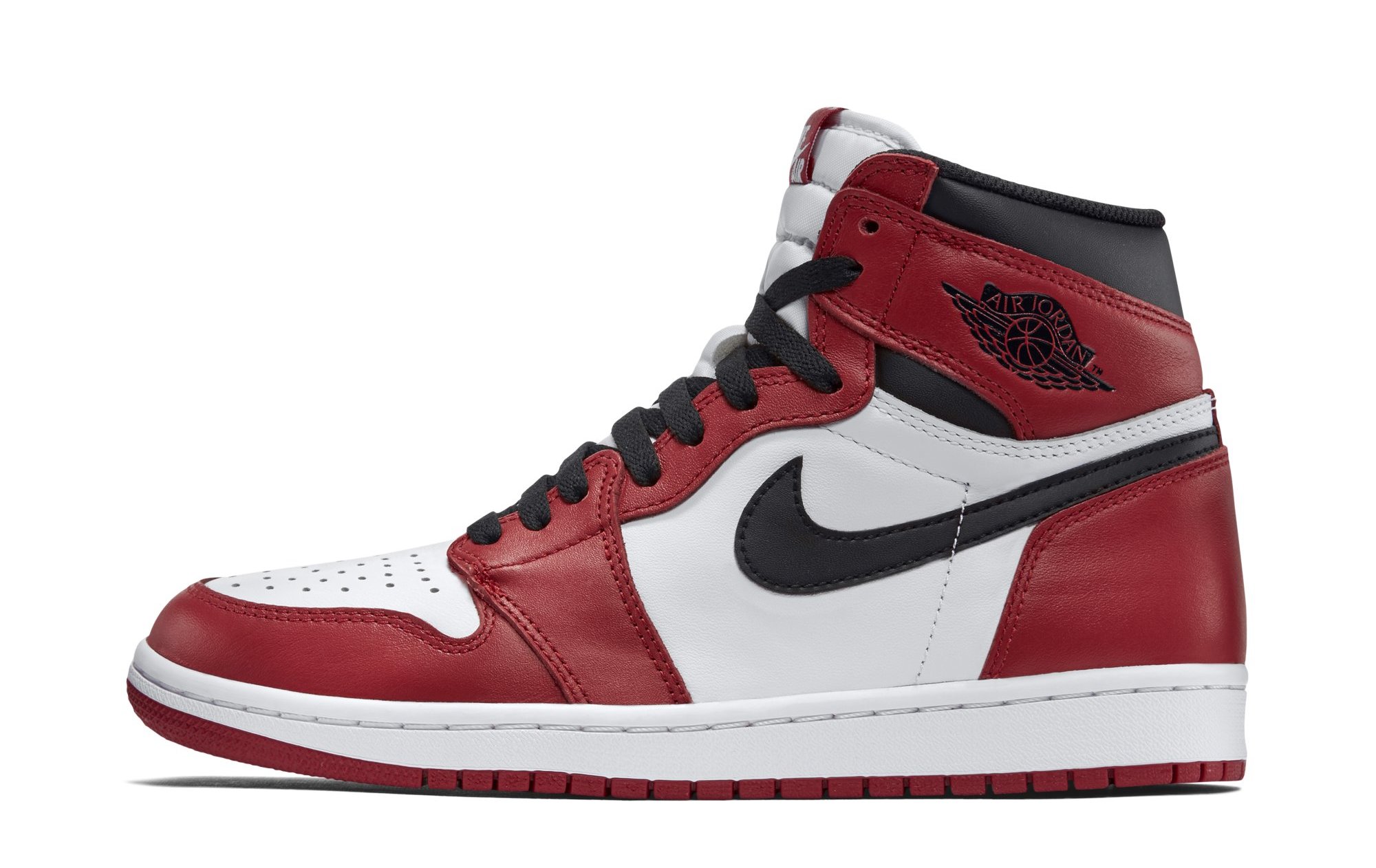
Year First Released: 1985
There’s not much that can be said about the Air Jordan 1 that hasn’t been said already. Everyone knows the story: Michael Jordan was selected by the Chicago Bulls with the third pick in the 1984 NBA Draft out of the University of North Carolina. He wanted to sign with Adidas, but the company was focused on big men at the time. Nike co-founder Phil Knight and legendary footwear deal man Sonny Vaccaro signed Jordan to a five-year deal and the rest was history.
The first shoe of his line, the Air Jordan 1, was done by the legendary late designer Peter Moore, who did other sneakers such as the Nike Dunk and later went to Adidas and rebranded that company in the early ‘90s. The Jordan 1 is very similar to the Dunk, with one of its greatest differences being Jordan’s Wings logo on the upper.
One of the biggest points in the Jordan 1’s history was it being “banned” by the NBA due to the black and red colorway not having enough white on the sneaker, part of the league’s rules at the time. Sadly, this was a marketing myth made up by Nike. The shoe that was actually banned by the NBA wasn’t the Jordan 1 at all, rather it was the Air Ship, a shoe that Nike and Jordan have been quiet about, even up to its first retro ever in 2021. It seemed more like Jordan was doing as little as possible to acknowledge the role the Ship played in the brand’s history and more so quietly re-releasing to keep its die-hards happy.
The Jordan 1 came in well over 20 original variations, so many that there are still questions about how many different versions were made. They went on sale for cheap, even though the original retail price was $65 in 1985, and were worn by skaters, a theme revisited by Jordan Brand via its collaboration with Nike SB and Lance Mountain in 2014.
It was also the first Air Jordan shoe to retro, when it came back out in 1994, then again in 2001, and a multitude of times since, to where it’s currently just part of the brand’s ongoing lineup.
It’s worn by people from all walks of life. NBA players, artists, models, TikTokers, and suburban moms and dads. Limited pairs like collaborations with Solefly, Colette, and Travis Scott are coveted by collectors, just as the versions that come out by the hundreds of thousands, such as 2022’s “Lost and Found” Air Jordan 1.
There’s an Air Jordan 1 for everyone: for the OGs, the younger generation, the hypebeasts, those who prefer low-tops, and those who want more comfort. It’s been almost 40 years since the Air Jordan 1 first released and it will likely maintain its popularity for the next 40. –Matt Welty
SHARE THIS STORY
